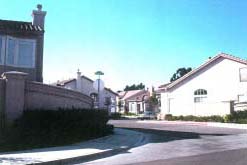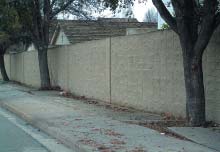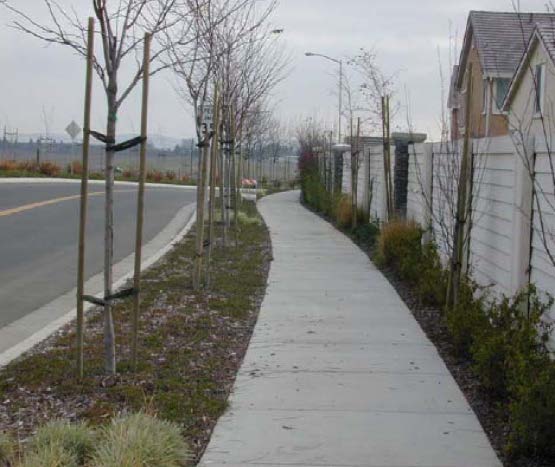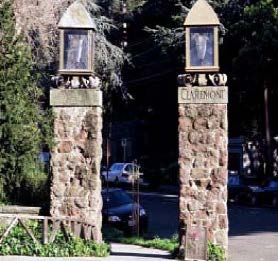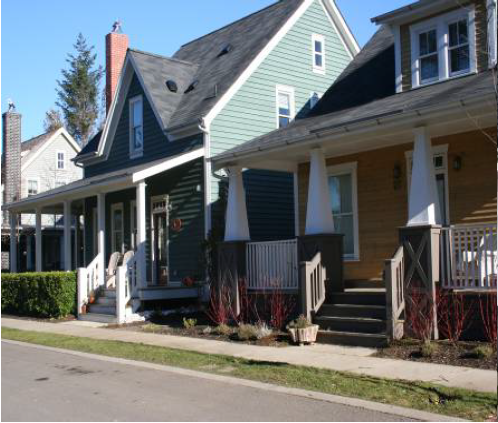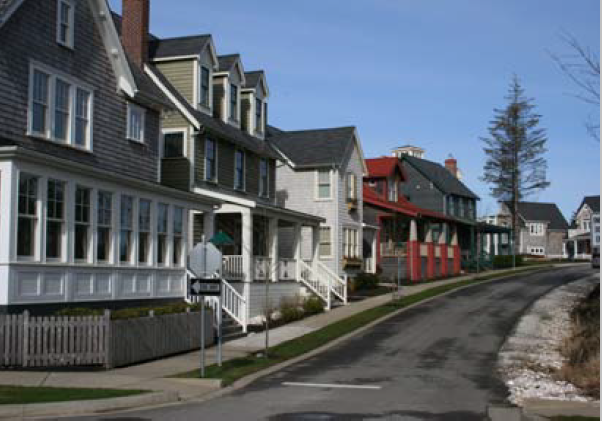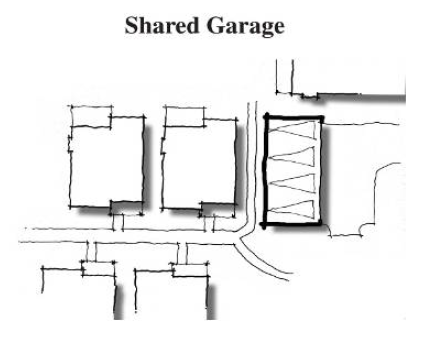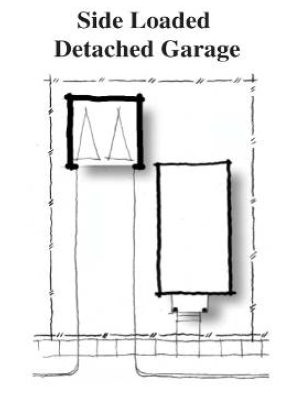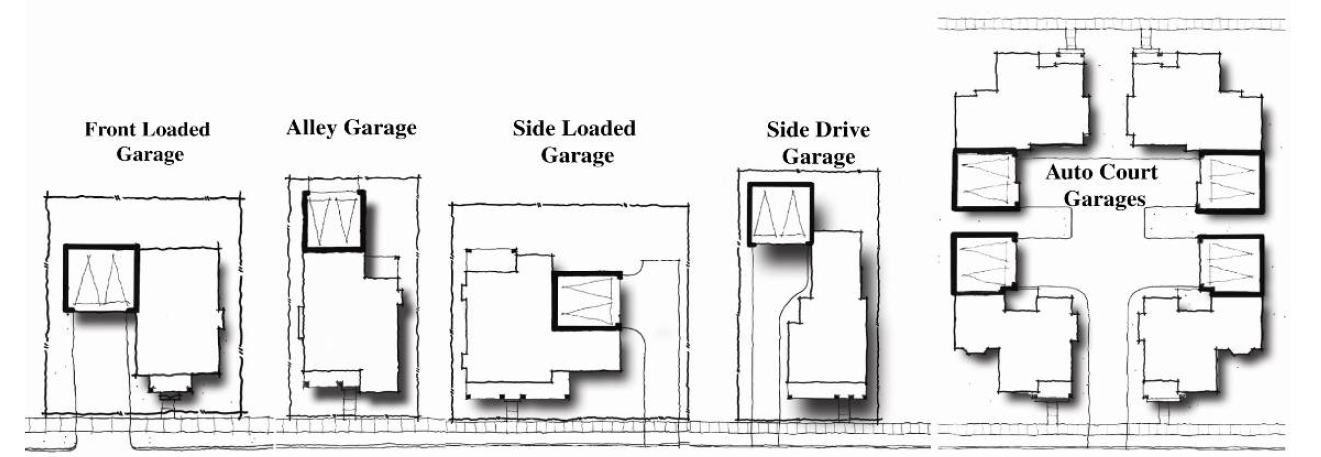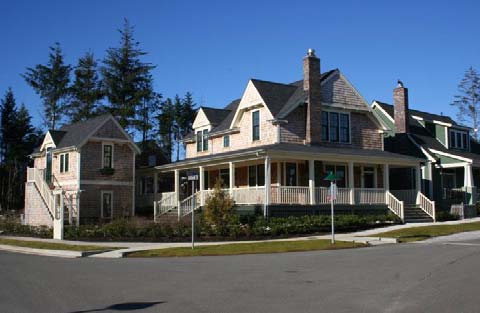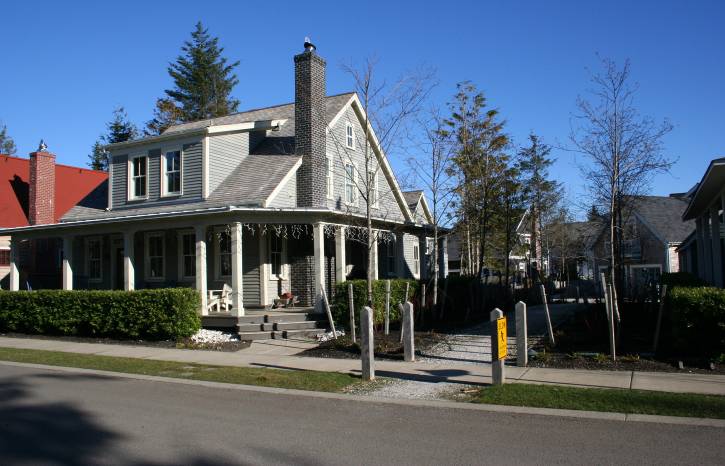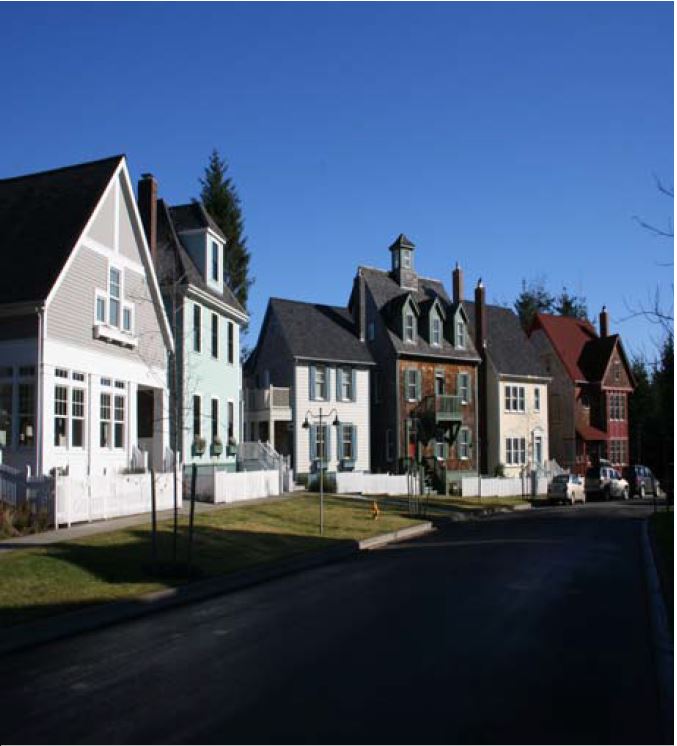Chapter 19.53
DESIGN STANDARDS AND GUIDELINES FOR SMALL LOT AND MULTIFAMILY DEVELOPMENT
Sections:
Article I. General Provisions
Article II. Introduction
19.53.060 Purpose and objectives.
19.53.070 Applicability and use types.
19.53.080 Design review process.
19.53.090 Organization of the document.
Article III. Design Goals and Concepts
19.53.120 Overall design goals.
19.53.130 Neighborhood design concepts.
19.53.140 Low impact development concepts.
Article IV. Small Lot and Multifamily Design Standards
19.53.160 Small lot and multifamily developments – Purpose and organization.
Article IV-A. Small Lot Developments
19.53.170 Purpose and organization.
19.53.180 Site planning and design.
Article IV-B. Multifamily Developments
19.53.210 Purpose and organization.
19.53.220 Site planning and design.
Article V. Landscape Design Standards and Guidelines
Article VI. Appendices
19.53.260 Checklist for small lot projects.
19.53.270 Checklist for multifamily development residential projects.
19.53.280 Checklist for landscaping and planting requirements.
Article I. General Provisions
19.53.010 Purpose.
The purpose of this chapter is to establish design standards and guidelines that will apply to specific types of residential development, including small lot and multifamily development.
(Ord. 607 § 1 (Exh. A), 2012; Ord. 559 § 6 (Exh. A), 2009).
19.53.020 Authority.
The provisions of this chapter shall augment and/or supersede existing regulations in this title. When provisions included in these design standards and guidelines conflict with other requirements of this title, these standards and guidelines shall apply unless otherwise provided.
(Ord. 607 § 1 (Exh. A), 2012; Ord. 559 § 6 (Exh. A), 2009).
19.53.030 Applicability.
A. The standards and guidelines adopted pursuant to this chapter shall apply to:
1. All new small lot development located within the R1 and R2 districts.
2. All new multifamily development located within the MF-L, MF-H and MU-M districts, except vertical mixed use buildings that include multifamily units in the MU-M zone, is exempt from these provisions and subject to compliance with the mixed use design standards adopted by reference in Chapter 19.50 UPMC.
3. Major modifications to small lot and multifamily development previously authorized pursuant to this chapter.
B. The following standards and guidelines adopted pursuant to this chapter shall apply to major improvement and major redevelopment of multifamily development, as defined in Chapter 19.10 UPMC.
1. Design Element 1: Site Planning and Design – MF5 Accessory Structures and MF6 Signage.
2. Design Element 2: Building Design.
3. Design Element 3: Lighting Design.
4. Landscape Design Standards and Guidelines.
(Ord. 628 § 1 (Exh. A), 2013; Ord. 607 § 1 (Exh. A), 2012; Ord. 559 § 6 (Exh. A), 2009).
19.53.040 Review process.
Design standard review is required for development that is subject to compliance with the adopted standards and guidelines. The City shall review applications in accordance with Chapter 19.85 UPMC.
(Ord. 741 § 1 (Exh. J), 2020; Ord. 607 § 1 (Exh. A), 2012; Ord. 559 § 6 (Exh. A), 2009).
Article II. Introduction
19.53.050 Introduction.
The Design Standards and Guidelines for Small Lot and Multifamily Development are adopted by the City of University Place to implement the goals and policies of the Comprehensive Plan. Specifically, these guidelines implement the City’s Comprehensive Plan land use policies relevant to urban design, pedestrian circulation, neighborhood and community identity, housing choice and residential design. The design standards and guidelines supplement UPMC Title 19 zoning regulations and will be used by the City to evaluate design review applications for qualifying small lot and multifamily projects.
Comprehensive Plan policies encourage a diversity of housing types that respond to market demand for a greater choice of housing options than is currently available in the community. An objective is to accommodate housing at moderately higher densities in specific areas of the City than has traditionally been constructed in single-family neighborhoods. The design standards and guidelines direct two such types of housing, small lot and multifamily development, to be built to high standards and achieve pedestrian-oriented designs that encourage interaction among neighbors. They also provide strategies to efficiently and effectively manage and protect the City’s existing natural systems, including water quality, habitat and biological resources, from the harmful effects of land development and stormwater runoff. The guidelines and standards are intended to ensure that low impact development components are integrated into the designs of future small lot and multifamily development. The goal is for this new housing to become a valued addition to the City’s existing residential neighborhoods and enhance the community’s positive identity.
(Ord. 559 § 6 (Exh. A § 1)).
19.53.060 Purpose and objectives.
The primary purpose of this document is to provide design professionals, property owners, residents, staff, and decision-makers with a clear and common understanding of the City’s expectations for the planning, design and review of small lot and multifamily development proposals in University Place.
The design standards and guidelines provide a framework to evaluate new development projects against the City’s objective to ensure that these projects are well designed, integrated compatibly into the neighborhood context, and contribute to an enhanced community aesthetic.
These guidelines are intended to do the following:
A. Provide a basis for making fair and consistent decisions in design review;
B. Ensure compatibility of new homes within existing neighborhoods;
C. Provide incentives for investment;
D. Enhance property values; and
E. Serve as a design tool and reference document for residents, designers, property owners, staff and decision-makers.
(Ord. 559 § 6 (Exh. A § 1(A)).
19.53.070 Applicability and use types.
A. The design standards and guidelines apply to “small lot” single-family and “multifamily” developments. “Small lots” typically are those less than 6,000 square feet, and small lot developments encourage diversity in the size of dwelling units by promoting and preserving smaller homes on smaller lots. “Multifamily” buildings are designed for occupancy by three or more families in three or more dwelling units, and multifamily developments can be designed to accommodate rental or owner-occupied units. The standards and guidelines apply to new small lot developments in R1 Residential and R2 Residential zones and new multifamily developments in Multifamily Low (MF-L) and Multifamily High (MF-H) zones. They will also apply to infill single-family dwellings on existing substandard lots of record and qualifying modifications to existing small lot and multifamily development. Provisions are organized by and based on development type, rather than zoning designation.
B. For a complete listing of qualifying and exempt residential projects, see UPMC 19.53.030.
C. Qualifying residential projects will be subject to design standard review in accordance with UPMC 19.85.050 to ensure conformance with the design standards and guidelines. In some cases, design provisions are mandated and in other cases there is more flexibility in how a project can meet a particular design objective. Generally, the following rules apply to language used in Articles IV and V of this chapter:
1. “Shall” or “must” indicates a design standard and means that conformance is mandatory.
2. “Should” or “encouraged” means the guideline is intended to be a recommendation about how to implement the goals of the design standards and guidelines.
D. The design standards and guidelines shall be used in conjunction with other documents adopted by the City that contain goals, development parameters, and more specific regulations relative to a development. Projects shall comply with applicable provisions of the Comprehensive Plan, zoning code and other municipal code requirements. When provisions included in the design standards and guidelines conflict with other requirements of this title, these standards and guidelines shall apply unless otherwise provided.
(Ord. 741 § 1 (Exh. J), 2020; Ord. 559 § 6 (Exh. A § 1(B))).
19.53.080 Design review process.
One of the paramount goals of the City’s Comprehensive Plan is to retain or create the qualities that comprise livable, memorable and diverse community life. Zoning and other numerical standards and formulas are inadequate tools, by themselves, for building a livable community in that they cannot ensure quality of physical design. Design review is intended to be a complementary means of retaining, enhancing, or creating a sense of community through its physical structures. Design standard review (UPMC 19.85.050) is a discretionary process established to determine the compliance of a development proposal with applicable design standards and guidelines. The design standard review process ensures that there is a harmonious balance between the natural and built environments in a community. It is also used to ensure quality development in accordance with the City’s design objectives and to ensure that the appearance of development will be compatible and harmonious with the use and enjoyment of surrounding properties.
Applicants should review this document’s stated purpose and objectives, design goals and concepts section, and design standards and guidelines section, to understand the rationale and spirit of the guidelines. Applicants should contact the City early in the project planning and design process to determine application and processing requirements and discuss key issues particular to a specific site.
(Ord. 741 § 1 (Exh. J), 2020; Ord. 559 § 6 (Exh. A § 1(C))).
19.53.090 Organization of the document.
The Design Standards and Guidelines for Small Lot and Multifamily Development document is structured into the following articles:
A. Article II, Introduction.
B. Article III, Design Goals and Concepts.
C. Article IV, Small Lot and Multifamily Design Standards.
D. Article V, Landscape Design Standards and Guidelines.
Article III introduces overall design goals and design concepts. Article IV includes specific standards and guidelines that meet the design goals and implement the neighborhood design concept. Article IV is organized into separate sections for small lot residential development and multifamily development. For each residential use type, there are key design components with specific approval standards and corresponding design guidelines to meet the City’s design objectives. Graphics and photos are used throughout Article IV to illustrate design objectives, but are not intended to depict the only design solution to a specific criterion or guideline. Article V includes standards and guidelines for landscape design that is common to small lot and multifamily projects. This document also includes appendices for definitions of special terms used (see UPMC 19.53.100), a checklist for small lot development applications, and a checklist for multifamily development applications.
(Ord. 741 § 1 (Exh. J), 2020; Ord. 559 § 6 (Exh. A § 1(D))).
19.53.100 Definitions.
Articulation: The way portions of a building form are expressed (materials, color, texture, pattern, modulation, etc.).
Authentic architectural style: Architecture that encompasses many styles within an architectural theme, a holistic approach. Possessing appropriate architectural characteristics, massing, and detail consistent with a specific architectural style.
Canopy: A roofed structure constructed of fabric or other material placed to extend outward from a building providing a protective shield for doors, windows, and other openings, supported by the building and supports extended to the ground directly under the canopy or cantilevered from the building.
Compatible: Capable of existing together without conflict or detrimental effects.
Cornice: A continuous, molded projection that crowns a wall or other construction, or divides it horizontally for compositional purposes.
Deck: An open, unroofed porch or platform extending from a house or other building.
Design elements: The individual visual components within an architectural composition.
Design guidelines: These minimum guidelines or recommendations are intended to guide the design of buildings, lighting, landscaping and neighborhoods. Where conditions are not specifically addressed in the guidelines, it is the responsibility of the proponent to show that the proposed design solution meets the intent of the most closely related guidelines.
Easement: The legal right to use a described piece of land for a particular purpose. It does not include fee ownership, but may restrict the owner’s use of the land.
Effective impervious surface: Those impervious surfaces that are connected via sheet flow or discrete conveyance to a drainage system. Impervious surfaces on single-family residences are considered ineffective if the runoff is dispersed through at least 100 feet of native vegetation.
Facade: The front or principal face of a building, a side of a building that faces a street or other open space.
Human scale: The size or proportion of a building element or space relative to the structural or functional dimensions of the human body. Used generally to refer to building elements that are smaller in scale, more proportional to the human body, rather than monumental (or larger scale).
Low impact development (LID): Low impact development (LID) is an innovative stormwater management approach with a basic principle that is modeled after nature: manage rainfall at the source using uniformly distributed decentralized micro-scale controls.
Massing: The three-dimensional bulk of a structure: height, width and depth.
Modulation: Means a stepping back or projecting forward of portions of a building face within specified intervals of building width and depth, as a means of breaking up the apparent bulk of a structure’s continuous exterior walls.
Natural grade: Natural grade is considered existing topography prior to proposed construction.
Pedestrian scale: The proportional relationship between an individual and his or her environment.
Privacy fence: A structure serving as an enclosure, a barrier, or a boundary, usually made of posts or stakes joined together by boards, wire, or rails.
Scale: The spatial relationship among structures along a street or block front, including height, bulk, and yard relationships. Proportional relationship of the size of parts to one another and to the human figure.
Standards: Minimum/maximum requirements based on quantifiable criteria.
Xeriscape: A landscaping method that employs drought-resistant plants native to the region in an effort to conserve resources.
(Ord. 741 § 1 (Exh. J), 2020; Ord. 559 § 6 (Exh. A § 5(A))).
Article III. Design Goals and Concepts
19.53.110 Purpose.
This article provides overall design goals and design concepts for the achievement of good urban design Citywide. Specific goals for each development type are provided in Article IV, followed by standards and guidelines to achieve the design goals. The standards are intended to mandate necessary design components in small lot and multifamily projects that will help to create or preserve good urban fabric. The guidelines are intended to encourage high-quality building and site design while allowing flexibility for designers on a site-specific basis.
(Ord. 559 § 6 (Exh. A § 2)).
19.53.120 Overall design goals.
The design standards and guidelines have been created to help protect and improve the existing character of University Place’s established residential neighborhoods. Overall design goals for small lot and multifamily developments are listed below.
A. Preserve and enhance the existing character of established residential neighborhoods by encouraging development that creates a strong community image and a harmonious appearance;
B. Promote new construction that respects and responds to the character of the surrounding built and natural environments and is compatible with existing and evolving residential neighborhoods’ site development patterns, mass and scale, and streetscape appearance;
C. Encourage new small lot and multifamily developments that balance diversity of style with respect for the surrounding context;
D. Decrease the visual prominence of the automobile and related facilities, such as streets, driveways and parking areas, in residential neighborhoods;
E. Encourage greater variety in housing types, housing choices, site planning and density mixes in order to provide more diversity and visual interest in the City’s residential development, while preserving the City’s predominantly single-family residential character;
F. Foster consideration of neighbors’ concerns regarding privacy, scale, massing and streetscape;
G. Provide design parameters for residential structures so that the projects are harmoniously integrated as they relate to the architecture in the vicinity in terms of colors and materials, scale and building design. Designs should be sensitive to and compatible with historic and architecturally significant buildings in the vicinity, and should enhance important community gateways and view corridors;
H. Encourage development that contributes to the character of University Place by establishing linkages to community focal points, such as open space, parks, schools and civic buildings;
I. Strengthen the pedestrian realm by encouraging landscaping and building elements, such as enhanced paving materials, accent lighting, streetscape furniture and adequate sidewalk space, which will contribute to pedestrian environments that are attractive and physically safe;
J. Maximize stormwater infiltration within developments and minimize the amount of stormwater that is transferred off site using LID techniques; and
K. Encourage new development that is urban, environmentally sustainable and energy efficient in scale, treatment and character.
(Ord. 741 § 1 (Exh. J), 2020; Ord. 559 § 6 (Exh. A § 2(A))).
19.53.130 Neighborhood design concepts.
University Place is an established community with existing neighborhoods that have a rich and diverse history. It is a primary objective of these guidelines to ensure that new small lot and multifamily developments are compatible with the adjacent homes and surrounding neighborhood. Information in this section is intended to explain the concept of neighborhood design.
A. What Is a Neighborhood? Neighborhoods are defined as a place with a character and a boundary. They are the strategic building blocks of a community. A neighborhood can be considered at two levels:
1. The immediate context or how the house or other residential structure relates to the adjacent houses and buildings (see Figure 19.53.130-1); and
2. The neighborhood context or how the house or other residential structure relates to the visual character and scale of other houses and buildings in the general vicinity (see Figure 19.53.130-2).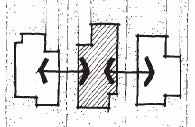
Figure 19.53.130-1
Immediate Context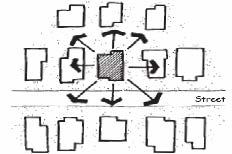
Figure 19.53.130-2
Neighborhood Context
B. What Are the Limits of a Neighborhood? For the purposes of these guidelines, neighborhood is defined as the block in which the subject property is located and the area of influence around the residence. For areas of the community that do not have an established block pattern, the neighborhood may be considered an area framed by arterial or collector streets, topographic or other natural features, or typified by one or more common characteristics. The nature of a neighborhood is often determined by the patterns shared between the houses and other structures that formed that neighborhood. These patterns or characteristics include similarities in mass, scale, complexity of form, topography, relationship to the street and to each other (see Figure 19.53.130-3).
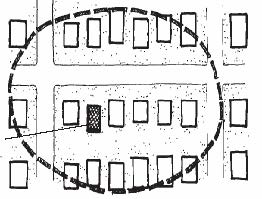
Figure 19.53.130-3
Immediate Neighborhood of This House
C. How Does a House or Other Residential Structure Contribute to the Neighborhood Character? The scale and mass, window and door patterns, roof and architectural style of a building all make up the character of the building. Following are some of the common architectural elements that contribute to the character of an individual house and other residential structures and the neighborhood:
1. General height and mass of buildings in the neighborhood;
2. General location of buildings on the street and the way those buildings meet the street – porches, walkways, landscaping;
3. Setback, parking and garage patterns;
4. Architectural style of a house or houses in a neighborhood;
5. Arrangement of major building forms;
6. Location of entries;
7. Roof forms;
8. Number of stories;
9. Materials;
10. Window type;
11. Landscaping;
12. Historic buildings or features;
13. Topography.
The City recognizes and values the unique characteristics of its existing neighborhoods. This section is not intended to dictate a single solution to every type of neighborhood development application. Rather, these guidelines introduce good neighborhood design concepts and general provisions that can be applied to varying degrees within the distinct types of neighborhoods throughout the City.
(Ord. 559 § 6 (Exh. A § 2(B))).
19.53.140 Low impact development concepts.
Low impact development (LID) is a more sustainable land development approach (compared with conventional designs) that begins with a site planning process that identifies critical natural resource areas for preservation. LID mimics a site’s predevelopment hydrology by using design techniques that infiltrate, filter, store, evaporate, and detain runoff close to its source.
Development patterns based on conventional zoning codes often result in “sprawl” with its associated large impervious areas, loss of natural resources and habitat, increase in nonpoint source pollution, and alteration of hydrologic systems. Conventional developments often start with clearing and leveling of the entire parcel. Construction of wide, paved roads and over-designed large parking lots typically follows. These sprawling impervious areas eliminate vegetation and prevent water from infiltrating into the ground (see Figures 19.53.140-1 and 19.53.140-2). The result is the conveying of polluted runoff to water bodies. In order to deal with stormwater that runs off these sites, structural controls such as catch basins, pipes, and detention ponds are used. Instead of “greenscapes,” conventional landscaping of these developments brings additional concerns including the introduction of non-native plants, use of herbicides, pesticides and fertilizers, and excessive water consumption.
The LID approach provides opportunities to build homes while conserving natural areas and drainage patterns. LID is accomplished as a two-step process; first – thoughtful site planning and, second – incorporation of “natural” stormwater best management practices (BMPs).
Thoughtful site planning begins with the identification of critical site features such as wetlands, habitat areas, or drinking water protection areas that should be set aside as protected open space. Natural features, such as vegetated buffers and view sheds, will also play an integral role in any LID planning exercise. After the critical open space areas are identified and set aside, sustainable development areas are then identified as “building envelopes.”
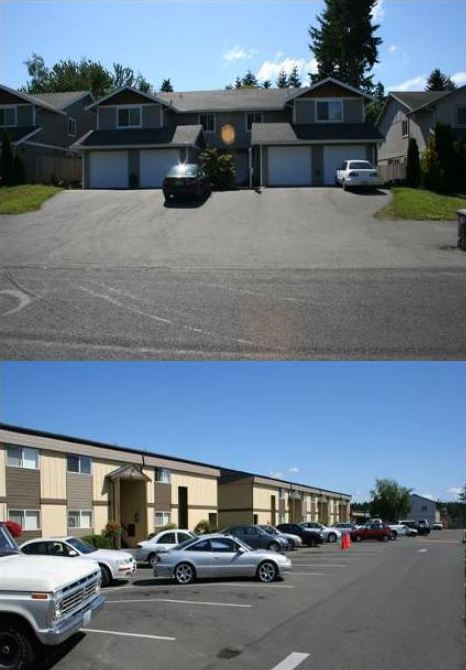
Figure 19.53.140-1
Large, impervious surfaces eliminate vegetation and prevent water from infiltrating into the ground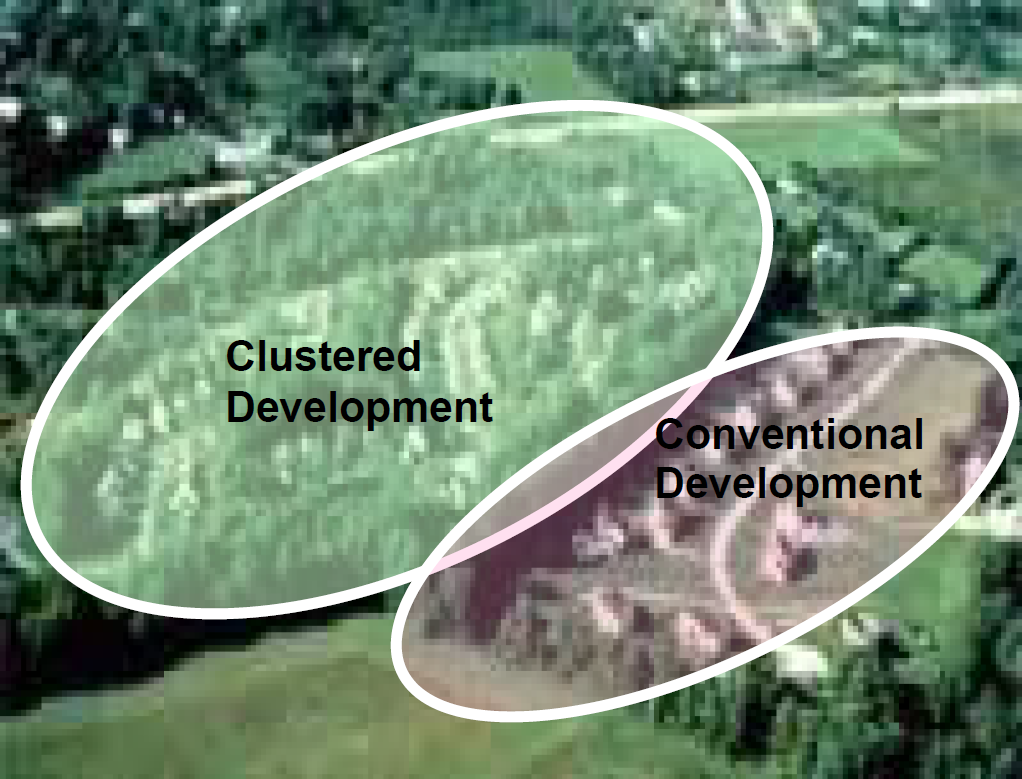
Figure 19.53.140-2
A clustered development with smaller setbacks and preserved natural areas (left) contrasts with a conventional subdivision where all the trees have been removed.
Within the delineated building envelopes, a broad range of design techniques or BMPs, such as shared driveways, permeable pavers, and bioretention, are used to reduce the level of impervious cover and improve the quantity and quality of stormwater drainage. Other LID design techniques include green roofs, roof rainwater collection systems, rain gardens, grassed swales, stormwater infiltration systems, and alternative landscaping. Through these techniques, natural drainage pathways are conserved, open space is preserved, and the overall impact from development is significantly reduced.
Often LID techniques provide benefits beyond those related to water and drainage. For example, green roofs also muffle noise by reducing reflective sound, mitigate “urban heat island” effects by creating microclimates that cool and humidify air in their immediate area, absorb dust and smog as well as nitrates and other aerosol contaminants from air and rainfall, and generally provide natural habitat for wildlife including birds, butterflies, and insects.
LID techniques implement development practices that are sustainable and can result in: multifunctionality, lower construction costs, environmental and social benefits, reduced off-site costs, more functional use of open space land, better integration of the built environment with the natural environment, reduced energy costs and increased property values.
Design guidelines in Articles IV and V related to LID are identified with a “” symbol.
(Ord. 559 § 6 (Exh. A § 2(C))).
19.53.150 Design elements.
Article IV. The design standards and guidelines in Article IV are organized into two housing type categories – small lot development and multifamily development, and three design elements for each housing type. This section explains the importance of each element in building stronger neighborhoods.
A. Site Planning and Design. Site planning and design standards and guidelines are intended to improve site planning to enhance the image of the City, reflect unique site characteristics, and provide strong neighborhood environments; promote a superior appearance for both small lot single-family and multifamily developments; minimize modifications to topography, preserving existing vegetation whenever possible; minimize the creation of impervious surfaces; create appropriate provisions for vehicular and pedestrian circulation; develop site plans that preserve and integrate healthy and mature existing trees into the overall development scheme to establish optimum environmental conditions by providing shade, air purification, management of stormwater runoff, etc.; protect natural site features, open space, and historic structures to the maximum extent possible in order to maintain the local character, and use and incorporate such features and areas as community amenities; and provide useable open space, or maintain significant natural areas, for the use and enjoyment by residents of the new developments.
The site planning and design section features the following subcategories:
1. Building siting and orientation;
2. Grading and stormwater management;
3. Lot standards;
4. Front yards/entrances;
5. Parking and garage placement and design;
6. Individual outdoor spaces;
7. Common open spaces;
8. Utility areas and accessory structures.
B. Building Design. Building design guidelines are intended to create and add to the visual interest of University Place’s streets; ensure quality and consistency in building architectural character and style; ensure compatibility with adjacent development, as applicable; avoid featureless building massing; provide building design details to reduce the visual scale of large multifamily buildings; achieve unity of design through the use of similar materials and colors; ensure use of building materials that are durable and attractive; encourage the provision of private open spaces for residents’ enjoyment; and ensure accessory structures are compatible in design with the primary buildings they serve.
Additions to existing structures should be designed to be compatible with the architectural style of the structure and surrounding neighborhood. Small lot residential buildings should be designed to avoid large, featureless facades. Multifamily developments should be designed to be compatible with surrounding single-family neighborhoods.
The building design section features the following subcategories:
1. Mass, scale and form;
2. Architectural style;
3. Facades and entries;
4. Roofs;
5. Materials and colors;
6. Windows and doors, porches and balconies;
7. Other design elements.
C. Lighting. Lighting guidelines are intended to eliminate adverse impacts of light spillover; provide attractive lighting fixtures and layout patterns that contribute to a unified exterior lighting design; encourage energy efficiency, and provide exterior lighting that promotes safe vehicular and pedestrian access to and within a development, while minimizing impacts on adjacent properties and the nighttime sky.
Article V. The design standards and guidelines in Article V apply to landscape design that is common to small lot and multifamily projects. Landscaping guidelines encourage designers to consider creative ways to screen and buffer unsightly uses; separate incompatible uses; enhance a project’s open space and buildings, reinforce streetscape character and respond to site and surrounding context.
The landscaping article features the following elements:
1. General landscape design;
2. Front yard landscape design;
3. Landscaping and planting requirements;
4. Parking area landscaping.
(Ord. 559 § 6 (Exh. A § 2(D))).
Article IV. Small Lot and Multifamily Design Standards
19.53.160 Small lot and multifamily developments – Purpose and organization.
Residential design standards and guidelines within this article apply to two types of residential development: (1) small lot developments, and (2) multifamily developments. The standards and corresponding design guidelines are organized by design elements described in UPMC 19.53.150.
(Ord. 559 § 6 (Exh. A § 3)).
Article IV-A. Small Lot Developments
19.53.170 Purpose and organization.
A. Small Lot Developments. Small lot developments are single-family residential projects on “small lots.” Small lot single-family development encourages diversity in the size of dwelling units by promoting and preserving smaller homes on smaller lots (see Figure 19.53.170-1). Small lot developments may include a mix of attached and detached units provided the number of attached units does not exceed one-third of the total units within a project.
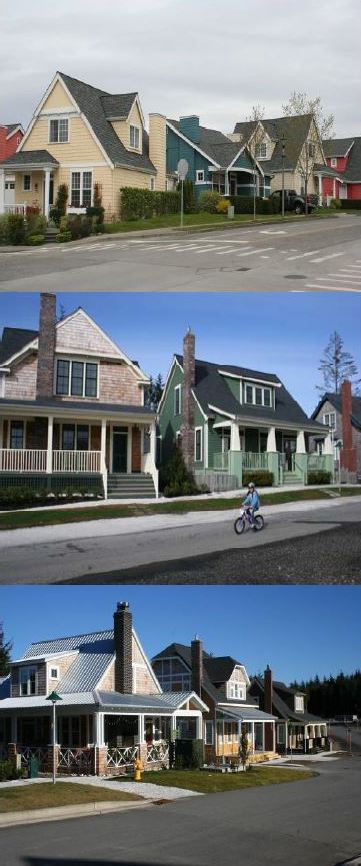
Figure 19.53.170-1
Single-family homes on small lots.
Top: Poulsbo Place; Middle and Bottom: Seabrook
B. Three design elements for small lot development are listed below. Each element includes specific approval standard(s) and corresponding design guidelines to ensure that small lot projects meet the City’s design expectations.
The standards and guidelines emphasize pedestrian-oriented streetscapes that are not dominated by garages, which includes improving the pedestrian qualities of neighborhood streets by addressing issues related to street-level uses: blank walls near sidewalks, sidewalks and street landscaping.
1. Design Element 1: Site Planning and Design.
2. Design Element 2: Building Design.
3. Design Element 3: Lighting.
(Ord. 559 § 6 (Exh. A § 3)).
19.53.180 Site planning and design.
A. SL1: Building Siting and Orientation.
Design Objective: To define the focus of activity that occurs at the front door or along the street and establishes a sense of community for a neighborhood by providing opportunities for people to gather. Building siting and orientation should encourage streetscapes that facilitate interaction among residents.
SL1.1. Approval Standards.
SL1.1.1. Site design elements shall display a clear and unified organization of building, landscaping and circulation elements that support the functions of the site. Site plans shall effectively demonstrate how the elements of the site relate to the street front and provide for compatibility with adjacent uses.
SL1.1.2. Placement of buildings shall consider the existing context of the surrounding area. Small lot developments shall respect privacy and solar access through appropriate siting of structures. Building setbacks around the perimeter of the site shall be consistent with the development standards of the underlying zoning district. Variation is permitted where the perimeter of the site abuts dedicated open space, stormwater facilities or railroad rights-of-way.
SL1.1.3. A pair of attached units shall be separated from another pair of attached units on the same block face by one or more detached units. Attached units on a street corner may be placed next to attached units on an adjacent street corner on the same block face if separated by an alley.
SL1.2. Design Guidelines.
SL1.2.1. Project elements (lots, buildings, access drives, parking, walkways, and service areas) should be located to protect, enhance, or minimize impacts to natural site features. For example, buildings should be designed to fit the natural slope, rather than forcing the slope to fit the building design. Terraced parking lots and multi-tiered buildings are other examples of effective design solutions that minimize impacts to a site’s natural features.
SL1.2.2. New developments should be integrated with the existing neighborhoods adjacent to them. Designs should avoid the separation caused by high, solid fencing and walls, or blank walls of buildings (see Figures 19.53.180-1 and 19.53.180-2). Traffic calming measures such as traffic circles, curb extensions and bulb-outs should be used where streets connect to existing neighborhoods.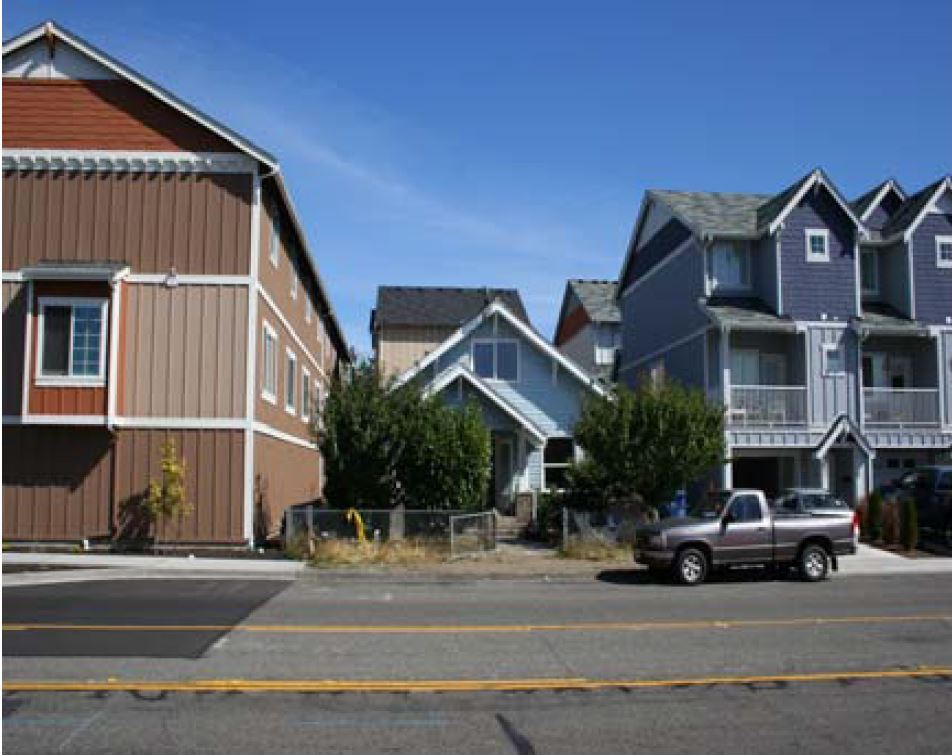
Figure 19.53.180-1
Poor transition: Newer multifamily homes surround an existing single-family dwelling, causing architectural disparity as well as loss of privacy for the single-family home
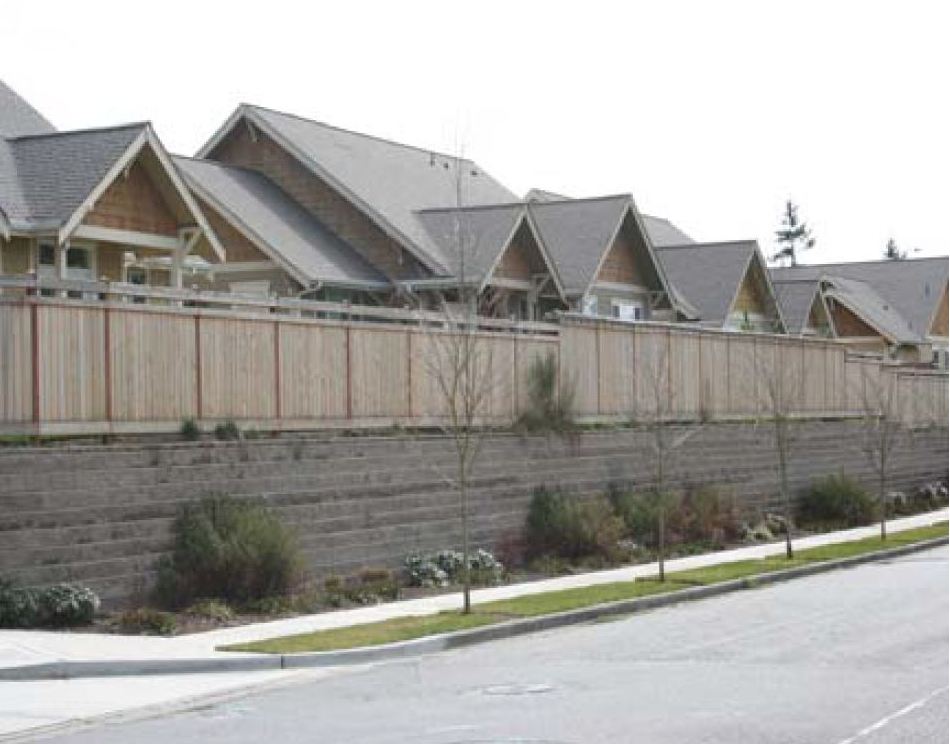
Figure 19.53.180-2
Undesirable Design: Houses separated from the street by high solid walls
SL1.2.3. Buildings should be oriented to the street to create an inviting streetscape. Interesting streetscapes promote pedestrian activity in and around the site. Buildings at or near the street can help create interaction between adjacent uses.
SL1.2.4. Small lot residential projects should provide one living/family/community living room at the front of the home facing onto the street (see Figure 19.53.180-3);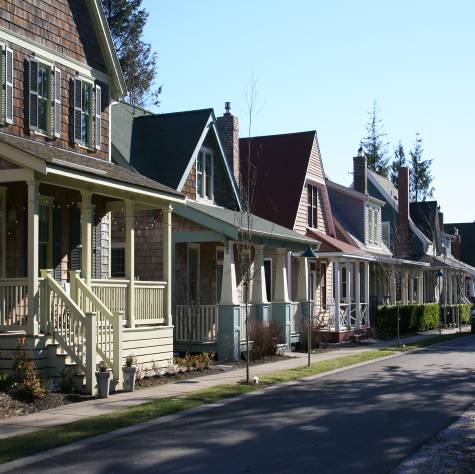
Figure 19.53.180-3
Single-family homes in Seabrook oriented to the street and sidewalk
SL1.2.5. Residential development adjacent to designated open space areas should maintain visual access to the open space from residential units, common buildings, and/or streets (buildings should not back up to open space areas creating areas hidden from public view). Projects should also provide for future connections to currently undeveloped properties via public or private streets, internal drives and biking and walking trails (see Figure 19.53.180-4).
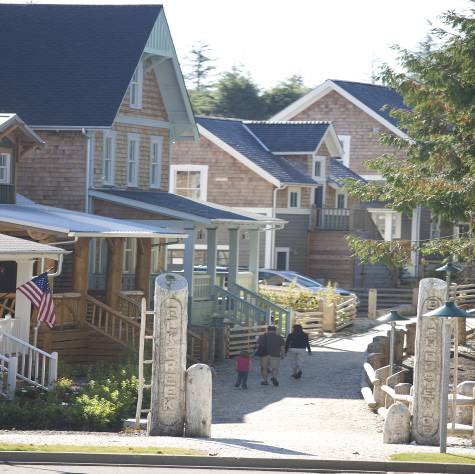
Figure 19.53.180-4
Single-family homes in Seabrook oriented to internal pedestrian trail
SL1.2.6. Buildings may be oriented to open space areas, provided that street frontages are developed consistent with guideline SL1.2.3 (see Figure 19.53.180-5).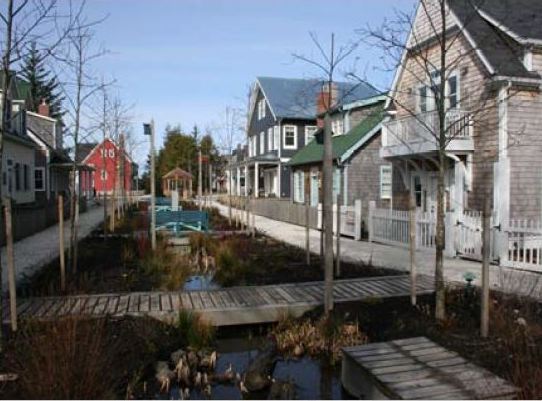
Figure 19.53.180-5
Single-family homes in Seabrook oriented to linear park stormwater feature
SL1.2.7. Perimeter residences that are part of new developments should be oriented to existing streets, minimizing the extent of sound walls or rear yard walls, except where necessary due to acoustical requirements (see Figures 19.53.180-6 and 19.53.180-7).
|
|
|
Figure 19.53.180-6 Undesirable: Sound walls and entry features designed to separate developments or neighborhoods |
|
|
|
Figure 19.53.180-7 Desirable: Walls should have a rhythm rather than a single monotonous design along the entire length. Landscaping and periodic entries or gateways soften appearances of walls, minimize driving and walking distances and integrate bike paths along the major roads. |
SL1.2.8. Increase privacy on adjoining properties by employing the following techniques:
a. Locating/reorienting direction of windows or decks to minimize views directly into adjoining structures and outdoor gathering places (see Figure 19.53.180-8). 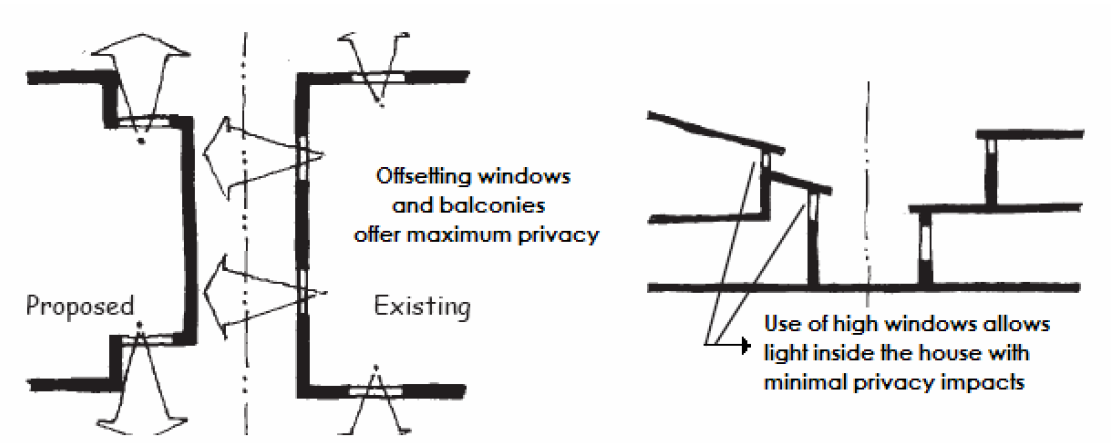
Figure 19.53.180-8
Techniques to reduce privacy impacts and increase solar access
b. Use structural features (e.g., raised planter boxes on parapet walls, nontransparent glazing) to restrict view angles to long rather than short distance view (see Figure 19.53.180-9). 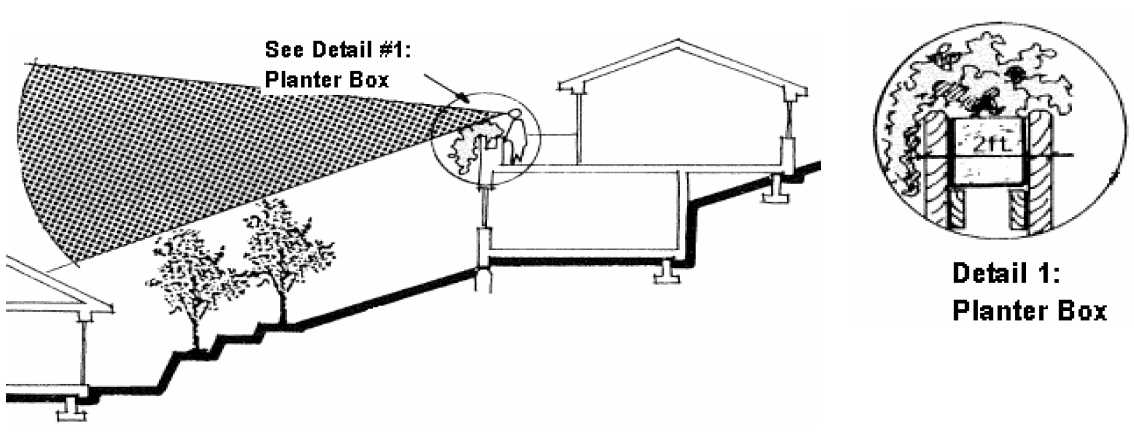
Figure 19.53.180-9
Control view into adjacent properties through use of structural features
c. Use smaller upper floor windows or use selective glazing at privacy sensitive locations.
d. Use landscaping to reduce potential privacy impacts.
SL1.2.9. Pursuant to the zoning code, minimum-required building separations should not be reduced. If possible, increase setbacks for living areas that require more privacy. Where necessary to achieve greater privacy, re-orient the directions of windows or decks or adjust window size or sill height (e.g., use transom windows, skylights or other alternative glazing).
B. SL2: Grading and Stormwater Management.
Design Objective: To minimize modifications to topography, preserve existing vegetation whenever possible, minimize the creation of impervious surfaces, and maximize stormwater infiltration within the development site and minimize the amount of stormwater that is transferred off-site through the use of LID techniques.
SL2.1. Approval Standards.
SL2.1.1. Structures, roadways and other site improvements (drainageways and storage areas) shall be designed to blend with the natural topography to the extent practicable, with a minimum of site disturbance and grade changes.
SL2.1.2. LID techniques shall be used to the extent practicable, as determined by a development site’s soil characteristics, to maximize stormwater infiltration within the site and minimize the amount of stormwater that is transferred off site.
SL2.1.3. Stormwater facilities that are required to supplement LID facilities may include either stormwater ponds or underground vaults. Stormwater ponds shall be designed as a landscape amenity and planted with grass or native plants (see Figure 19.53.180-10). Stormwater ponds shall not be fenced, and shall not exceed a four horizontal to one vertical slope. Stormwater ponds may be used to meet open space requirements if designed utilizing the KCSWDM (see Figure 19.53.180-11). Stormwater ponds shall be designed in accordance with the King County Integrated Pond Manual. Maintenance of stormwater pond landscaping and open space amenities, beyond basic annual weed removal performed by the City, shall be the responsibility of a homeowner association (HOA) or other private entity.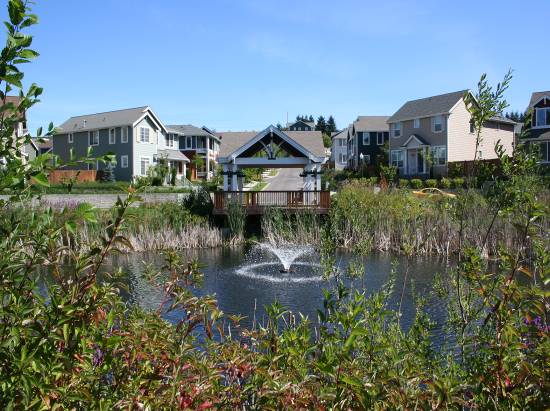
Figure 19.53.180-10
Storm pond amenity located at the Commons
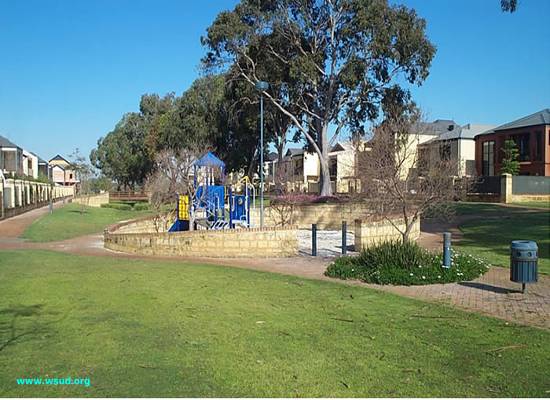
Figure 19.53.180-11
Usable detention pond in public open space
SL2.1.4. To encourage front yard landscaping and minimize the visual impact of driveways and other hardscape, a maximum of 50 percent of the front yard between the facade of the home and front property line shall be paved or covered with impervious surface.
SL2.1.5. Filling and grading shall be done in accordance with Chapter 13.25 UPMC and the King County Surface Water Design Manual (KCSWDM) to control stormwater runoff impacts to adjacent properties.
SL2.2. Design Guidelines.
SL2.2.1. Small lot developments should integrate existing natural features, required open space, and existing historic structures or cultural resources located on site into the overall design and layout of the development. Existing natural features, as well as the required common open space, should be used to create community amenities and provide physical separations and buffers from adjacent development, where needed. The site plan should reflect natural hydrology and minimize impervious surfaces.
a. Preserve or design into the infrastructure naturally vegetated areas that are in close proximity to parking areas, buildings, and other impervious expanses in order to slow runoff, filter out pollutants, and facilitate infiltration.
b. Direct runoff into or across vegetated areas to help filter runoff and encourage groundwater recharge.
c. Use native plants (or adaptable species) to establish an adaptable and low maintenance landscape that requires less irrigation and is appropriate for the climatic conditions.
d. Use devices such as bioretention cells, vegetated swales, infiltration trenches, and dry wells to increase storage volume and facilitate infiltration.
e. Plant bioswales with native grass to further improve water quality. Bioswales are encouraged throughout the development to treat runoff, improve water quality, and minimize or eliminate the size of detention ponds (see Figure 19.53.180-12).
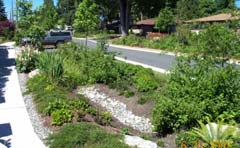
Figure 19.53.180-12
Vegetated bioswale
f. Disconnect impervious areas from the storm drain network and maintain natural drainage divides to keep flow paths dispersed. Maximize infiltration using: biofilters, green strips, swales and permeable materials in lieu of hardscapes.
SL2.2.2. Surface water and pollutant runoff should be reduced by maximizing the use of pervious surfaces and vegetative groundcover.
a. Use of permeable paving, pavers, turf stone, brick, and decomposed granite is encouraged.
b. Use of natural topographic features or built swales for filtration of site drainage is encouraged.
c. Porous concrete, porous paving stones, reinforced turf, crushed gravel with soil stabilizers, and paving blocks with planted joints are examples of acceptable materials that can be used for driveways, pathways, sidewalks, and patios.
SL2.2.3. Development impacts should be reduced by minimizing a site’s impervious surface footprint. This can be achieved by encouraging new development where houses have smaller footprints and are clustered closer together, share driveways with neighboring homes and much of the native vegetation has been preserved.
SL2.2.4. Existing trees and vegetation should be preserved whenever possible to act as buffers between adjoining developments and as community amenities within the development per Chapter 19.65 UPMC. Buildings, parking areas, and other structures should be set back from such features a sufficient distance to ensure their continued quality and natural functions (see Figure 19.53.180-12).
SL2.2.5. The “effective” impervious surface for the entire site should be minimized to the extent practicable while achieving urban densities consistent with the goals of accommodating small lot development and expanding housing choice in the community.
C. SL3: Lot Standards.
Design Objective: To strengthen the mutual relationship between housing units, roads, open space and pedestrian amenities for creating small lot developments that protect the privacy of individuals while creating pedestrian-oriented environments.
SL3.1. Approval Standards.
SL3.1.1. Building placement shall be configured to support the neighborhood’s existing site patterns, including building location, setbacks and yard areas, where existing patterns are clearly established and consistent.
SL3.1.2. Standards for Lot Size and Width.
a. Lot Size. There is no minimum lot size. Lot size shall be determined through the design standard review process.
b. Lot Width. Minimum 40-foot-wide lots for homes with front-loaded and side-loaded garages. No minimum width for lots with alley-loaded and other garage designs.
SL3.1.3. Setbacks shall ensure separation of homes and private spaces while allowing moderate density. Small-lot homes shall complement existing setback patterns in terms of distance to the street and spacing between homes while considering the smaller lot sizes and need for more private usable open space.
SL3.1.4. If used, reciprocal side and/or rear yard use easements shall be delineated on the site plan.
SL3.1.5. If a side yard use easement is used, the wall facing the side yard shall be constructed as a “privacy wall.” Privacy walls shall not have doors entering into the yard space of the adjacent home, nor have windows that are within five feet of ground level.
SL3.2. Design Guidelines.
SL3.2.1. Building Setbacks.
a. Front on Neighborhood Street: 10 feet to primary building, six feet to porch, eight feet to stoop. There shall be at least a 20-foot setback from the face of a garage to the back of the sidewalk. A variety of setbacks is strongly encouraged, with single-story facades having smaller setbacks and two-story facades having greater setbacks (see Figure 19.53.180-13).
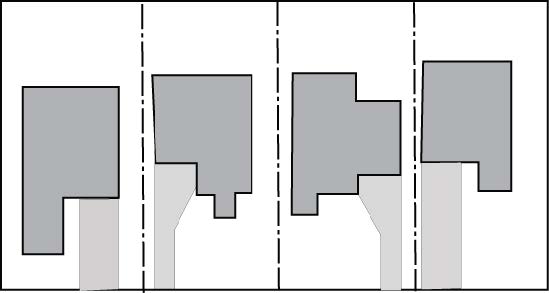
Figure 19.53.180-13
Variations in front and side yard setbacks break up long linear patterns
b. Front on Access Lane: five feet to building, zero feet to porch or stoop. Stairs and roof overhangs associated with a porch or stoop shall not encroach into the public right-of-way. There shall be at least a 20-foot setback from the face of the garage to the back of a curb, except where a sidewalk/pathway is constructed, the setback shall be at least 20 feet from the sidewalk/pathway.
c. Interior Side: five feet for detached units; eight feet for attached units. Architectural projections such as fireplace structures, bay windows or garden windows may project into a five-foot required side yard only if the building is protected with an automatic fire sprinkler system.
d. Side on a Corner Lot: 10 feet to building with at least a 20-foot setback from the face of a garage to the back of the sidewalk.
e. Rear: four feet to adjacent common open space, otherwise 10 feet.
f. Alleyway: two feet from alleyway tract or easement (see Figure 19.53.180-14).
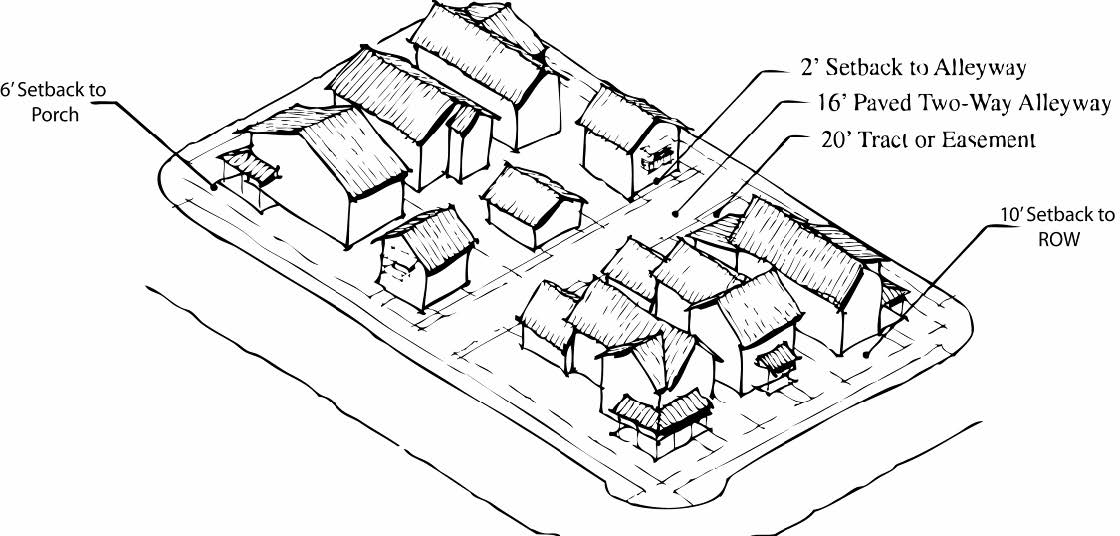
Figure 19.53.180-14
Alleyway lot
g. Front on a Pedestrian Easement or Common Open Space: four feet to building or one foot to porch or stoop.
h. Side on a Pedestrian Easement or Common Open Space: four feet.
i. Decks: Decks are considered part of the building and shall not intrude into required setbacks.
j. Perimeter: Same as the development standards of the underlying zoning district. A reduction may be permitted where the perimeter of the site abuts dedicated open space, stormwater facilities or railroad rights-of-way.
k. Homes that front on a common open space shall have all portions of the first floor within 150 feet of emergency vehicle access.
SL3.2.2. To facilitate development of small-lot single-family homes, rear alleys are the preferred alternative for accessing garages, off-street parking, utilities and trash facilities. Alleys shall be provided to serve all lots except where topography, site dimensions or other constraints preclude their use.
SL3.2.3. Use Easements.
a. Reciprocal side and/or rear yard use easements may be used to maximize the use of small yard areas (see Figures 19.53.180-15 and 19.53.180-16 for examples of side and rear yard use easements).
b. The design of use easements should not negatively affect the building foundations.
c. Given the intimate relationship between adjacent houses, the layout of each home on its lot should be designed to maximize this outdoor space.
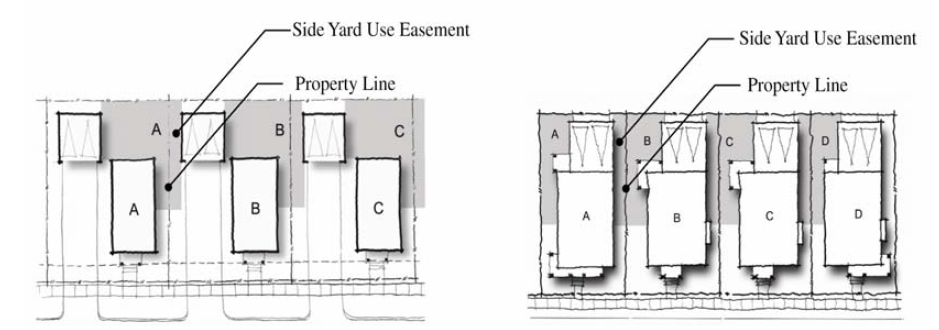
Figure 19.53.180-15
Side yard use easement
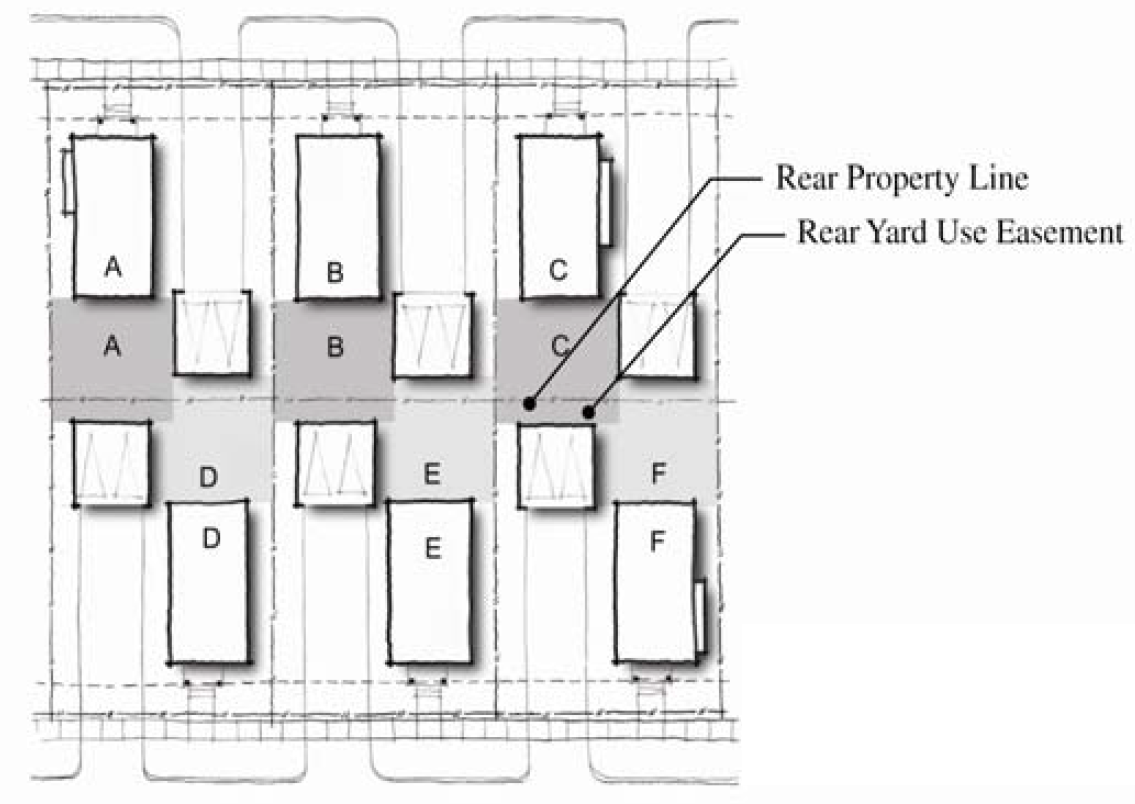
Figure 19.53.180-16
Rear yard use easement
D. SL4: Front Yards/Entrances.
Design Objective: To provide separation between buildings and the public pedestrian realm where the front yard functions as usable outdoor space and provides a clear, welcoming, and safe entry for pedestrians from the sidewalk into the building.
SL4.1. Approval Standards.
SL4.1.1. Primary building entries shall be clearly identifiable and visible from the street, with well-defined walkways from pedestrian routes to building entries (see Figure 19.53.180-17).
|
|
|
Figure 19.53.180-17: Desirable: Homes in Seabrook with distinct entries and steps leading directly to sidewalk and street |
SL4.1.2. Signage identifying a building’s address shall be visible from the street and public pedestrian walkway.
SL4.2. Design Guidelines.
SL4.2.1. Landscape planting should include the use of native shrubs and groundcovers where appropriate.
SL4.2.2. All landscape areas should include a mixture of deciduous and evergreen varieties, including perennials and flowering shrubs. Designs are strongly encouraged to include a minimum 20 to 25 percent of plant varieties that will provide seasonal color, texture and/or other special interest.
E. SL5: Parking and Garage Placement and Design.
Design Objective: To create residential development where a variety of garage placements ensure that the garages and parking areas are subordinate to the main home/living area and do not dominate the views of residential development from public streets and sidewalks.
SL5.1. Approval Standards.
SL5.1.1. The driveway and the garage shall be secondary to the livable portions of the house, landscaping and pedestrian entry as seen from the street (see Figure 19.53.180-18).
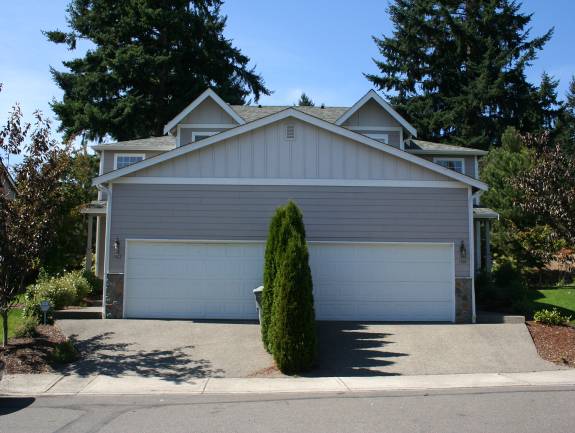
Figure 19.53.180-18:
Undesirable: Homes with garage and driveway dominated design
SL5.1.2. All garages shall be located in an area to minimize the presence of the automobile.
SL5.1.3. On-site garages shall be set back a minimum of 10 feet from the front building facade with a minimum 20-foot driveway length from the face of the garage to the back of the sidewalk or access lane. Garages accessed by an alleyway are not required to provide a 20-foot driveway.
SL5.1.4. Shared detached garages shall not be located further than 160 feet from any of the housing units to which it is assigned. Shared detached garages shall not exceed 44 feet in width and shall maintain at least an eight-foot separation from any dwellings.
SL5.1.5. Private detached garages shall maintain a minimum five-foot separation from any dwellings.
SL5.1.6. A tandem driveway space is allowed on a lot and shall extend a minimum of 20 feet from back of sidewalk or 20 feet from back of access lane.
SL5.1.7. The width of the driveway (excluding curb returns) shall not exceed 10 feet for single lane and 16 feet for double lane driveways. An individual driveway shall serve a maximum of four units.
SL5.1.8. Two resident parking stalls are required for each detached small lot unit and 1.5 resident parking stalls are required for each attached small lot unit.
SL5.1.9. In addition to required resident stalls, a minimum of one guest stall per small lot unit is required and shall be located on the lot (tandem parking is allowed), on a neighborhood street or in a parking court.
SL5.1.10. Parallel parking stalls on a neighborhood street shall be a minimum 22 feet long.
SL5.1.11. Guest parking shall not be located more than 160 feet from the home it is intended to serve.
SL5.1.12. For homes with front-loaded garages, no more than 40 percent of a home’s facade facing the street may be devoted to a garage.
SL5.1.13. For attached units, no more than two single-car garage doors may be visible on any street-facing facade and no more than one driveway may be located on each street frontage of a lot.
SL5.2. Design Guidelines.
SL5.2.1. When individual garages are incorporated into projects, common driveways or alley-loaded access is encouraged (see Figure 19.53.180-19).
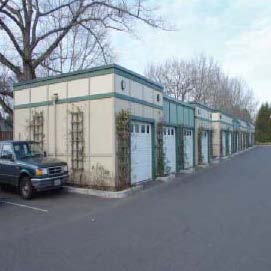
Figure 19.53.180-19:
Garages with common access
SL5.2.2. On-site garages may include both attached and detached structures.
SL5.2.3. Shared detached garages are allowed and can be used to meet resident parking requirements. Each housing unit shall be assigned a garage space and may share the structure with other homes.
SL5.2.4. A detached garage may be designed as a carriage house that includes a second floor accessory dwelling unit provided the building uses the same architecture as the principal building (see Figure 19.53.180-20). 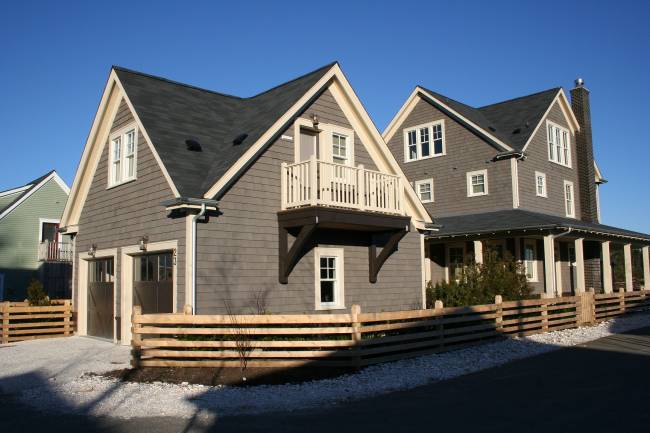
Figure 19.53.180-20:
Homes in Seabrook: Detached garage with accessory dwelling unit using architecture that is same as the principal residence
SL5.2.5. Driveways should be designed and located to minimize the appearance of the driveway and garage relative to pedestrian access, landscape, and livable portions of the home. Priority should be placed on the relationship of the rooms of the house or outdoor spaces to the street rather than the relationship of the garage to the street (see Figures 19.53.180-21, 19.53.180-22 and 19.53.180-23 for acceptable garage locations).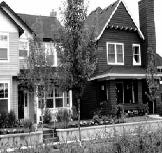
Figure 19.53.180-21:
DO THIS
These new houses are built on small lots with alley access. Each of these examples has:
• A variety of architectural styles and forms;
• Entry and sitting porches oriented towards the street; and planting strips and street trees between the sidewalk and street.
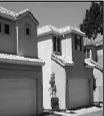
Figure 19.53.180-22:
DON’T DO THIS
These houses have garages that are forward of the main living areas of the house. The garages are the first thing that one notices and they dominate the streetscape.
|
|
|
Figure 19.53.180-23: Acceptable garage locations |
|
|
||
SL5.2.6. Design that minimizes views of garages and utilizes side and rear entry garages is strongly encouraged. Examples include side loaded garages, and garages that are set back from the house’s front facade, alley access garages, detached garages and one-car or tandem garages (see Figures 19.53.180-24, 19.53.180-25, 19.53.180-26 and 19.53.180-27).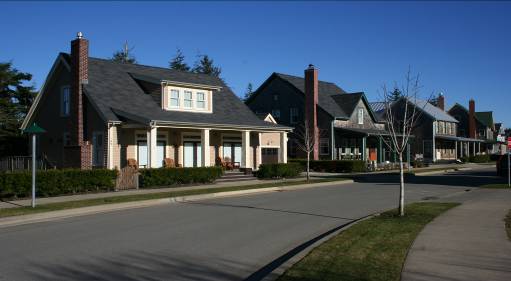
Figure 19.53.180-24
Homes in Seabrook: Detached garages are located to side or rear of lots
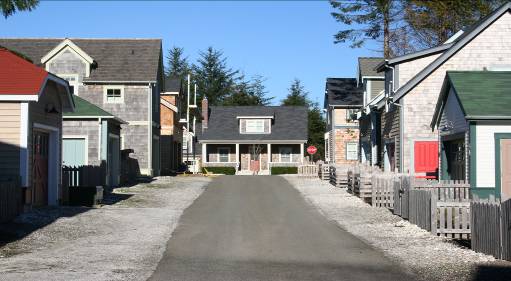
Figure 19.53.180-25
Garages in Seabrook, some with second floor
ADUs, located in a rear alley
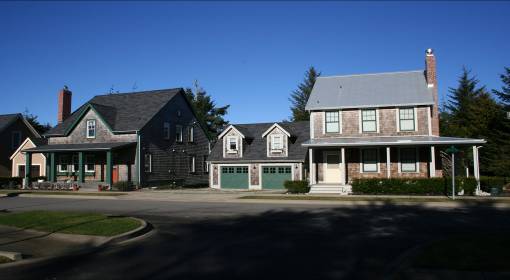
Figure 19.53.180-26
Homes in Seabrook: Shared detached garages
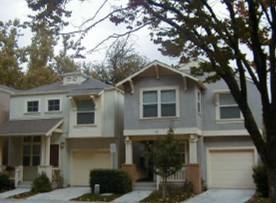
Figure 19.53.180-27
Tandem garages
SL5.2.7. Garages should follow an architectural style similar to the homes. If sides are visible from streets, lanes, sidewalks, pathways, trails, or other homes, architectural details shall be incorporated in the design to minimize the impacts of the facade. Blank walls lacking windows, articulation or modulation are not permitted when facing a street.
SL5.2.8. At least one garage stall per unit is encouraged.
F. SL6: Individual Outdoor Spaces.
Design Objective: To provide private outdoor space that encourages a sense of ownership by residents.
SL6.1. Approval Standards.
SL6.1.1. Outdoor spaces such as yards, decks, terraces, and patios shall be delineated from common space. Delineation may consist of walls, fences, berms, hedges, and landscaping (see Figure 19.53.180-28).
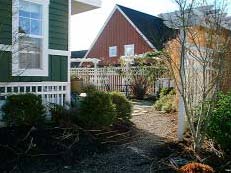
Figure 19.53.180-28
Example of private open space in small lot neighborhood
SL6.1.2. Each unit shall have a minimum of 250 square feet of private yard with no dimension less than eight feet in width. For developments of three or fewer dwelling units, a minimum of 750 square feet of private yard shall be required.
SL6.1.3. Outdoor spaces used to meet these standards shall not be located within required landscape buffer areas.
SL6.1.4. Outdoor spaces shall not be located adjacent to dumpster enclosures, loading/service areas, or other incompatible uses.
SL6.2. Design Guidelines.
SL6.2.1. Planting areas should include the use of native plants when feasible.
SL6.2.2. Where landscape areas are provided, plant materials should be a mixture of deciduous and evergreen varieties. Designs are strongly encouraged to include a minimum 20 to 25 percent of plant varieties that will provide seasonal color, texture and/or other special interest.
SL6.2.3. Backyard patios and reciprocal use easements may be included in the calculation of private outdoor space.
G. SL7: Common Open Spaces.
Design Objective: To visually unify a development, link development clusters and provide enhanced pedestrian friendly circulation within the development.
SL7.1. Approval Standards.
SL7.1.1. Projects shall be sited to maximize opportunities for creating usable, well-integrated open space.
SL7.1.2. Pocket Parks.
a. A minimum of one half-acre park or central open space area (pocket park) shall be required for developments exceeding 10 acres of net developable acreage. The remaining required common open space shall be provided through additional park area, common greens, or pedestrian entry easements. If a small lot development has less than 10 acres of buildable land, a park, common green, pocket park and/or pedestrian entry easement may be used to meet the common open space requirements.
b. Pocket parks shall be visible and open to the street or be designed to serve clusters of approximately six to 12 homes (see Figure 19.53.180-29).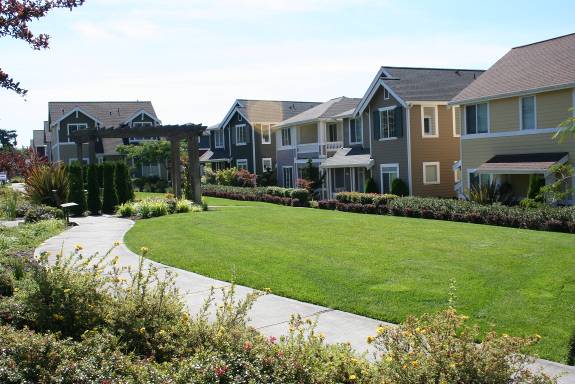
Figure 19.53.180-29
Common open space area/pocket park in The Commons at Fircrest, providing space for human interaction and play
SL7.1.3. Common Open Space.
a. For small lot developments of four or more units, each unit shall provide at least 350 square feet of common open space. Developments of three or less dwelling units have no common open space requirement.
b. Common open space shall be a minimum of 20 feet wide, and serve a minimum of four homes.
SL7.1.4. Pedestrian Easement. A pedestrian entry easement can be used to meet common open space requirements if it has a minimum width of 20 feet with a minimum five-foot wide sidewalk (see Figure 19.53.180-30).
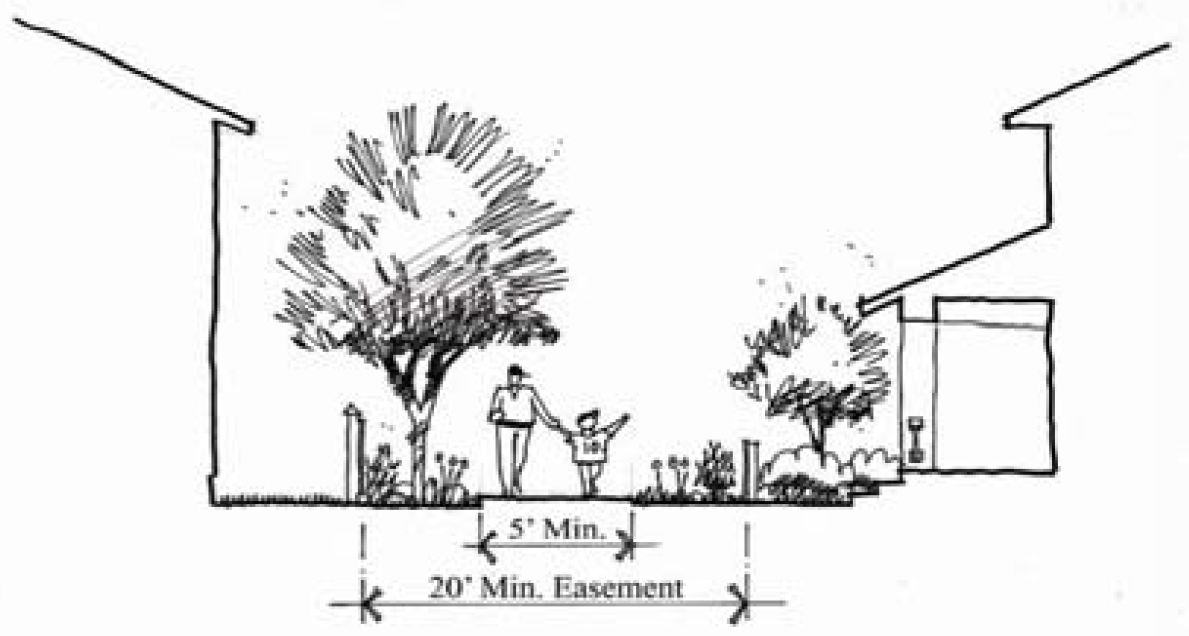
Figure 19.53.180-30
SL7.2. Design Guidelines.
SL7.2.1. Stormwater ponds may be used to meet the common open space requirement if designed to be dry for 90 percent of the year. Such ponds shall be designed as a landscape amenity and shall not be fenced.
SL7.2.2. In common open space areas, grass-crete or other pervious surfaces may be used for the purpose of meeting the 150-foot distance requirement for emergency vehicle access.
SL7.2.3. Open space areas should be used to visually unify a development, link development clusters and provide enhanced pedestrian circulation within the development.
SL7.2.4. Common open space should be centrally located so that it is a focus for the neighborhood and be easily viewed from the street and homes for informal surveillance and security (see Figure 19.53.180-31). 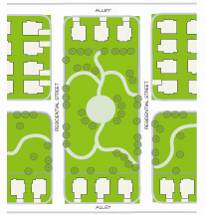
Figure 19.53.180-31
Common open space that is centrally located to the development
SL7.2.5. Clustering of buildings is encouraged to minimize small, narrow, unassigned strips in front of and between buildings.
SL7.2.6. The location of all open space areas should take into account climatic factors such as sun orientation and prevailing winds.
SL7.3. Public Trail and Park Improvements in Lieu of Common Open Space.
Design Objective: Provide incentives for projects that support development of public trails and parks identified within the City’s Parks, Recreation and Open Space (PROS) Plan.
SL7.3.1. On-site public trail construction and dedication may, at the City’s discretion, substitute on a square footage basis for common open space when the proposed trail is identified within the City’s PROS plan. The following requirements shall be met:
a. The trail must be identified within the PROS Plan.
b. The trail shall be constructed to City standards.
c. The trail must be dedicated to, and accepted by, the City as a public trail.
d. Trail dedication and construction shall reduce the required common open space on a square footage basis. For example, if the area of land dedicated for trail purposes is 50,000 square feet, an equivalent 50,000 square foot reduction in common open space shall be granted.
SL7.3.2. Improvement of off-site public parks and trails may, at the City’s discretion, be used to reduce common open space requirements when the proposed park or trail is identified within the PROS plan and the following requirements are met:
a. The public park or trail to be improved must be identified within the PROS plan, located on land owned by University Place, and be located no greater than 600 feet from the development. In the case of off-site trail improvements, a direct connection from the development to the trail must be provided.
b. The park or trail must be improved to City standards.
c. The park or trail improvements must be dedicated to, and accepted by, the City.
d. Public park and trail improvement shall reduce the required common open space by an area equivalent in value to 120 percent of the estimated value of the improvement. The monetary value of the off-site improvement shall be determined by the City based upon an estimate of the cost to University Place for the construction of similar improvements. The monetary value of the common open space area shall be determined by University Place based upon the market value of the land for residential use with utilities and other non-structural improvements in place.
H. SL8: Utility Areas and Accessory Structures.
Design Objective: To minimize the impact of utility locations and accessory structures.
SL8.1. Approval Standards.
SL8.1.1. Above ground utility boxes shall be placed in alleyways or away from public gathering spaces to the extent practicable and shall be screened with landscaping, which may include fencing or berms. This provision does not apply to meters attached or placed next to buildings.
SL8.1.2. No more than one detached garage or other accessory structure shall be permitted per lot and shall be architecturally consistent with the principal structure.
SL8.1.3. Detached garages shall not exceed 18 feet to top of roof in height or more than 600 square feet in area.
SL8.1.4. Carriage houses, which consist of an ADU located above a detached garage, shall not exceed 21 feet in height or a building footprint of 600 square feet in area.
SL8.1.5. Greenhouses, sheds, and other accessory structures (other than garages and carriage houses) shall not exceed 12 feet to top of roof in height or 150 square feet in area.
SL8.1.6. Accessory structures shall be no closer than three feet from the interior side or rear property line or two feet from an alleyway.
SL8.1.7. Overhangs and roof drainage may not encroach over property lines.
SL8.1.8. Accessory structures are not allowed in front yards.
SL8.2. Design Guidelines.
SL8.2.1. Utility boxes should be grouped, if possible.
SL8.2.2. Mailboxes may be clustered in accordance with U.S. Postal Service (USPS) standards. Clustered mailboxes shall be architecturally enhanced with materials and details typical of nearby small lot development architecture and carefully placed to not adversely affect the privacy of residents and serve the needs of the USPS (see Figure 19.53.180-32).
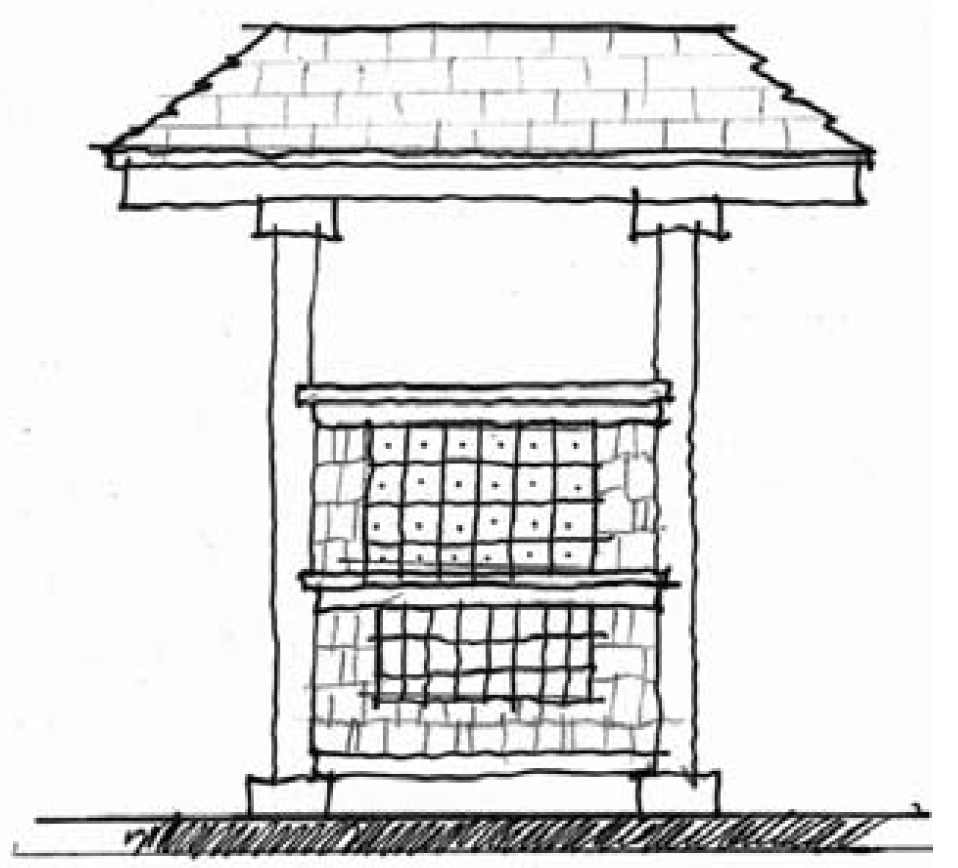
Figure 19.53.180-32
Mailbox design
SL8.2.3. Landscaping should be provided around trash enclosures to soften views wherever feasible.
SL8.2.4. Trash enclosures should be located away from adjacent parcels to minimize noise and odor impacts typically associated with garbage collection and storage (see Figure 19.53.180-33).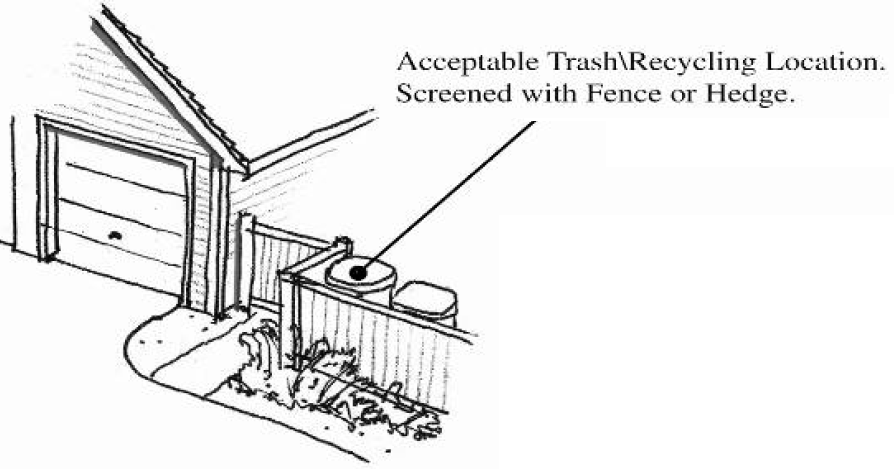
Figure 19.53.180-33
Trash/recycling location
(Ord. 741 § 1 (Exh. J), 2020; Ord. 559 § 6 (Exh. A § 3(SL1 – SL8))).
19.53.190 Building design.
A. SL9: Mass, Scale and Form.
Design Objective: To encourage residential development that establishes streetscape variety, avoids monotonous facades, is pedestrian in scale and compatible with surrounding properties.
SL9.1. Approval Standards.
SL9.1.1. Primary building forms shall be the dominating form while secondary formal elements shall include porches, principal dormers, or other significant features (see Figure 19.53.190-1). 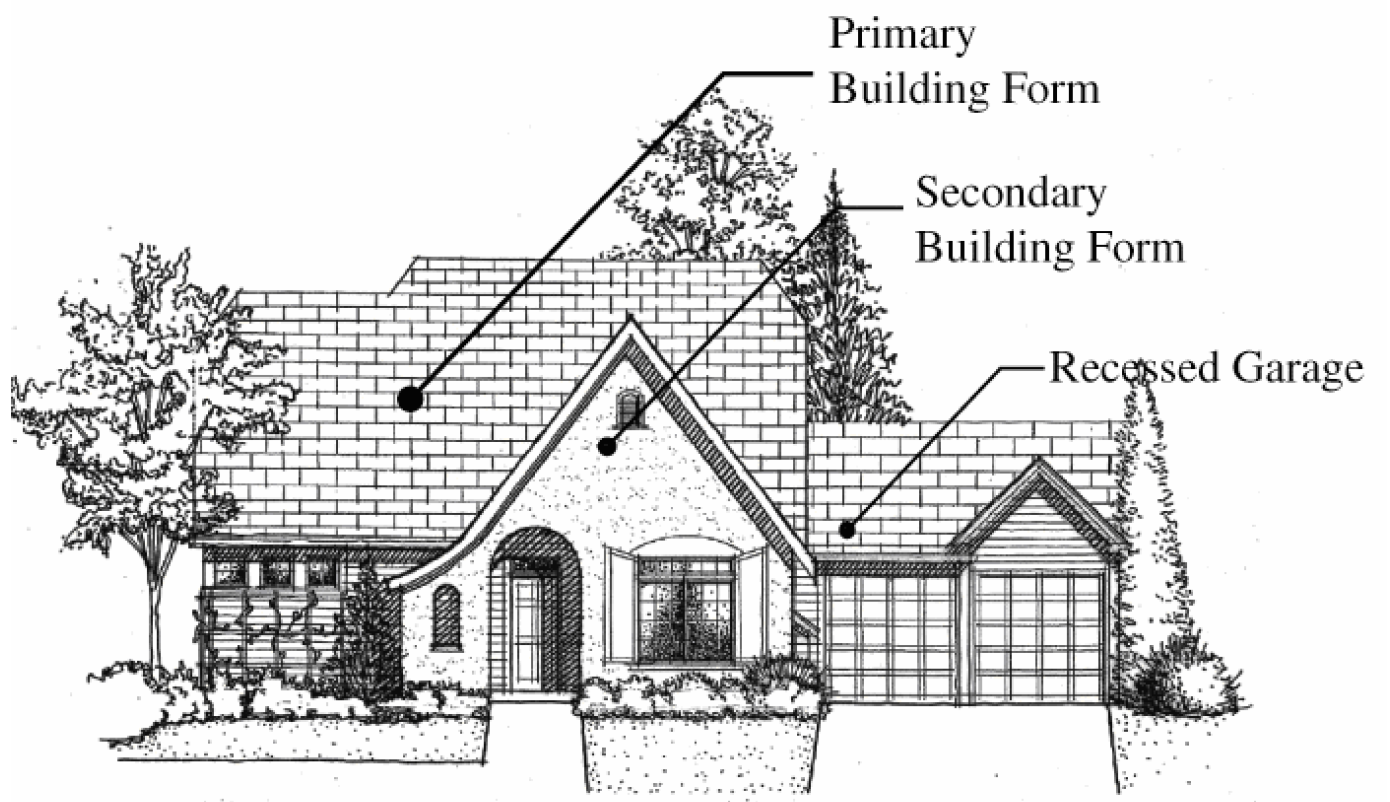
Figure 19.53.190-1
Primary building form should define the overall form of the house
SL9.1.2. The scale, mass and height of a new house or second/upper story additions shall be compatible with the existing neighborhood pattern specifically in relation to height and massing of adjacent homes.
SL9.1.3. The primary building elevation oriented toward the street or common green shall have at least one articulation or change in plane. A minimum of at least one side articulation shall occur for side elevations facing streets or public spaces.
SL9.1.4. Primary articulations shall be a minimum of two feet in depth and extend at least 20 percent of the length of the building facade. Side articulations shall be a minimum of one foot in depth and extend at least 20 percent of the length of the building facade (see Figure 19.53.190-2).
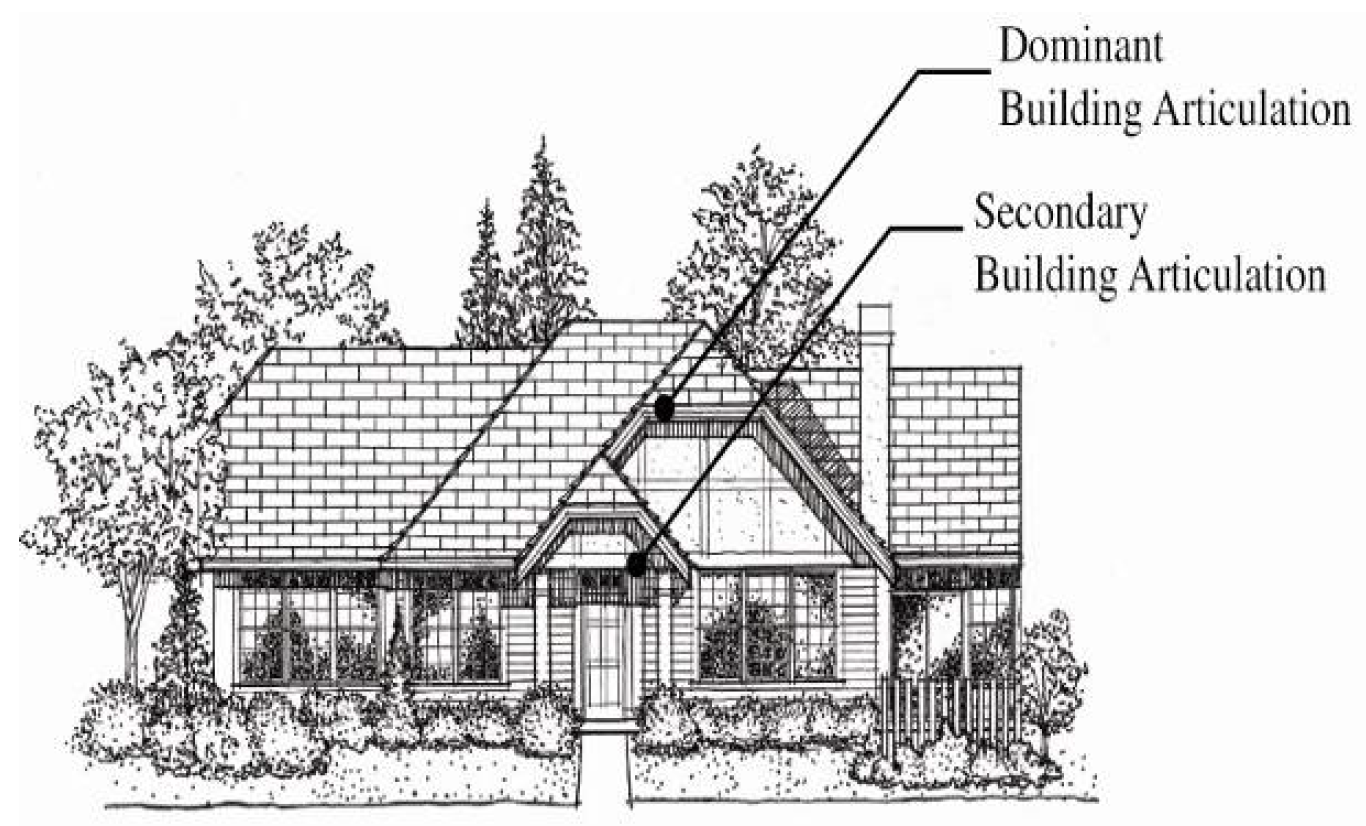
Figure 19.53.190-2
Primary and secondary building articulations avoid a monotonous streetscape appearance
SL9.1.5. Each home shall have a covered porch or main entry oriented towards the public realm.
SL9.1.6. Roof profiles shall define the form, scale and proportion of the home and building and reduce bulk.
SL9.1.7. The following bulk regulations shall apply:
|
Maximum Size for Dwelling |
Attached unit: 1,500 square feet. Detached unit: 2,000 square feet. Attached garages are included. Detached garages and carriage house ADU floor area are excluded. |
|
Floor Area Ratio (FAR) |
Maximum FAR for individual lots shall not exceed 0.45. Average FAR for all homes within a small lot development shall not exceed 0.40. FAR is calculated using a site’s buildable area, including private street area and excluding critical areas and their required associated buffers. See UPMC 19.45.080 for FAR standards. |
|
Maximum Height for Dwelling |
30 feet (where minimum roof slope of 6:12 for all parts of the roof above 20 feet is provided). Otherwise, 20 feet. |
|
Maximum Height for Accessory Structure |
18 feet for nonresidential structures. 21 feet for accessory structure containing a carriage house ADU. |
|
Maximum Size for Accessory Structure |
600 square feet on ground floor. Additional area allowed on second floor to accommodate a carriage house ADU. |
SL9.2. Design Guidelines.
SL9.2.1. Use new two-story home designs and second story additions that minimize structural massing of the second floor – particularly in existing neighborhoods that are predominantly single-story. Avoid two-story homes with disproportionately large masses, monumental forms and sharp contrasts in height (see Figure 19.53.190-3).
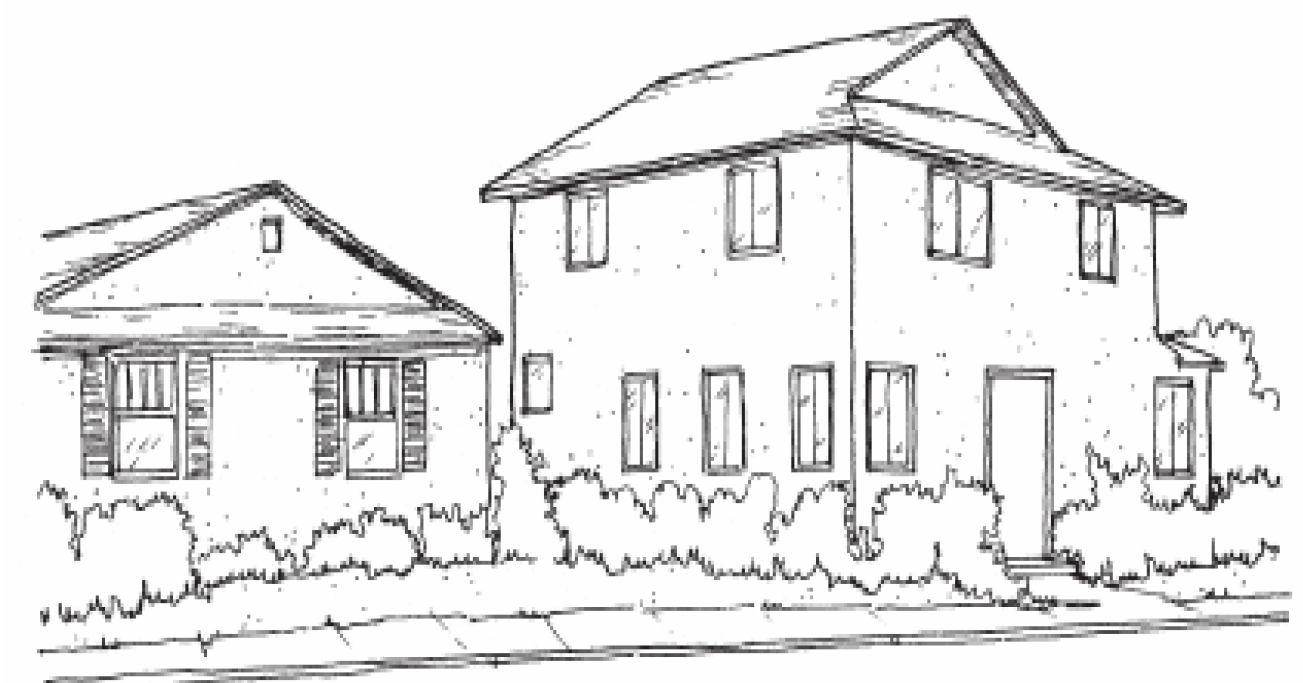
Figure 19.53.190-3
Avoid creating tall two-story exterior walls that are less compatible with single-story neighbors
SL9.2.2. Design of individual homes should provide interest and balance of bulk and mass. Design techniques include:
a. Second story setbacks stepped back from the first floor wall plane on at least two sides. On corner lots, the second story wall planes should be stepped back from the first floor wall planes along the street frontages (see Figures 19.53.190-4 and 19.53.190-5);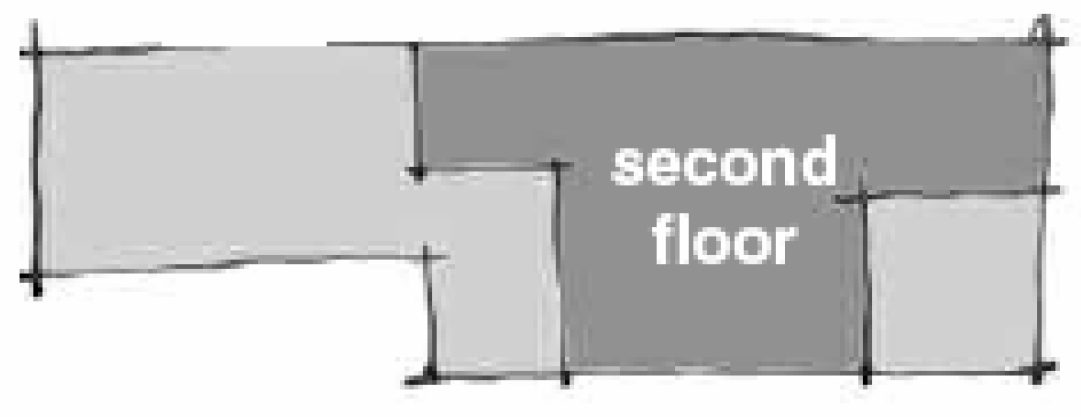
Figure 19.53.190-4
Interlocking upper and lower forms can make building composition more interesting
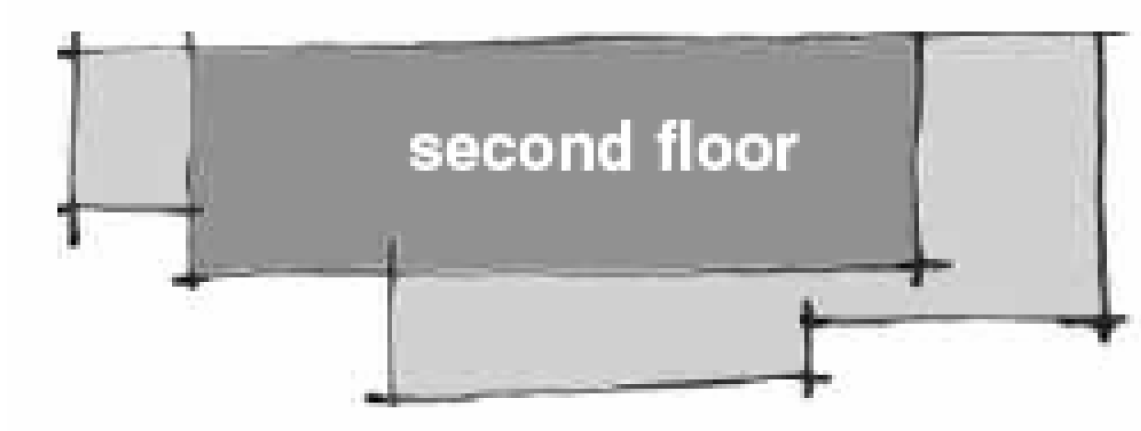
Figure 19.53.190-5
Setbacks of upper floors reduces visual appearance
b. Use horizontal elements to soften vertical elements (e.g., roof forms, decks);
c. Keep second floor exterior wall heights as low as possible;
d. Use roof forms that reduce bulk (e.g., use a number of hips and valleys); and
e. Minimize use of tall, two-story design elements with no architectural relief.
SL9.2.3. Avoid creating long or tall blank walls, particularly on the front and side of the home. By breaking up the appearance of long side walls with steps in the building wall, windows, and/or other substantial articulation, the apparent building mass can be reduced (see Figures 19.53.190-6, 19.53.190-7, 19.53.190-8 and 19.53.190-9). Use changes in materials and appropriate architectural detailing that add scale to long walls. 
Figure 19.53.190-6
Do this –
Reduce apparent building mass by changing building footprint
Figure 19.53.190-7
Do not do this –
Long unbroken walls appear massive
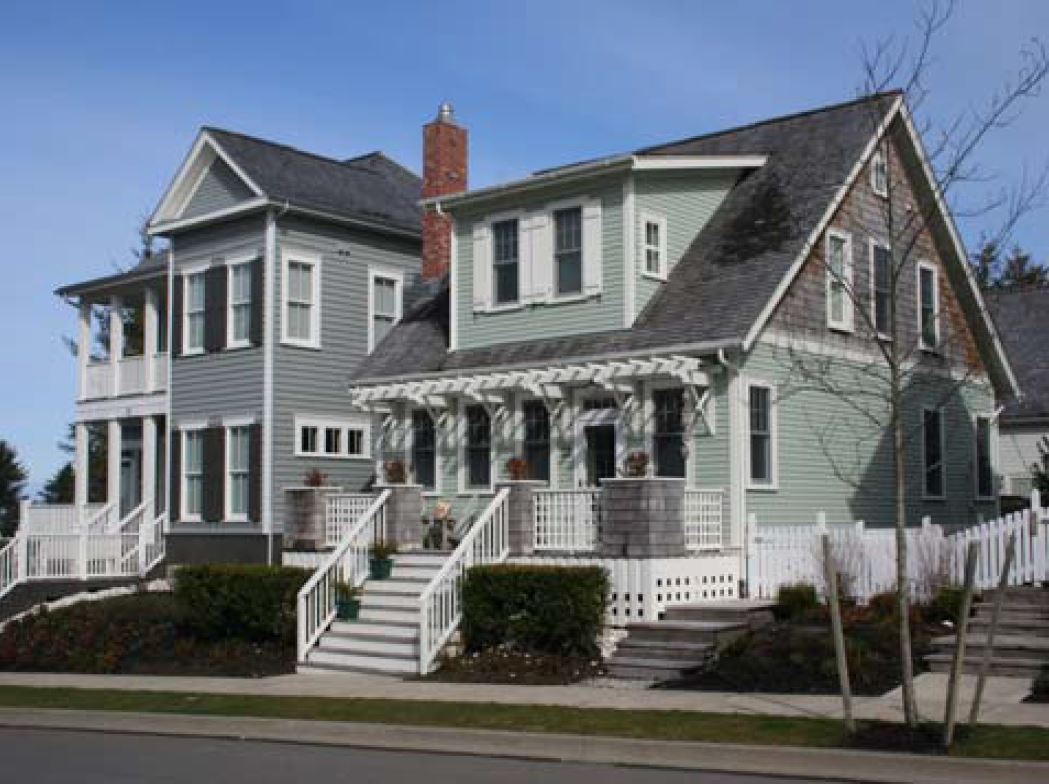
Figure 19.53.190-8
Homes in Seabrook are modulated to break up the apparent bulk of the structures. Fenestration, window and door trim, entry accents, and changes in materials provide additional articulation
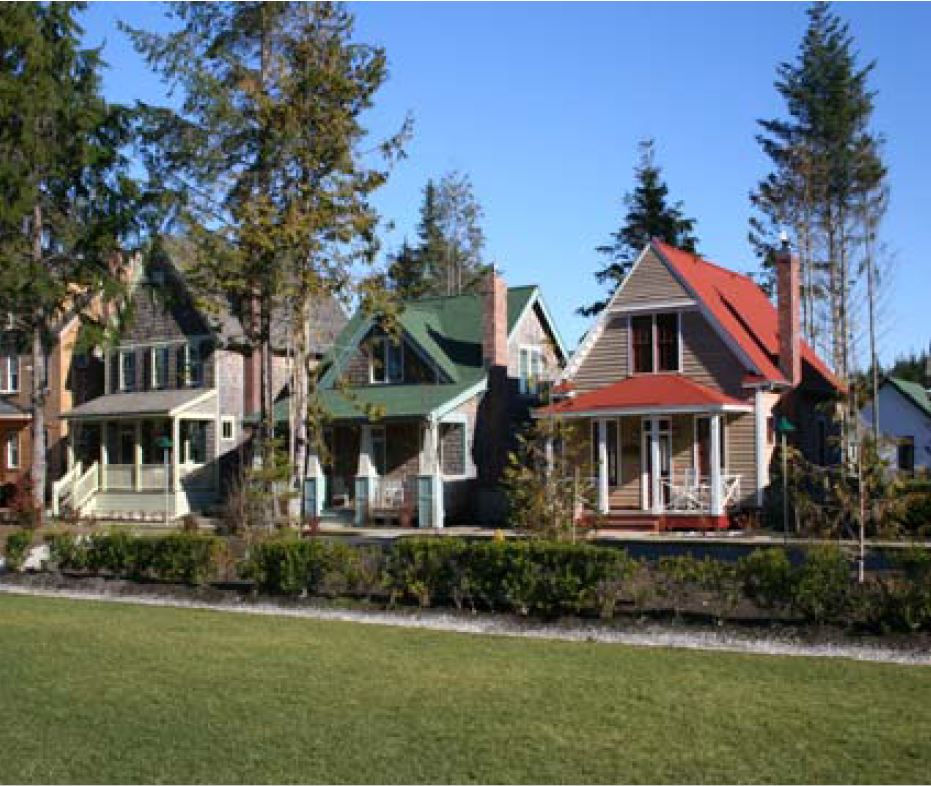
Figure 19.53.190-9
The massing of these homes is complementary, although individual building massing is unique. Homes in Seabrook employ a variety of roof forms and ridgeline orientations to the street, upper floor setbacks and other design elements to reduce apparent building mass.
SL9.2.4. Building massing should be varied by employing a variety of techniques, such as recessed and projecting porches, bay windows, dormers and varying planes or setbacks. As appropriate to the style of the house, the roof forms should be varied (see Figures 19.53.190-10 and 19.53.190-11).
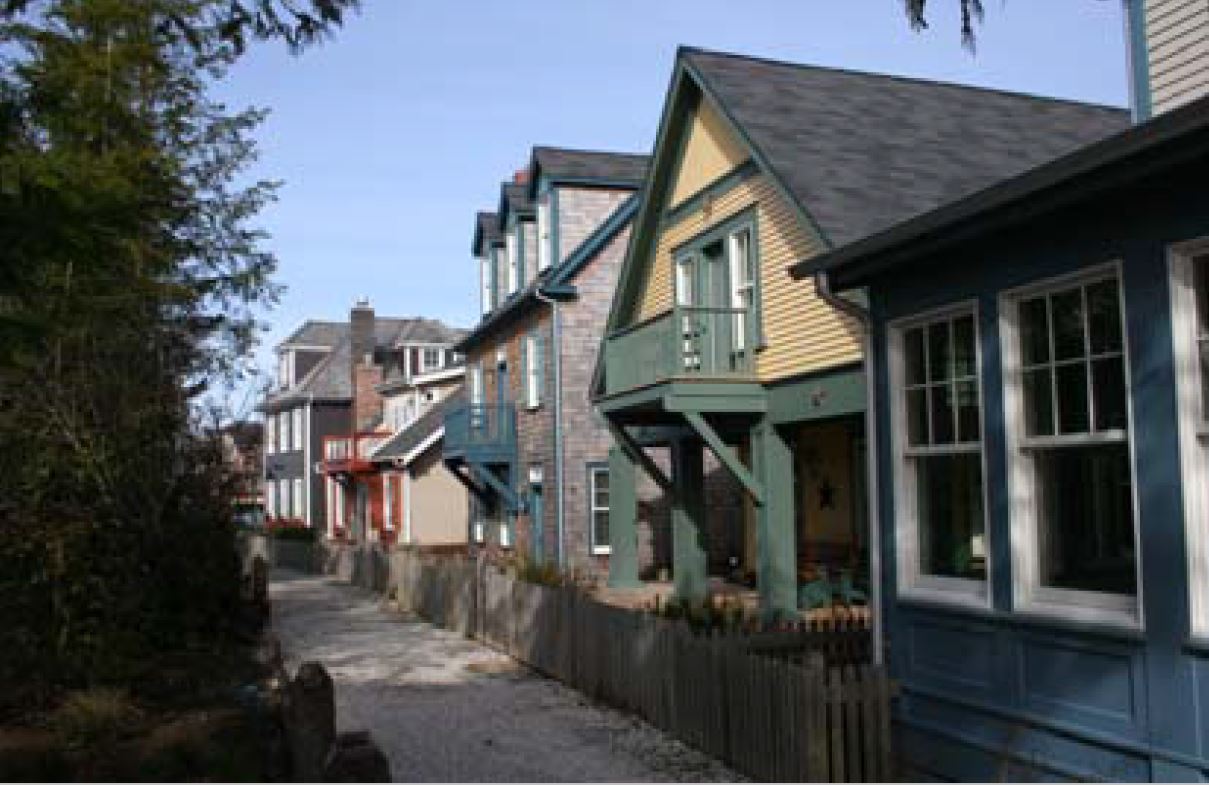
Figure 19.53.190-10
Do this –
Homes in Seabrook: Variation in scale and massing by utilizing varying roof planes
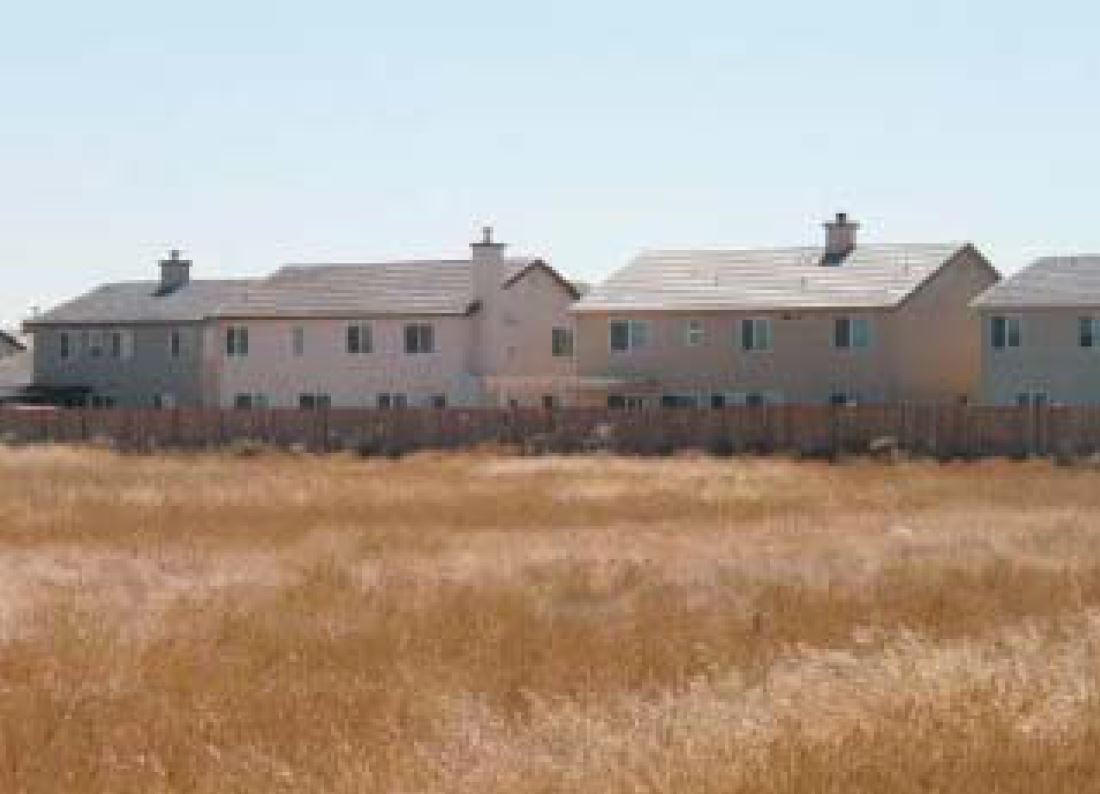
Figure 19.53.190-11
Do not do this – This single-family project does not have any variation in roof planes
SL9.2.5. Choose appropriate roof pitches and forms to break up the perceived mass and height. By moving second floor to the rear of the house and highlighting a single-story element, visual mass of the house can be reduced (see Figures 19.53.190-12, 19.53.190-13 and 19.53.190-14).
Breaking up the mass and volume of a two-story house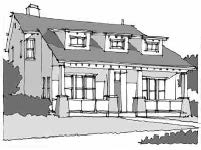
Figure 19.53.190-12
Pushes second story to rear
Uses one-story porch element facing street with dormer windows
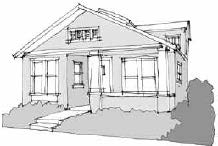
Figure 19.53.190-13
Moves second floor to rear of house
Presents one-story gable to street
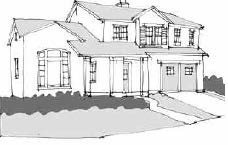
Figure 19.53.190-14
Steps back second floor
Makes massing horizontal in appearance
B. SL10: Architectural Style.
Design Objective: To ensure that residential design contributes to the overall architectural character of University Place.
SL10.1. Approval Standards.
SL10.1.1. The architectural style of the house or building shall enhance the character of the neighborhood.
SL10.1.2. The architectural form of the house or building shall be carefully designed to articulate the style of the house or building.
SL10.2. Design Guidelines.
SL10.2.1. New homes should be designed with an identifiable architectural style that enhances the character of the existing neighborhood. Additions to existing homes should be designed to be compatible with the architectural style of the existing home. (Please refer to “A Field Guide to American Houses” by Virginia and Lee McAlester.)
SL10.2.2. Consider using the design vocabulary of a particular architectural style to define a home’s visual form. This can be achieved in the following ways:
a. Avoid an interior design-driven floor plan that does not consider the impacts to exterior building mass and rooflines. Floor plans and roof layouts should coordinate well to create the best three-dimensional design.
b. Architectural elements of buildings (such as openings, doors, windows, etc.) and architectural features (like roof elements, columns, dormers, etc.) should be in proportion to the overall home design.
SL10.2.3. Building articulation should be varied for visual interest and to provide relief from close adjacency of homes. Breaking up the building into smaller component parts will make it compatible to human scale and this can be achieved by employing a variety of techniques as follows:
a. Divide building into portions or segments compatible with the adjacent residential scale. Facades of long buildings shall be architecturally subdivided into shorter segments every 25 to 30 feet maximum.
b. Long walls (over 10 to 15 feet) should have architectural detail or be staggered to provide shade and shadow. Vertical two-story elevations should contain some architectural relief such as windows or decks, unifying architectural elements such as a sill or header line in the surface of the wall (see Figure 19.53.190-15).
|
|
|
|
Figure 19.53.190-15 Homes in Seabrook: Variations in roofline, building volume and good use of horizontal and vertical elements break up the building into small component parts |
c. Use a few simple, well-proportioned building masses accented with a few smaller architectural elements, such as bay windows or dormers. Using too many elements can create a cluttered appearance.
d. Accentuate the ground floor of the building by making it more substantially visual than upper stories. This can be achieved by using entry porticos and front porches or other articulation at the ground level.
e. Use upper story setbacks or partial indentations for upper story features, such as balconies, outdoor moldings or cornices, to accentuate the horizontal levels of a building.
SL10.2.4. Building elevations should not be replicated across the street from each other or on adjacent parcels (see Figure 19.53.190-16).

Figure 19.53.190-16
Variety of models and elevations
C. SL11: Facades and Entries.
Design Objective: To ensure that residential entries and frontages promote a relationship to the human scale; create inviting transitions between public and private areas; facilitate opportunities for pedestrian activity on adjoining public streets and contribute to the overall design of the building and a community-oriented character for residential neighborhoods.
SL11.1. Approval Standards.
SL11.1.1. Facades. Facades shall be designed to include entries, porches and other architectural elements that relate to the human scale and provide a transition from public to private space with the following characteristics (see Figure 19.53.190-17):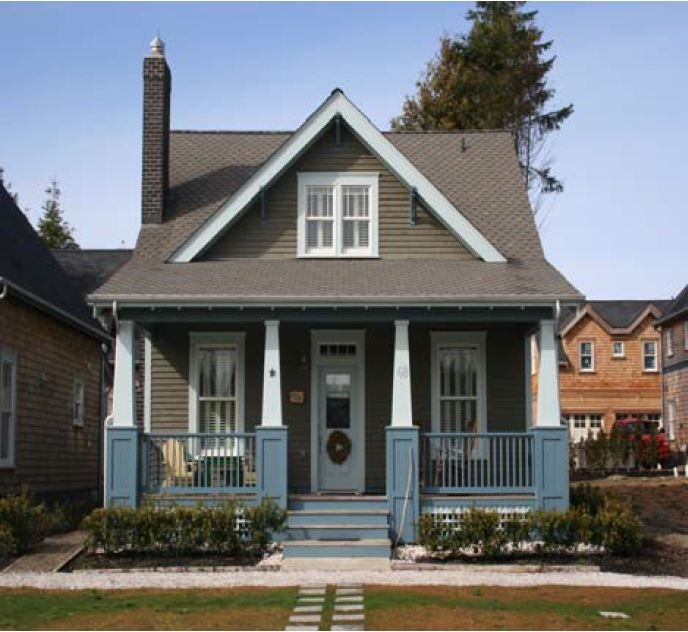
Figure 19.53.190-17
This single-family residence has a clearly defined entry and a front porch that is large enough for people to sit.
a. Clear entry sequence extending from the public sidewalk to the front door;
b. Provide clearly defined site and building entries that are in scale with the proposed project and relate directly to the street frontage;
c. The front door to each unit shall be clearly visible from the adjacent street. The use of distinctive architectural elements and materials to denote prominent entrances is required.
SL11.1.2. Stoops and Porches.
a. Stoops or porches are required on all homes. At least 75 percent of the homes within a development shall have porches.
b. Stoops and porches shall be raised above the grade except where accessibility (ADA) is a priority. An accessible route may also be taken from a driveway.
c. All porches and stoops must take access from and face a street, park, common green, pocket park, pedestrian easement, or open space.
d. Stoops shall be accompanied by a projecting overhead element such as a dormer, arch or gable that provides roof coverage and weather protection. Stoops shall be a minimum of five feet wide and four feet deep. The minimum height above grade is 12 inches.
e. Porches shall have a minimum dimension of eight feet and a minimum area of 64 square feet. On corner lots, porches are encouraged to wrap around the side facade at least six feet (see Figure 19.53.190-18).
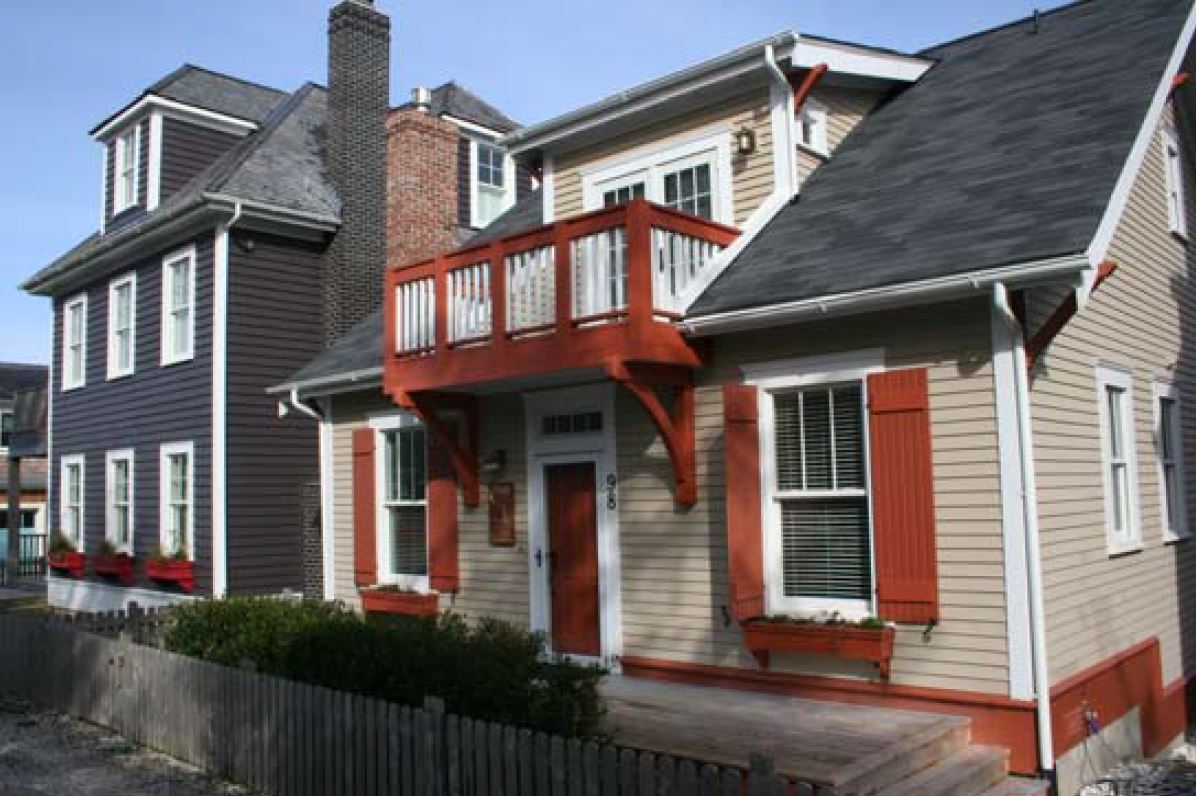
Figure 19.53.190-18
This home has a stoop that includes a projecting overhead element that provides protection from the elements and a second floor deck
SL11.1.3. Entries.
a. Residential entries shall be located on the front facade and shall directly access the sidewalk or street.
b. Any visible side of a home located on the corner of a neighborhood street, access lane, a park, green, or pocket park shall meet the architectural standards of this section (see Figure 19.53.190-19). 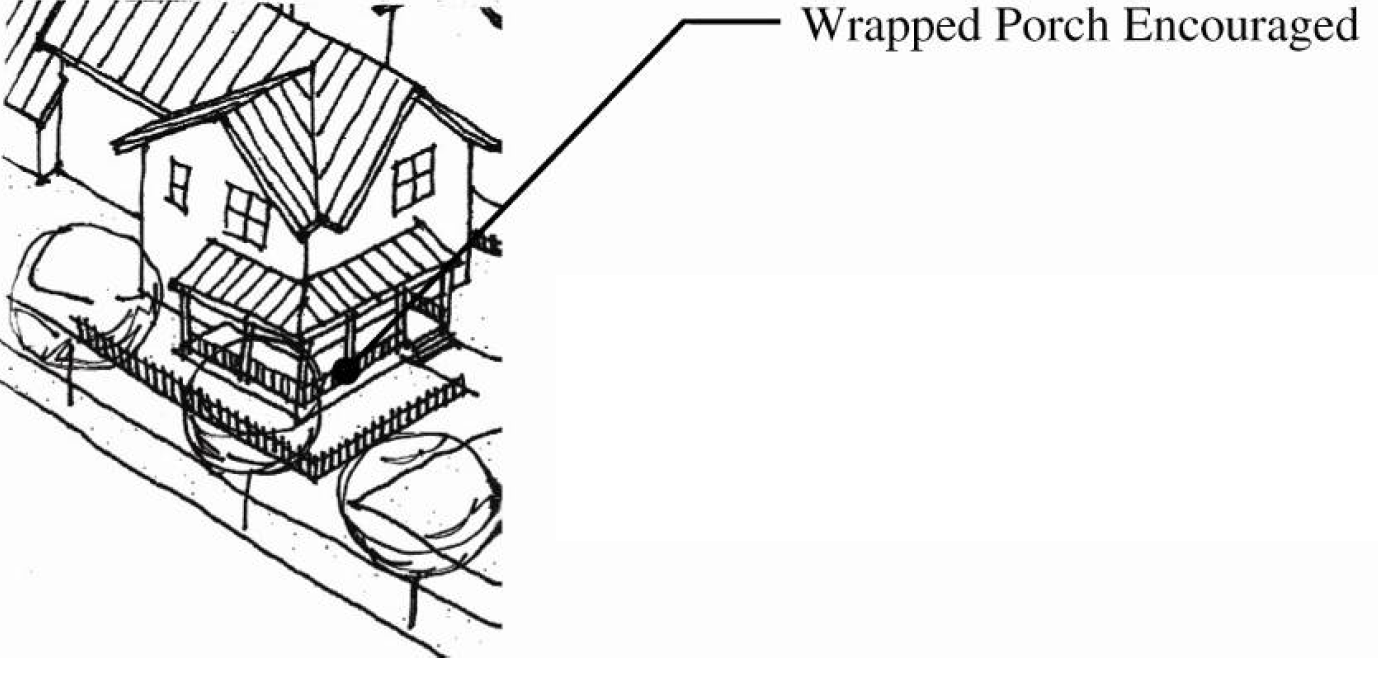
Figure 19.53.190-19
Corner lot architectural elements
c. Windows shall be provided in facades facing streets, comprising at least 20 percent of the facade area.
d. All windows within a building and across a facade shall be related in design, operating type, proportions and trim.
e. Windows shall be used as architectural elements that add relief to the facade and wall surface.
f. Windows shall employ design details, if appropriate to the architecture, such as mullions, to break the scale of the facade into smaller components.
g. Windows shall be inset into the facade or framed with substantial trim and sills to provide depth and shadow lines.
h. Front doors shall reflect the architectural style of the home. Screen or storm doors are permitted if they are in keeping with the home’s architectural character. Screen doors shall not be:
(1) Unpainted aluminum;
(2) Unpainted or unstained wood;
(3) Comprised of nonarticulated wood or aluminum panels;
(4) Temporary in appearance.
SL11.2. Design Guidelines.
SL11.2.1 Facades.
a. Give special attention to elevations on the side of the house and corners visible from the street (see Figure 19.53.190-20).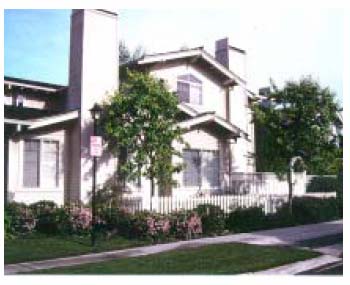
Figure 19.53.190-20
Articulation of elements along corner lot streets should be comparable to building front articulation
b. Facade components facing the street should correspond to the scale of the human form. This is accomplished by visually breaking up facades into smaller components with elements such as windows, wall insets, balconies, ledges and trim and by stepping back upper stories.
c. If the building mass and pattern of windows and doors is complex, simple wall surfaces are recommended. If the building volume and the pattern of wall openings are simple, additional wall texture and articulation should be employed.
SL11.2.2. Entries.
a. Entry features should be integral to the facade, designed at a human scale and have substantial detailing. Entry features should not be over-scaled or monumental in nature and should not stand out on the house or in relationship to other houses in the neighborhood due to size, height or proportion (see Figures 19.53.190-21 and 19.53.190-22). 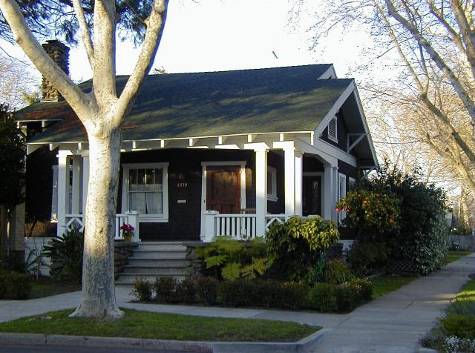
Figure 19.53.190-21
Entry porch highlights primary entry to the house and is oriented toward the street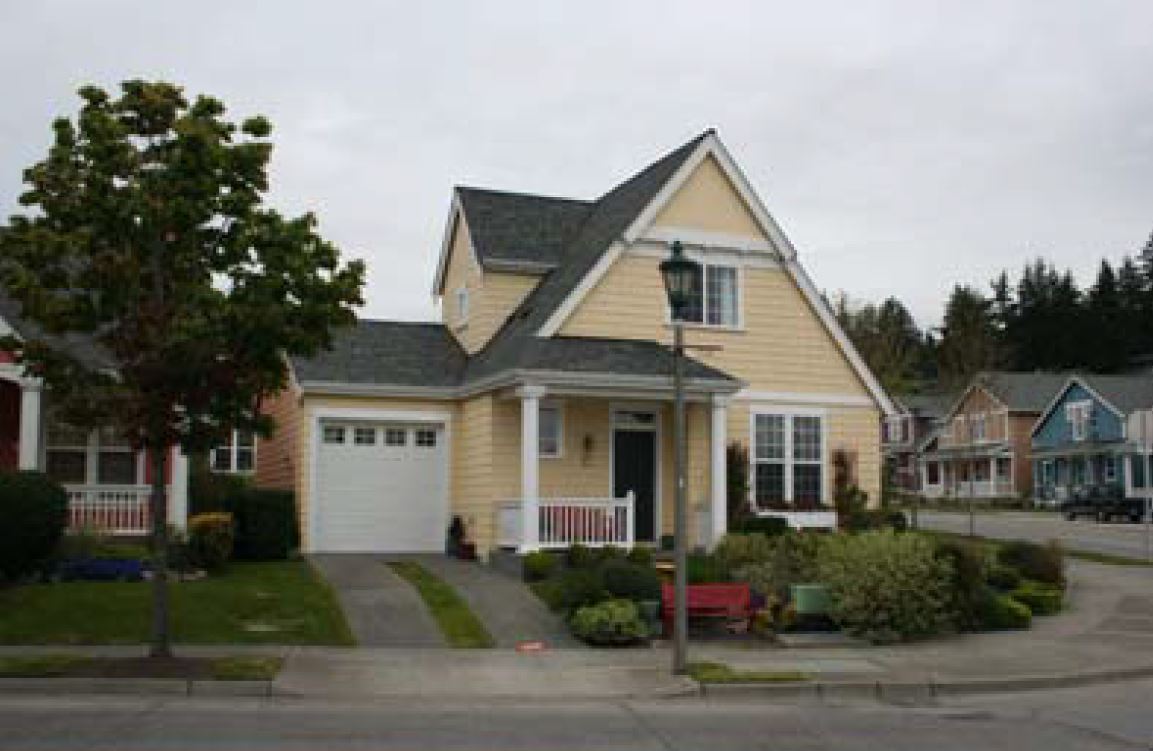
Figure 19.53.190-22
Home with street-facing entry and good window placement
b. Residential entries should be separated from the street by semi-private transition areas, with one of the following characteristics (see Figure 19.53.190-23):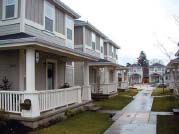
Figure 19.53.190-23
Use of porches can help transition from the public to the private realm and create a space for residents to congregate
(1) Porches, terraces, stoops or canopy-covered doorways close to or attached to sidewalks should be raised above street grade at least two feet; or
(2) A private entryway setback and separated from the sidewalk with a gate, fence, wall or other method.
c. Residential entryways should have the following characteristics:
(1) Differentiated roof, awning, or portico at the entry;
(2) Multi-panel doors;
(3) Durable, high quality metal door hardware.
D. SL12: Roofs.
Design Objective: To provide for a variety of roof forms and profiles that adds character and relief to the streetscape.
SL12.1. Approval Standards.
SL12.1.1. Primary Roof Pitch. Primary roof pitches shall be a minimum of 6:12 (see Figure 19.53.190-24).
SL12.1.2. Gable Forms. Roof pitches for gable forms on the public sides of the buildings shall be a minimum of 8:12 (see Figure 19.53.190-24).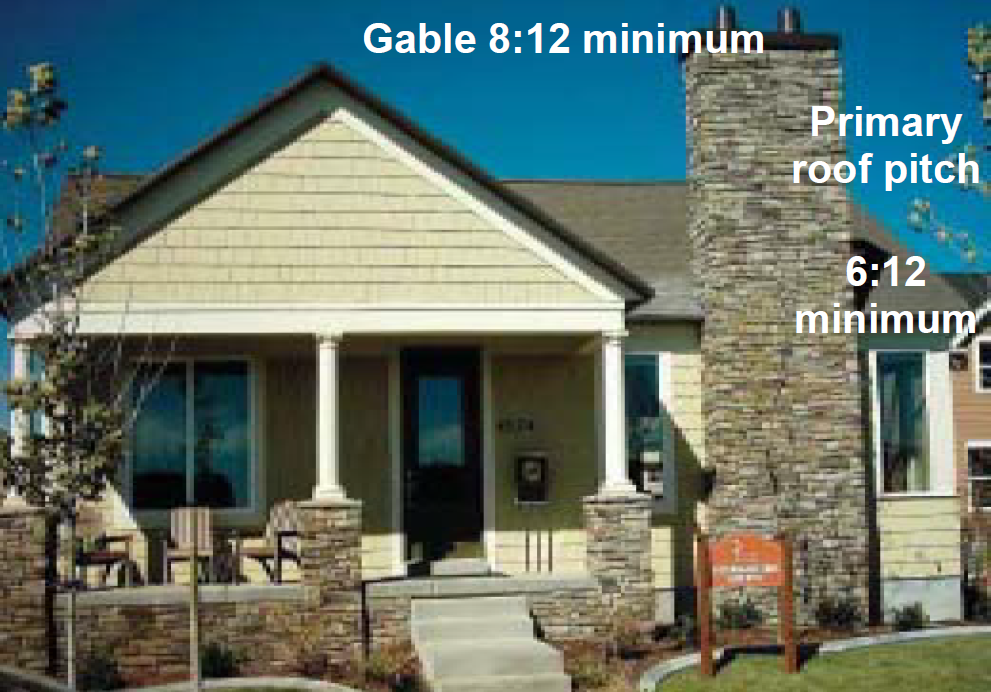
Figure 19.53.190-24
Roof forms
SL12.1.3. Roof Overhangs. Roof overhangs shall be a minimum of 12 inches, excluding gutter (see Figure 19.53.190-25).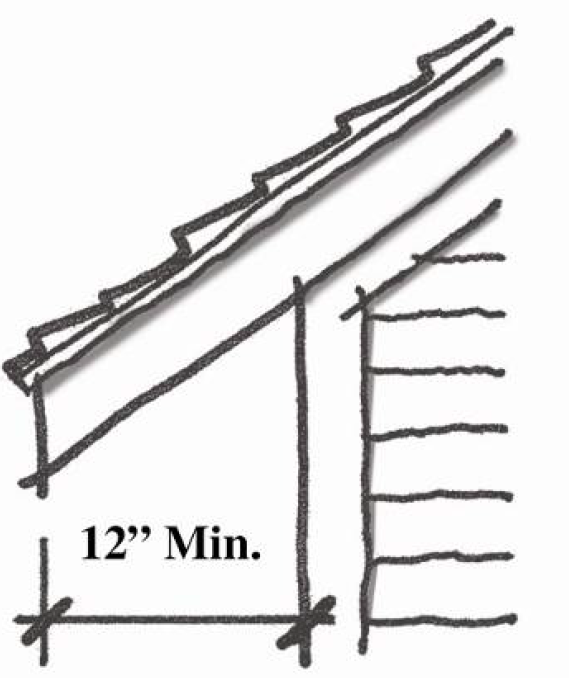
Figure 19.53.190-25
Minimum roof overhang
SL12.1.4. Roof Material. Roof material shall be fire retardant.
SL12.1.5. Roof Color. A variety of roof colors shall be used within the development.
SL12.2. Design Guidelines.
SL12.2.1. Avoid bright color, reflective roofing material.
SL12.2.2. Overhangs and eaves should be detailed and proportioned to complement the architectural style of the home. For example, eaves ranging in size from 24 to 36 inches would be appropriate for a craftsman home.
E. SL13: Materials and Colors.
Design Objective: To ensure that an appropriate range of building materials is used that enhances the quality of residential development.
SL13.1. Approval Standards.
SL13.1.1. Consistent pattern and application of exterior materials shall be used on new homes and additions in order to enhance the appearance and character in the existing neighborhood.
SL13.1.2. The combination of materials on a building facade shall be appropriate to its style and design.
SL13.1.3. Where more than one material is used, the following techniques shall be used:
a. Vertical Changes. Changes in materials in a vertical wall, such as from brick to wood, shall wrap the corners no less than 24 inches. The material change shall occur at an internal corner or a logical transition such as aligning with a window edge or chimney. Material transition shall not occur at an exterior corner (see Figure 19.53.190-26).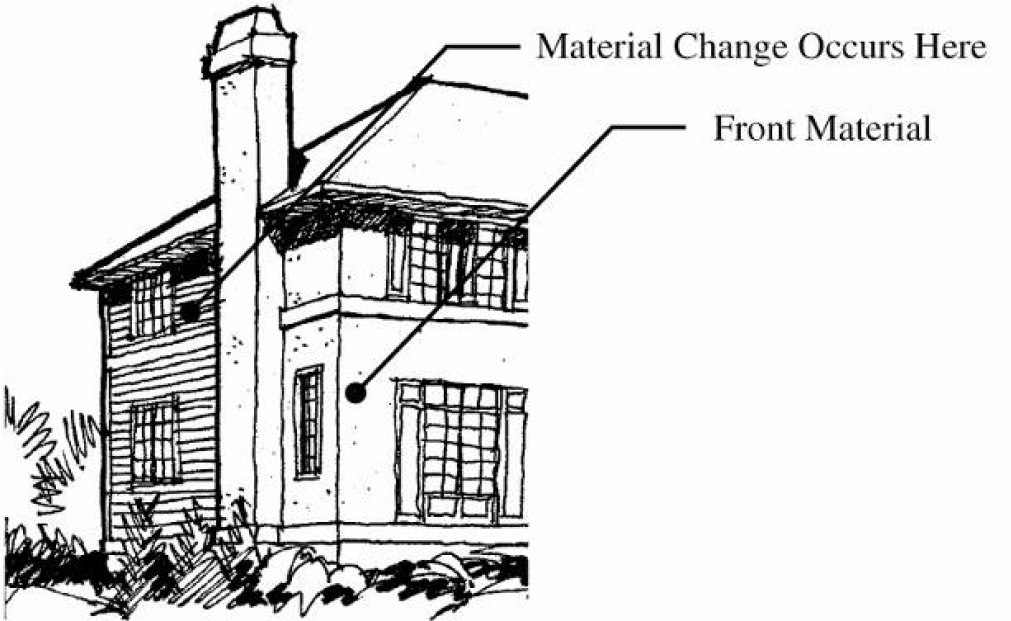
Figure 19.53.190-26
Vertical material changes
b. Horizontal Changes. Transition in material on a wall surface, such as shingle to lap siding, will be required to have a material separation, such as a trim band board (see Figure 19.53.190-27).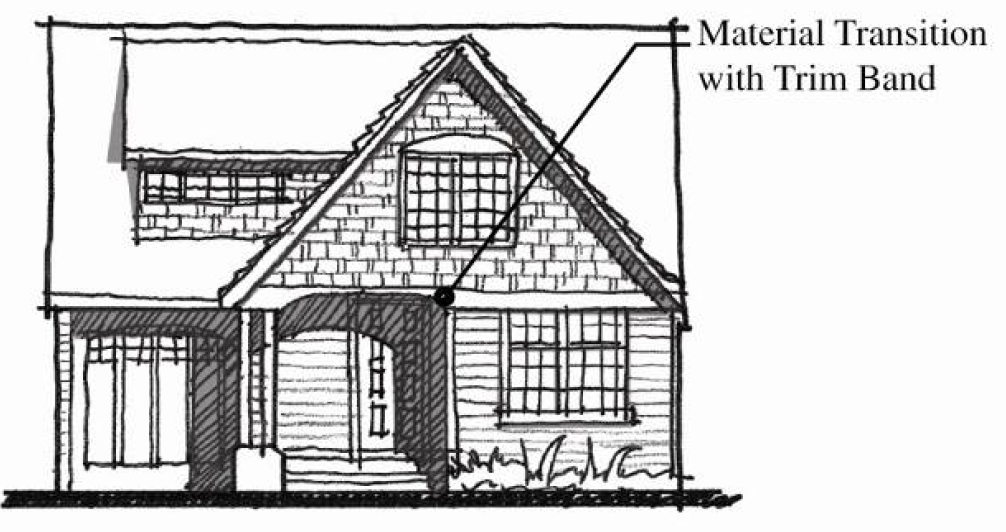
Figure 19.53.190-27
Horizontal material changes
c. Acceptable Exterior Wall Material. Wood, cement fiberboard, stucco, EIFS, brick and stone may be used. Simulated stone, wood, stone, or brick may be used to detail homes.
d. Trim may be wood, cement fiberboard, stucco, or stone materials. Trim is required around all doors and windows. The trim must be three and one-half inches wide minimum and used on all elevations.
e. Provide multiple colors on buildings to reflect material changes and individuality of the residence.
(1) Muted deeper tones, as opposed to vibrant primary colors, shall be the dominant colors.
(2) Although grey and beige are not excluded, these colors shall not be the dominant color used on homes or other structures within a development.
(3) Color palettes for all new structures, coded to the home elevations, shall be submitted for approval.
SL13.2. Design Guidelines.
SL13.2.1. Materials and colors should enhance the character and quality of residential development and be compatible with the surrounding neighborhood setting.
SL13.2.2. A variety of materials should be used to emphasize a differentiation between the various components of the building. The combination of materials on a building facade shall be appropriate to its style and design and be visually appealing to the pedestrian (see Figure 19.53.190-28).
|
|
Figure 19.53.190-28 Homes in Seabrook: All exterior building colors and materials should be subtle and compatible with the surrounding neighborhood. These homes are visually appealing to a pedestrian because of the colors and materials used in this development. |
SL13.2.3. Materials and colors should not be used to create a distinctly unique appearance for each attached unit within a single building. Materials and colors should be applied consistently to each attached unit within a building.
SL13.2.4. Accent materials should not be used as the only exterior material on a home. They may be used to add interest and variety at a more intimate scale, such as along architectural elements such as cornices, or on portions of buildings or walls or details such as trim. Accent materials include stucco, brick, ceramic tile, stone and stone veneer (see Figures 19.53.190-29 and 19.53.190-30).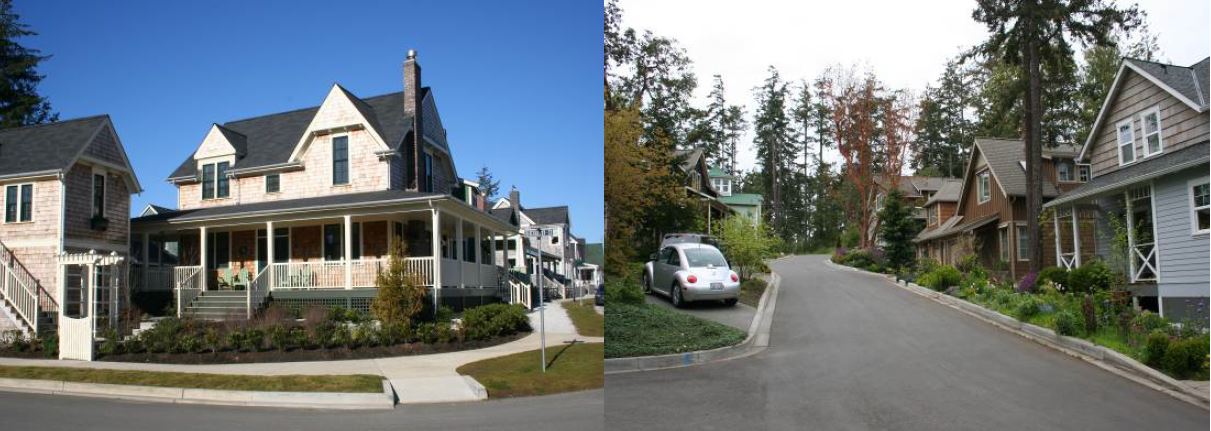
Figure 19.53.190-29
Do this
Use of accent materials to highlight architectural elements and different colors, creates variety and interest in Seabrook (left) and the Treehouse Neighborhood (right).

Figure 19.53.190-30
Do not do this
The use of a single material, stucco, and single or similar colors, has assisted in creating monotony in a neighborhood.
F. SL14: Other Design Elements.
Design Objectives: Design chimneys that reflect the architectural style of the homes. Design columns, trim work, and corner boards to add visual detail to the house, and integrate the gutters and downspouts into the home’s color scheme.
SL14.1. Approval Standards.
SL14.1.1. Chimneys above the roof shall be at least 20 inches by 24 inches as measured in the plan.
SL14.1.2. Wood-framed chimney enclosures are permitted; however, metal termination caps shall not be left exposed. These tops shall be shroud in a metal chimney surround.
SL14.1.3. Columns (see Figure 19.53.190-31).
a. Character columns shall be round, fluted, or strongly related to the home’s architectural style.
b. Exposed four-by-four- and six-by-six-inch posts are prohibited.
SL14.1.4. Corners (see Figure 19.53.190-31).
a. Beveled and mitered corners are preferred where siding is used.
b. Metal corner clips or corner boards may also be used at corners where siding is used. Corner boards shall be a minimum of two and one-half inches in width.
SL14.1.5. Gutters shall be painted or be of an integral color to closely match the body color or trim color. Gutters may also have a traditional metal appearance provided through the use of copper, aluminum, galvanized material or other metal.
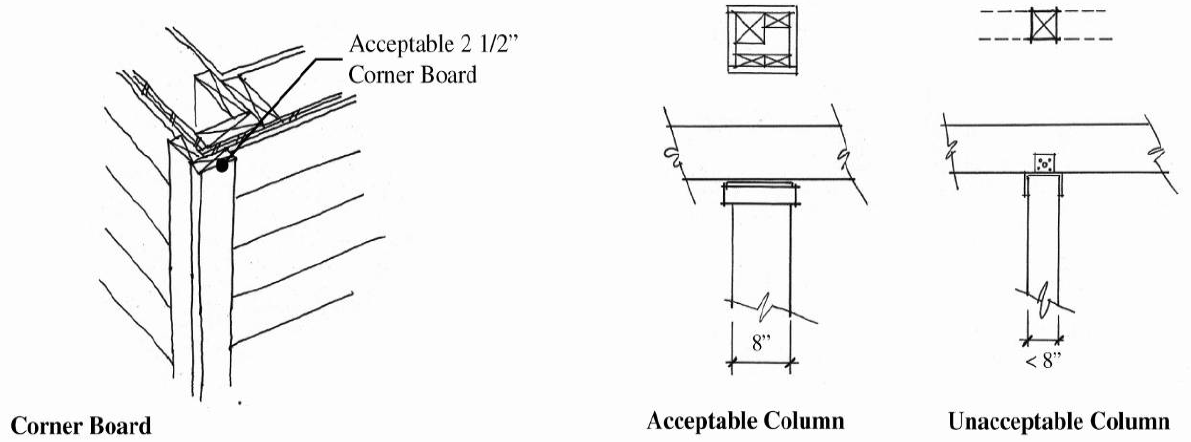
Figure 19.53.190-31
Corner boards and columns
SL14.2. Design Guidelines.
SL14.2.1. Chimney form and shape should reflect the proportions of masonry tradition. Skinny long chimneys out of concert with the house proportions or not naturally anchored into the roof forms and walls are unacceptable.
SL14.2.2. Overly stylistic chimneys are discouraged. Chimney shape and profile should appropriately reflect the stylistic direction of the rest of the house.
SL14.2.3. Columns, trim, and corner boards should reflect the architectural character of the home.
SL14.2.4. Corner boards should be painted a home’s body color to deemphasize their visibility unless a contrasting trim color is traditionally used for a particular architectural style. For example, a craftsman style home typically would deemphasize its corner boards by avoiding the use of contrasting color paint.
SL14.2.5. Gutters and downspouts should reflect the architectural character of the home. For example, half-round gutters are a traditional application for many traditional architectural designs.
G. SL15: Interior Sprinklers.
Design Objective: To enhance the safety of residents in the event of a fire.
SL15.1. Design Guidelines.
SL15.1.1. Sprinklers are encouraged to be installed in all living spaces when not otherwise required by regulation.
(Ord. 559 § 6 (Exh. A § 3(SL9 – SL15))).
19.53.200 Lighting.
SL16: Lighting.
Design Objective: To design lighting that provides safety, character and aesthetic benefits for the neighborhood, minimizes light pollution and encourages energy efficiency.
SL16.1. Approval Standards.
SL16.1.1. Exterior lighting shall be designed as an integral part of the building and landscape design. All exterior lighting shall be prevented from projecting light upward either by placement beneath building eaves or by an integral shield of the fixture’s interiors as recommended by the manufacturer.
SL16.1.2. Site plans and architectural plans shall include the location of fixtures, their design and the nature and level of the illumination they will provide.
SL16.1.3. The lighting for neighborhood streets, access lanes, alleyways, common greens, and parks shall be low intensity and shall be from the same family of fixtures.
SL16.1.4. Street lighting on neighborhood streets and access lanes within the boundary of a development shall be required.
a. Lighting facilities and fixtures shall be located outside public right-of-way unless owned, operated, and maintained by a power utility franchised by the City.
b. All street lighting fixtures shall be a maximum height of 16 feet.
SL16.1.5. Sidewalks and pathways not otherwise illuminated by street lighting shall be lit with ornamental lighting fixtures. All pedestrian lighting fixtures shall be a maximum height of 12 feet.
SL16.1.6. If alley lights are mounted on the garage, they shall be no higher than eight feet above ground and directed away from adjacent backyards and structures.
SL16.1.7. Lighting shall be limited to illumination of surfaces intended for pedestrians, vehicles, or key architectural features.
SL16.1.8. Street lights shall be placed on all internal roadways and perimeter roadways abutting the development per the design standards in UPMC 13.20.630.
SL16.2. Design Guidelines.
SL16.2.1. Illumination levels should be provided to address security concerns, especially for parking lots, pedestrian paths, outdoor gathering spaces, at building entries and any other pedestrian accessible areas.
SL16.2.2. The light source for externally illuminated signs should be positioned so that light does not shine directly on adjoining properties, cause glare, or shine in the eyes of motorists or pedestrians.
SL16.2.3. Lighting should relate to the pedestrian scale of residential neighborhoods and should be considered a design element, rather than simply utilitarian. It should contribute to the character of development and should not impact adjacent development (see Figures 19.53.200-1 and 19.53.200-2).
SL16.2.4. Lighting sources should be kept as low to the ground as possible while ensuring safe and functional levels of illumination.
SL16.2.5. Area lighting should be directed downward or employ control features to avoid light being directed off site as well as to avoid lighting of the night sky.
SL16.2.6. In general, the location of lighting should respond to the anticipated use and not exceed the amount of illumination required by users.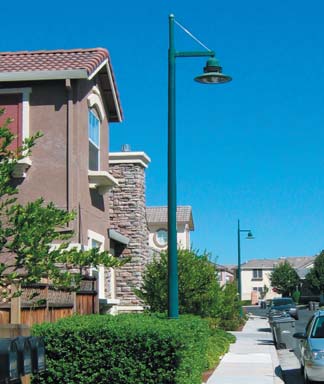
Figure 19.53.200-1
Encouraged: Pedestrian-scaled decorative light fixtures add to the intimacy and character of a neighborhood.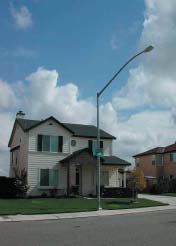
Figure 19.53.200-2
Strongly discouraged: oversized utilitarian fixtures such as this “cobra head” example, which is out of scale with the surrounding homes and lends little character to the neighborhood.
SL16.2.7. Illumination over an entire area or the use of overly bright lighting is strongly discouraged. The use of a number of smaller lights (like bollard lighting) is preferable to larger, more intense lights (cobra head light fixtures).
SL16.2.8. Lighting for pedestrian movement should illuminate changes in grade, path intersections and other areas along paths which, if left unlit, would cause the user to feel insecure. Recommended minimum levels of illumination along pedestrian paths between destinations is 0.5 foot-candles. At pedestrian destination points such as entryways, plazas and courtyards, lighting levels should typically achieve illumination of one foot-candle.
SL16.2.9. The placement of light standards, whether for street lights or garden lights, should not interfere with pedestrian movement. Illumination should be concentrated along the pedestrian paths leading to parking areas and in the specific areas where cars are parked.
SL16.2.10. In order to conserve energy and reduce long-term costs, energy-efficient, Energy Star-certified lamps should be used for all lighting, and hours of operation should be monitored and limited to avoid waste. Low voltage lighting, and lighting activated through the use of photocells, motion sensors and automatic timers, should be used where feasible.
(Ord. 559 § 6 (Exh. A § 3(SL16))).
Article IV-B. Multifamily Developments
19.53.210 Purpose and organization.
Multifamily developments are residential projects, with three or more units per building and multiple units on one parcel. Multifamily developments can be designed to accommodate rental or owner-occupied units (see Figure 19.53.210-1).
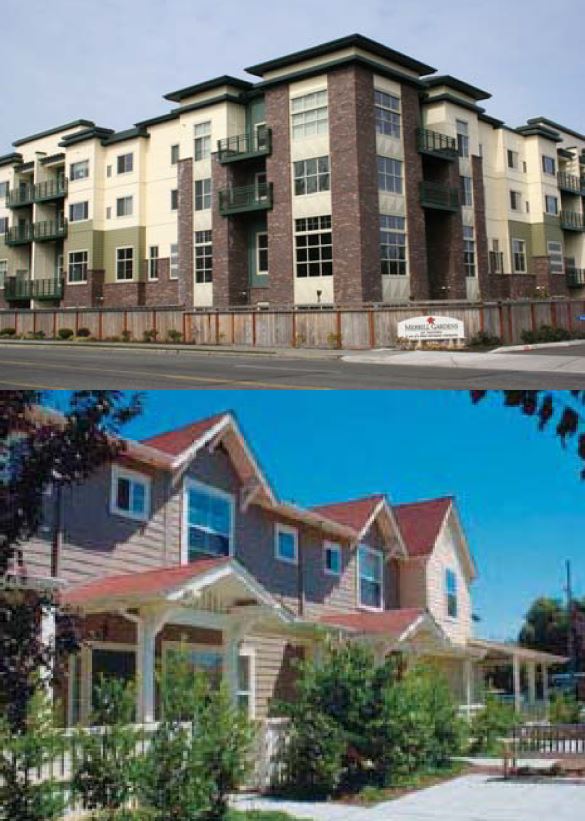
Figure 19.53.210-1
Examples of small and large multifamily projects. Entrances are accentuated and the roofline is broken up to reduce the potential for monotony. Units are configured vertically, rather than horizontally, creating many views onto the street. Balconies provide private usable open space. A variety of complementary exterior finish materials is used to create visual interest.
These guidelines and standards are intended to: improve site planning to enhance the image of the City, reflect unique site characteristics, and provide strong neighborhood environments; develop site plans that preserve and integrate healthy and mature existing trees into the overall development scheme to establish optimum environmental conditions by providing shade, air purification, management of stormwater runoff, and other benefits; protect natural features and open space as much as possible to maintain the local character, and use and incorporate such features and areas as community amenities; and provide useable open space, or maintain significant natural areas, for the use and enjoyment by residents of the multifamily development.
Three design elements for multifamily development are listed below. Each element includes specific approval standard(s) and corresponding design guidelines to ensure that qualifying multifamily projects meet the City’s design expectations.
Design Element 1: Site Planning and Design.
Design Element 2: Building Design.
Design Element 3: Lighting.
(Ord. 559 § 6 (Exh. A § 3(B))).
19.53.220 Site planning and design.
A. MF1: Building Siting and Orientation.
Design Objective: Ensure that buildings relate appropriately to surrounding developments and streets; create a cohesive visual identity for the neighborhood and attractive street scene; promote efficient site layout in terms of vehicular and pedestrian circulation; and fit within the context of low impact development design.
MF1.1. Approval Standards.
MF1.1.1. Building Organization.
a. Multifamily buildings shall be clustered or grouped to form neighborhoods.
b. Multifamily buildings shall be organized around a common open space, public open space (e.g., a greenway), natural features located on the site (e.g., a stream corridor), or community amenities such as swimming pools or other recreational facilities. To the extent practicable, buildings should be oriented or arranged in a manner to enclose required common open spaces.
MF1.1.2. Building Orientation and Placement.
a. Individual buildings within a multifamily development shall be oriented to primary perimeter streets, including thoroughfares, or boundaries; or through-access drives. Specifically:
i. Pedestrian building entrances shall face the street and be clearly visible from the street.
ii. Buildings shall not present blank walls lacking articulation, modulation, or window and door openings, to streets, access drives or parking areas (see Figure 19.53.220-1).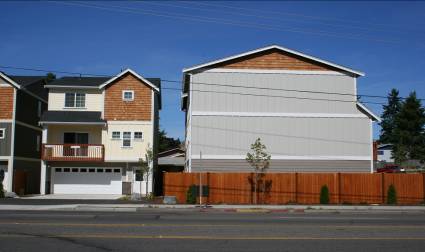
Figure 19.53.220-1
Undesirable: Buildings with blank walls or with lack of articulation facing the street
iii. Building entries that face onto a common open space that is oriented towards the street are acceptable.
iv. Buildings shall also provide windows that face the street to provide “eyes on the street” for safety (see Figure 19.53.220-3). See UPMC 19.53.230(D), MF10: Windows and Doors, Porches and Balconies, for specific requirements.
b. Placement of buildings shall consider the existing context of the surrounding area. Multifamily developments shall respect privacy and solar access through appropriate siting of structures. Building setbacks around the perimeter of the site shall be consistent with the development standards of the underlying zoning district.
MF1.1.3. Privacy Assurance. When any portion of a building or structure within a multifamily development is located adjacent to property used or zoned for lower density residential, the following standards shall apply to ensure the privacy of nearby residents:
a. To the maximum extent practicable, multifamily structures with fewer units or structures with one-story “end” units should be situated adjacent to property with low density residential uses (see Figure 19.53.220-2).
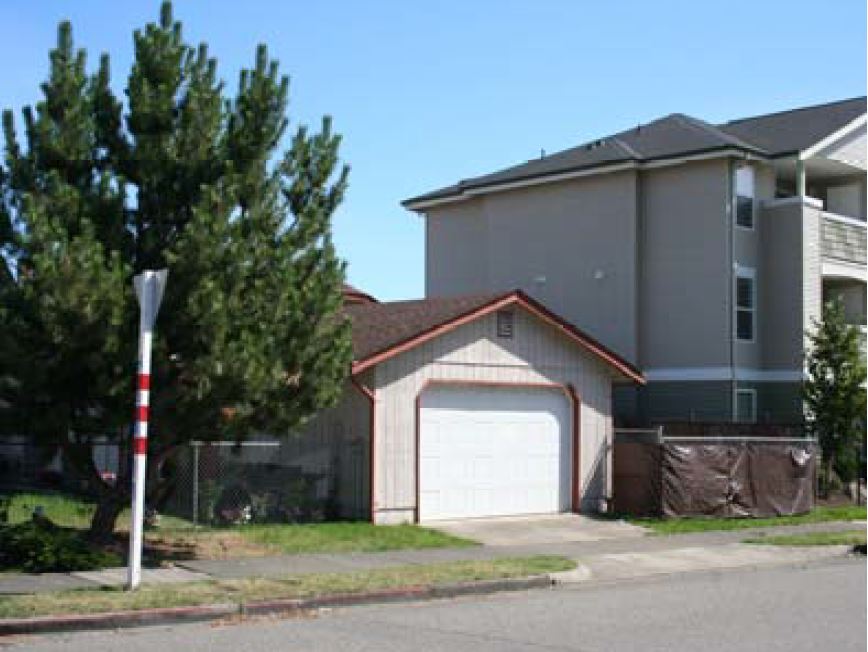
Figure 19.53.220-2
Desirable: Multifamily structures with fewer units or structures with one-story “end” units should be situated adjacent to property with low density residential uses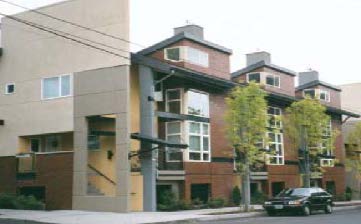
Figure 19.53.220-3
In this multifamily project, units are configured vertically, rather than horizontally, creating many views onto the street.
b. Accessory structures, including garages and recreational facilities, shall be set back at least 25 feet from the adjacent low density residential uses, and the developer shall provide a buffer between the structure and adjacent property. The buffer may be a fence, wall, heavy landscaping, or combination thereof. Fences and walls used for buffer purposes shall be a maximum of six feet in height, with finished side facing out.
MF1.2. Design Guidelines.
MF1.2.1. Residential development adjacent to designated open space areas should maintain visual access to the open space from residential units, common buildings, and/or streets (buildings should not back up to open space areas creating areas hidden from public view). Projects should also provide for future connections to currently undeveloped properties via public or private streets, internal drives and biking and walking trails.
MF1.2.2. Multifamily projects should be placed along the street or at street intersections with views from the units onto the street (see Figure 19.53.220-3).
MF1.2.3. Building Orientation to Street Edges.
a. Buildings along a public street should be oriented to avoid multiple parallel orientations to a public street (see Figure 19.53.220-4). Instead, a variety of building orientations, including perpendicular and canted, or intervening open spaces should be provided to lessen the mass of buildings along the street.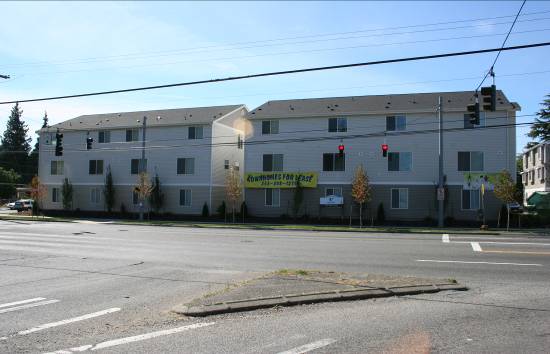
Figure 19.53.220-4
Undesirable: Buildings with multiple parallel building orientations with rear elevations facing street
b. Multiple buildings may line up parallel to a public street if:
i. A building entrance faces the perimeter street;
ii. Individual building length along the street frontage is a maximum of 100 feet; and
iii. Common open space is centrally located in the interior of the site and accessible by all units.
B. MF2: Grading and Stormwater Management.
Design Objective: To minimize modifications to topography, preserve existing vegetation whenever possible, minimize the creation of impervious surfaces, and maximize stormwater infiltration within the development site and minimize the amount of stormwater that is transferred off site through the use of LID techniques.
MF2.1. Approval Standards.
MF2.1.1. Structures, roadways and other site improvements (drainageways and storage areas) shall be designed to blend with the natural topography, with a minimum of site disturbance and grade changes.
MF2.1.2. LID techniques shall be used to the maximum extent feasible, as determined by a development site’s soil characteristics, to maximize stormwater infiltration within the site and minimize the amount of stormwater that is transferred off site.
MF2.1.3. Stormwater facilities that are required to supplement LID facilities may include either stormwater ponds or underground vaults. Stormwater ponds shall be designed as a landscape amenity and planted with grass or native plants (see Figure 19.53.220-5). Stormwater ponds shall be privately owned and maintained, shall not be fenced, and shall not exceed a four horizontal to one vertical slope. Stormwater ponds may be used to meet open space requirements if designed utilizing the KCSWDM.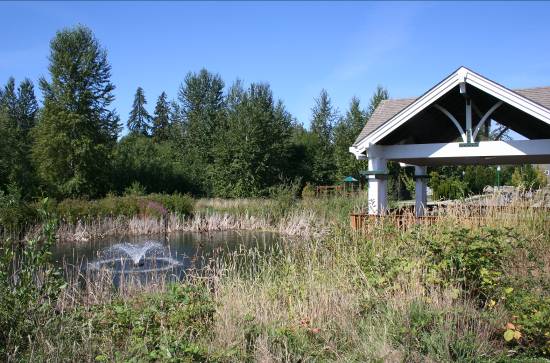
Figure 19.53.220-5
Usable storm pond with gazebo in public open space at the Commons in Fircrest
MF2.1.4. Filling and grading shall be done in accordance with Chapter 13.25 UPMC and the King County Surface Water Design Manual (KCSWDM) to control stormwater runoff impacts to adjacent properties.
MF2.2. Design Guidelines.
MF2.2.1. Multifamily developments should integrate existing natural features, required open space, and existing historic structures or cultural resources located on site into the overall design and layout of the development. Existing natural features, as well as the required common open space, should be used to create community amenities and provide physical separations and buffers from adjacent development, where needed. The site plan should reflect natural hydrology and minimize impervious surfaces.
a. Preserve or design into the infrastructure naturally vegetated areas that are in close proximity to parking areas, buildings, and other impervious expanses in order to slow runoff, filter out pollutants, and facilitate infiltration.
b. Direct runoff into or across vegetated areas to help filter runoff and encourage groundwater recharge.
c. Use native plants (or adaptable species) to establish an adaptable and low maintenance landscape that requires less irrigation and is appropriate for the climatic conditions.
d. Use devices such as bioretention cells, vegetated swales, infiltration trenches, and dry wells to increase storage volume and facilitate infiltration.
e. Plant bioswales with native grass to further improve water quality. Bioswales are encouraged throughout the development to treat runoff, improve water quality, and minimize or eliminate the size of detention ponds (see Figure 19.53.220-6). 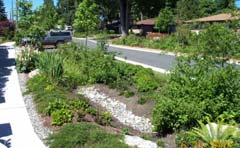
Figure 19.53.220-6
Vegetated bioswale
f. Disconnect impervious areas from the storm drain network and maintain natural drainage divides to keep flow paths dispersed. Maximize infiltration using: biofilters, green strips, swales and permeable materials in lieu of hardscapes.
g. Incorporate perennial streams, wetlands, and associated riparian corridors into site plans and site design as major amenities, with trails, seating, and appropriate supplemental vegetation. Buildings, parking areas, and other structures should be set back from such features a sufficient distance to ensure their continued quality and natural functions (see Figure 19.53.220-7).
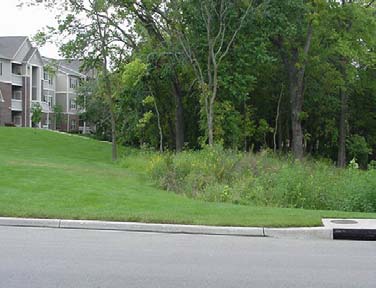
Figure 19.53.220-7
Perennial streams, wetlands, and associated riparian corridors shall be incorporated into the overall site design of multifamily development
MF2.2.2. Surface water and pollutant runoff should be reduced by maximizing the use of pervious surfaces and vegetative groundcover.
a. Use of permeable paving, pavers, turf stone, brick, and decomposed granite is encouraged.
b. Use of natural topographic features or built swales for filtration of site drainage is encouraged.
c. Porous concrete, porous paving stones, reinforced turf, crushed gravel with soil stabilizers, and paving blocks with planted joints are examples of acceptable materials that can be used for driveways, pathways, sidewalks, and patios.
MF2.2.3. To the maximum extent feasible, the layout of multifamily developments shall follow and respect the natural topography of the site. Berms, channels, swales, and similar man-made changes to the landscape shall be designed and graded to be an integral part of the natural landscape and to provide a smooth transition in changes of slope.
MF2.2.4. Existing trees and vegetation should be preserved whenever possible to act as buffers between adjoining developments and as community amenities within the development per Chapter 19.65 UPMC (see Figure 19.53.220-8). Buildings, parking areas, and other structures should be set back from such features a sufficient distance to ensure their continued quality and natural functions.
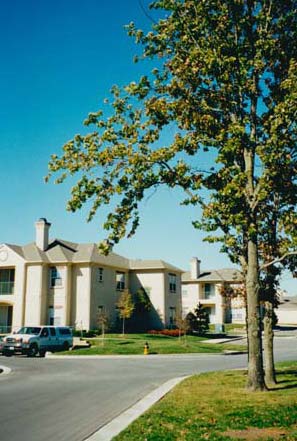
Figure 19.53.220-8
Existing trees and vegetation should be preserved whenever possible
MF2.2.5. The “effective” impervious surface should be minimized to the extent practicable while achieving urban densities consistent with the goals of accommodating multifamily development and expanding housing choice in the community.
C. MF3: Parking.
Design Objective: To ensure that parking areas do not dominate the views of residential development from public streets and sidewalks.
MF3.1. Approval Standards.
MF3.1.1. Carports, parking areas and parking structures shall be internalized in building groupings or oriented away from street frontage.
MF3.1.2. Parking areas and freestanding parking structures (detached garages or carports) shall not occupy more than 30 percent of each public street frontage. Freestanding parking structures that are visible from public streets shall be sited to be perpendicular to the street to reduce visual impacts on the streetscape. Blank walls lacking windows, articulation or modulation are not permitted when facing a street (see Figure 19.53.220-9).
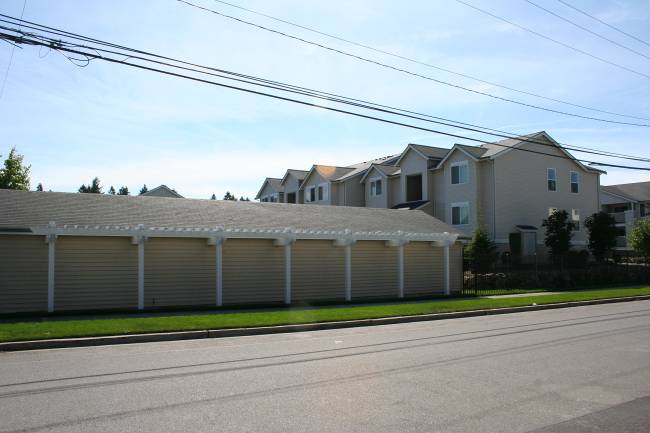
Figure 19.53.220-9
Undesirable: Shared detached garage is oriented parallel to the street and presents blank wall to the sidewalk
MF3.1.3. Total number of required parking spaces shall be broken up into smaller “blocks” of parking, with no more than 10 parking spaces per parking block (see Figure 19.53.220-10).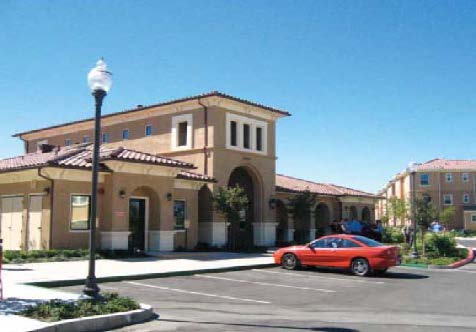
Figure 19.53.220-10
Desirable: Parking for this multifamily project is broken into smaller parking “blocks” with direct access to buildings
MF3.1.4. Parking garages and driveways shall not dominate the streetscape and substantially diminish or eliminate on-street parking (see Figures 19.53.220-11 and 19.53.220-12). They shall be designed and sited to complement, not subordinate, the pedestrian entry.
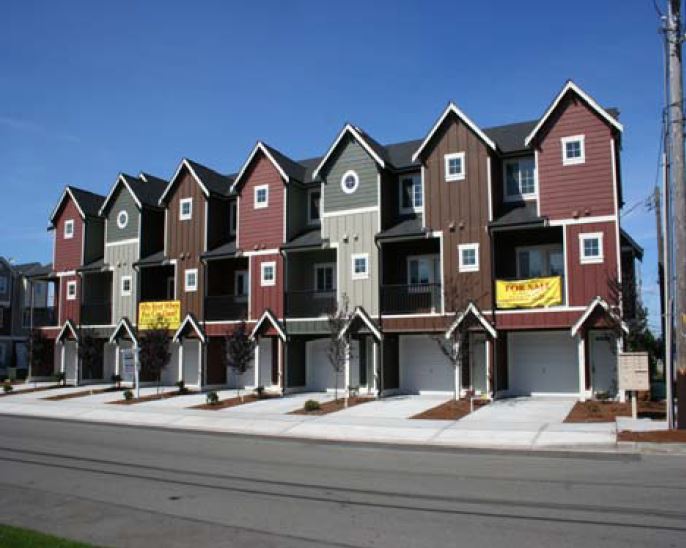
Figure 19.53.220-11
Undesirable: Parking is the dominant feature when viewed from the street. The ground floor building facade is devoted mostly to garage doors and the frontage has a continuous driveway apron with no curbside parking.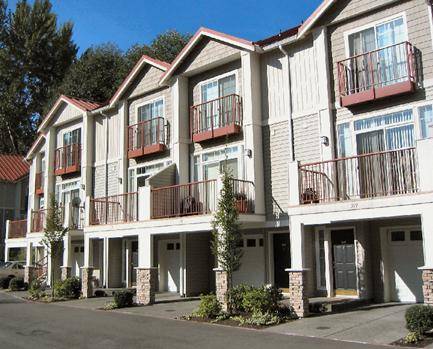
Figure 19.53.220-12
Desirable: These garages face an internal driveway and are deemphasized through the use of overhanging balconies, landscaping and accent building elements and materials. The tandem parking configuration of the garages also limits their visibility.
M3.2. Design Guidelines.
MF3.2.1. Design and locate parking areas such that the walk from the designated parking to the dwellings is short and direct. Ideally, residents will be able to view their parking stalls from their residence. All resident and visitor parking spaces shall be clearly identified.
MF3.2.2. Buffer residential units from the parking lot by:
a. Providing a landscaped screen with a minimum height of three feet (berm, hedge, wall, or other);
b. Providing a minimum 10-foot-wide landscaped area between paved areas and residential units.
MF3.2.3. Use a combination of on-street and off-street parking for multifamily development. Parallel parking along local streets within multifamily projects is strongly encouraged (see Figure 19.53.220-13).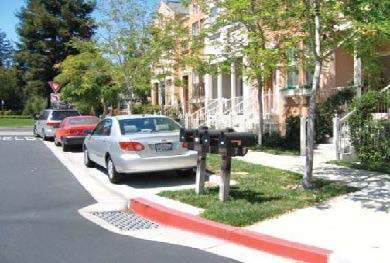
Figure 19.53.220-13
Desirable: Parking along the primary access road is accommodated with pop-ins that take the cars out of the roadway to allow for better circulation and reduced right-of-way width. A landscaping strip is placed between the parking area and the sidewalk to protect the pedestrians.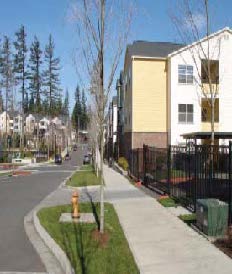
D. MF4: Common Open Spaces.
Design Objective: To create areas of common open space that are easily accessed by residents; provide focal points for community recreation and interaction and add to the overall quality of life for residents. Given the environmental and recreational benefits of common open space, it should be integrated purposefully into the overall design of a development and not merely be residual areas left over after buildings and parking lots are sited.
MF4.1. Approval Standards.
MF4.1.1. All new developments shall set aside a percentage of the net site acreage as common open space for the use and enjoyment of the development’s residents. The common open space shall be aggregated into meaningful, quality open spaces. The minimum amount of open space (as a percentage of net land area) shall be 17 percent.
MF4.1.2. Open space areas shall be clearly identified on the development plan. Such designated common open space may be in a natural, undisturbed state, landscaped for more formal courtyards or plazas, or developed for active or passive recreation. Common outdoor spaces shall provide at least six of the following amenities to accommodate a variety of ages and activities. Amenities include:
a. Site furnishings (benches, tables, bike racks);
b. Picnic areas;
c. Patios or courtyards;
d. Gardens;
e. Open lawn with trees;
f. Play field;
g. Special interest landscape;
h. Pedestrian scale, bollard, or other accent lighting;
i. Special paving, such as colored or stained concrete, stone, brick or other unit pavers;
j. Public art;
k. Water feature(s);
l. Sports courts such as tennis, basketball, or volleyball.
MF4.1.3. The use of LID materials, if appropriate to the site conditions, is required.
MF4.1.4. Rocks, pebbles, sand, and similar nonliving materials shall not be used as groundcover substitutes, but may be used as accent features provided such features do not exceed a maximum five percent of the total landscape area.
MF4.1.5. All common open space lands shall meet the following design criteria, as relevant (see Figure 19.53.220-14):
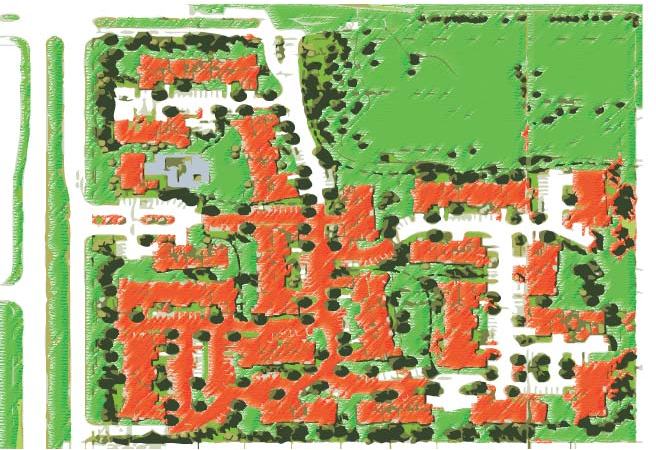
Figure 19.53.220-14
Multifamily developments shall be organized around a common open space, public open space, natural features located on the site, or community amenities such as swimming pools or other recreational facilities.
a. Compact and Contiguous. To the maximum extent practicable, common open space land shall be compact and contiguous unless the land is used as a continuation of an existing greenway, trail, or other linear park, or unless specific topographic features require a different configuration. An example of such topographic features would be the provision of open space along a scenic creek.
b. Connectivity Required. Common open space shall be organized to create integrated systems of open space that connect with the following types of lands located within or adjacent to the development:
i. Dedicated public park or greenway lands;
ii. Dedicated school sites;
iii. Other dedicated open spaces;
iv. Common open space located adjacent to the development;
v. Portions of the regional trail and open space system;
vi. Neighborhood shopping and activity centers; and
vii. Adjacent employment centers.
c. Accessible to Residents. Common open space shall be accessible to all residents of the development.
d. Open Space Placement. A variety of common open spaces shall be provided throughout the neighborhood in the form of parks, common greens, pocket parks, and pedestrian easements.
i. At a minimum, pedestrian access to common open space shall occur every 500 feet of linear length of common open space.
ii. Pedestrian access to common open space shall occur within 500 feet of every dwelling unit in the development.
iii. The City may require access to be restricted if it would degrade, destroy, or adversely interfere with sensitive environmental or natural areas or with significant historic or cultural resources.
iv. Where provided, access to common open space shall be a minimum of 20 feet wide and located where such access is visible to dwelling units. Access ways shall not be isolated by walls, screening, landscaping, or any other kind of barrier that would prevent resident surveillance of the open space.
e. Fences/Walls on Perimeter. Where common open space is bordered by private rear or side yards, opaque fences and walls shall not be erected in such yards bordering the open space. Open style fences, with a maximum 50 percent opacity for each 100 feet of fence length (e.g., post and rail), shall be allowed on the perimeter of open space.
MF4.1.6. Community amenities and features such as picnic areas and tot lots offer convenient and inviting spaces for residents to gather for recreational activities. Community amenities shall provide areas for passive and active recreation, enhance the overall quality of development, and contribute to the character of the area. Community amenities shall be privately maintained.
MF4.2. Design Guidelines.
MF4.2.1. Common open space areas should be readily accessible from all buildings with the maximum number of units possible sited adjacent to the common open space areas.
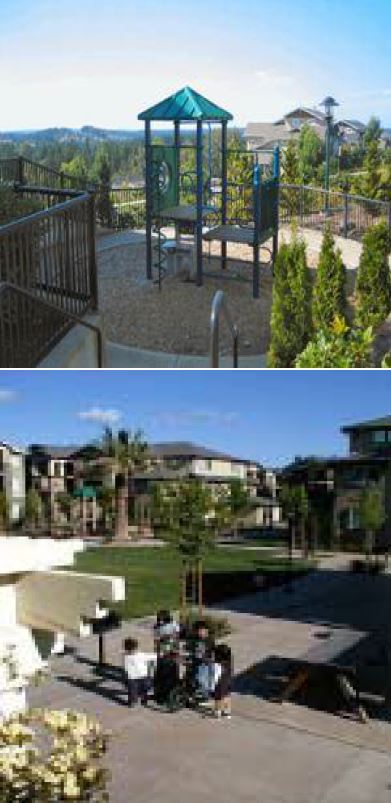
Figure 19.53.220-15
Common open space area providing space for human interaction and play
MF4.2.2. In addition to the common open space areas, projects should be encouraged to provide each unit with usable private open space. These private spaces should be directly accessible from the unit and large enough to permit outdoor living activities (see Figure 19.53.220-15).
E. MF5: Accessory Structures.
Design Objective: To minimize the impact of utility locations.
MF5.1. Approval Standards.
MF5.1.1. The design of the mailboxes and mailbox enclosures shall be consistent with the architectural style of the development and shall match the colors and materials of other on-site buildings.
MF5.1.2. All mailboxes shall be clustered and lockable consistent with U.S. Postal Service (USPS) standards. Clustered mailboxes shall be architecturally enhanced with materials and details typical of nearby multifamily development architecture and carefully placed to not adversely affect the privacy of residents and serve the needs of the USPS (see Figure 19.53.220-16).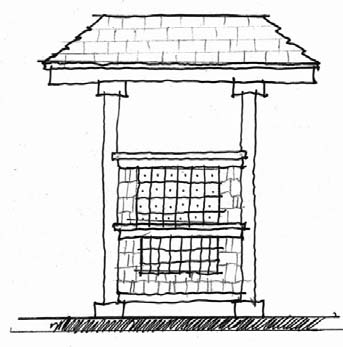
Figure 19.53.220-16
Mailbox design
MF5.1.3. Trash enclosures shall be of sufficient size to house the number and size of trash bins and containers needed to accommodate the waste generated by the building user, including trash, cardboard, cans and bottles, food waste, green waste and other recyclables.
MF5.1.4. Trash bins shall be located within a trash enclosure at all times.
MF5.1.5. Trash enclosures shall be integrated into the site plan to minimize enclosure visibility and accommodate truck access.
MF5.1.6. Trash enclosures shall be constructed of durable materials and the color, texture, and architectural detailing shall be consistent with the overall site and building design.
MF5.1.7. Backflow prevention devices shall be included in the plans for design review and shall be screened from public view by the use of landscaping, berms, low walls and other such screening devices.
MF5.2. Design Guidelines.
MF5.2.1. Mechanical equipment, trash enclosures and utilities should be provided with architectural enclosures or fencing, sited in unobtrusive locations, and screened by landscaping.
MF5.2.2. Trash enclosures should be located away from public view. Landscaping should be provided around trash enclosures to soften views wherever feasible.
MF5.2.3. Trash enclosures should be located away from adjacent parcels to minimize noise and odor impacts typically associated with garbage collection and storage.
MF5.2.4. Screening of the trash enclosure should be integrated into the overall site and building design. Screening should be constructed of durable materials. All structural screening should be supplemented with landscaping.
MF5.2.5. Roofs of enclosures should be designed to complement the project buildings’ roof style and colors.
MF5.2.6. A building wall may be used as one side of a trash enclosure. Enclosures should be located and designed to facilitate users’ convenience. Person doorways should be provided in addition to the gate opening.
MF5.2.7. A smaller number of larger gate openings should be designed, instead of more numerous small gate openings.
F. MF6: Signage.
A. Design Objective: To create signs that are architecturally attractive and integrated into the overall site design. Signs that are compatible with the surroundings and effectively communicate a message will promote a quality visual environment.
B. Approval Standards and Design Guidelines. All multifamily developments shall comply with the signage requirements set forth in Chapter 19.75 UPMC.
MF6.1. Signage contributes to the development’s identity as a unique environment. Professionally designed, creative signage is strongly encouraged, especially for internal directions and building identification.
MF6.2. Clear legible entry signage shall be provided to identify the development. Internal circulation signage and visitor parking areas should also be clearly indicated. A directory that shows the location of buildings and individual dwelling units within the development is encouraged.
MF6.3. Building numbers and individual unit numbers shall be readily visible from the nearest street or access way, in a consistent location, well lit at night, and compatible with the overall design of the development.
(Ord. 559 § 6 (Exh. A § 3(MF1 – MF6))).
19.53.230 Building design.
A. MF7: Mass, Scale and Form.
Design Objective: To encourage residential development that is scaled to the pedestrian and is compatible with surrounding properties.
MF7.1. Approval Standards.
MF7.1.1. Multifamily building design shall incorporate visually heavier and more massive elements at the building base, and lighter elements above the base. A second story, for example, should not appear heavier or demonstrate greater mass than the part of the building supporting it.
MF7.1.2. The massing of larger residential buildings shall be broken down to convey a sense of “home,” and give individuality to each unit that lies within it. Design techniques to reduce mass include:
a. Articulation such as dormers, overhangs, balconies, wall projections, and porches;
b. Varied roof form as appropriate to the style of the building, such as: hipped roofs, gabled roofs, varying roof pitches, and roof dormers;
c. Material changes to create variations; and
d. Staggered and jogged unit plans.
MF7.1.3. Building massing shall be subdivided into portions or segments compatible with the adjacent residential scale.
MF7.1.4. Facades of long buildings shall be architecturally subdivided into shorter segments every 25 to 50 feet maximum, using the methods identified in the design guidelines, below.
MF7.1.5. Each vertical module of units shall incorporate architectural features that help to individually distinguish them, such as wall breaks, projections, distinct color schemes and individual roof treatments.
MF7.1.6. Roof profiles shall define the form, scale and proportion of the building and reduce bulk.
MF7.2. Design Guidelines.
MF7.2.1. Building design should resemble the scale of single-family residential architecture as much as possible, and units should be differentiated by using one or more of the following methods:
a. Separate building volumes or facade protrusions.
b. Window bays or balconies.
c. Porches and entrance vestibules.
d. Individual roof volumes and other roof articulation.
MF7.2.2. Building facades should incorporate the following features to architecturally distinguish modules of housing units (see Figure 19.53.230-1):

Figure 19.53.230-1
Examples of building modulation through vertical architectural features, offsetting portions of buildings or individualized roof forms
a. Vertical Architectural Features.
i. Apply a vertical slot or recess between facade segments with a six-inch minimum recess depth and a 15-inch minimum width.
ii. Apply a vertical pilaster between facades with a three-inch minimum protrusion and a 15-inch minimum width.
iii. Project a part of the building, such as a tower, above the main building volume.
b. Building Wall.
i. Vary the offset of portions of the building along the main facade, using elements such as bays or building volumes to create the offset.
ii. Change the color or material of segments across the facade. Material changes should always be accompanied by a change in plane and separated by framing or other means.
c. Individualized Roof Forms.
i. Use individual roof pitches to break up the form. For example, a single building could express individual units through a series of smaller gabled dormers.
ii. Subdivide flat roofs into recognizable segments with shifts in height and cornice treatments at street facades.
MF7.2.3. When located adjacent to one- or two-story single-family homes, the design of multi-unit structures along the project edge should be designed to transition in scale (see Figure 19.53.230-2). Building massing should be legible as individual residences or small groups of units. This can be achieved by: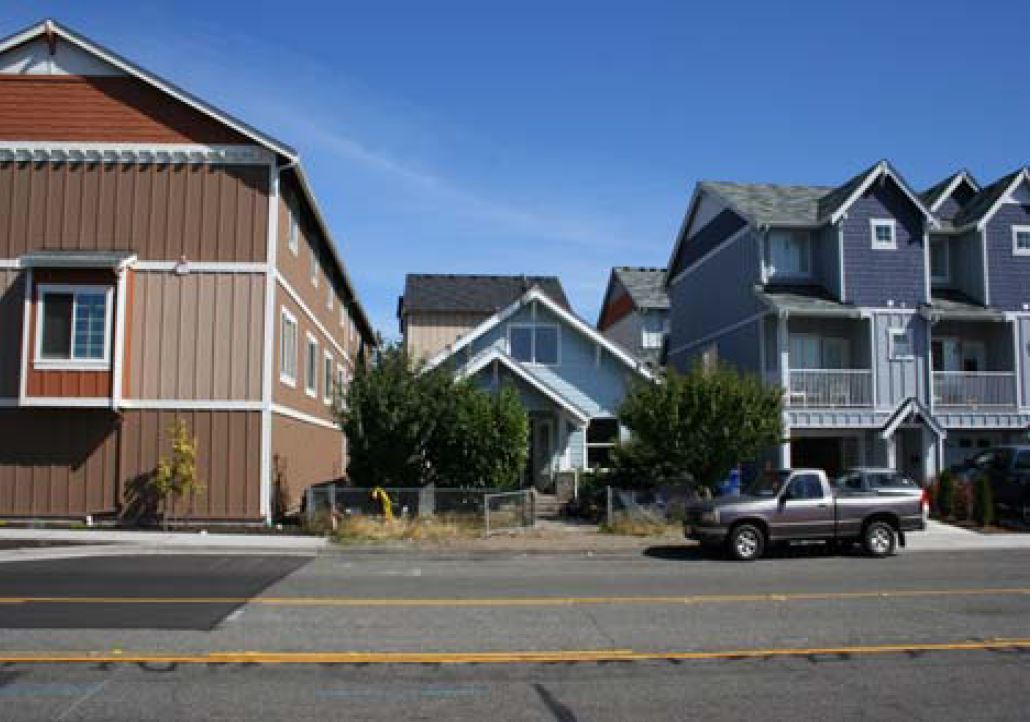
Figure 19.53.230-2
Poor transition: Newer multifamily homes surround an existing single-family dwelling, causing architectural disparity as well as loss of privacy for the single-family home.
a. Subdividing perimeter buildings into segments compatible with adjacent residential scale (e.g., upper story setbacks);
b. Accentuating the ground floor of the building by making it thicker or more substantial visually than upper stories;
c. Using entry porticos and front porches or other articulation at the ground level;
d. Using upper story setbacks or partial indentations for upper story features, such as balconies, outdoor moldings or cornices, to accentuate the horizontal levels of a building;
e. Separate building volumes or facade protrusions; and
f. Individual roof volumes and other roof articulation (see Figures 19.53.230-3 and 19.53.230-4).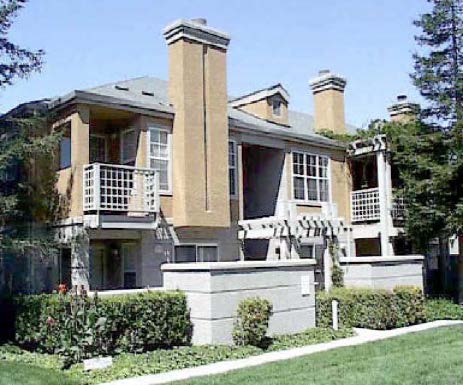
Figure 19.53.230-3
Individual residences are articulated through the use of variation in the massing, recessed balconies, wall breaks and varying roof forms.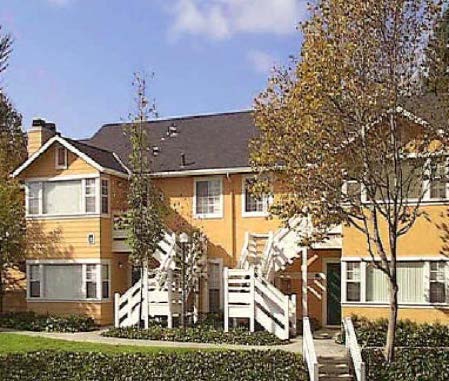
Figure 19.53.230-4
Individual residences are articulated through the building volumes and entrance areas.
B. MF8: Architectural Style.
Design Objective: To ensure that residential design contributes to the overall architectural character of University Place.
MF8.1. Approval Standards.
MF8.1.1. Architectural style of the building shall enhance the character of the neighborhood.
MF8.1.2. The architectural form of the building shall be carefully designed to articulate the style of the building.
MF8.2. Design Guidelines.
MF8.2.1. New multifamily developments shall be designed with an identifiable architectural style that enhances the character of the existing neighborhood. Additions to existing buildings should be designed to be compatible with the architectural style of the existing building and surrounding neighborhood. (Please refer to “A Field Guide to American Houses” by Virginia and Lee McAlester.)
MF8.2.2. Building articulation and building elements (architectural style, roof shape, materials and window type) should be appropriate to the building style and massing (see Figures 19.53.230-5 and 19.53.230-6).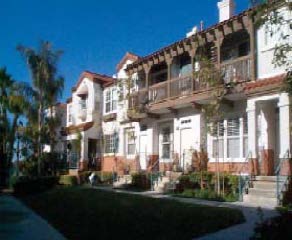
Figure 19.53.230-5
Do this
This multifamily building includes a lot of architectural detailing. This helps break up the mass of the project and create a streetscape that is interesting to pedestrians.
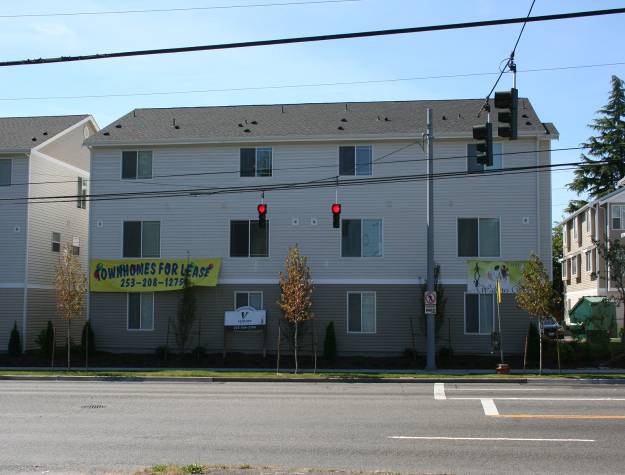
Figure 19.53.230-6
Do not do this
This multifamily project lacks architectural style and detailing. The building appears massive and uninviting as it backs onto the street.
C. MF9: Facades and Entries.
Design Objective: To provide a distinctive, quality, architectural character in new multifamily developments. In particular, architectural details help to reduce the visual scale of large multifamily buildings and ensure that residential development relates to the human scale, facilitates opportunities for pedestrian activity on adjoining public streets and contributes to a community-oriented character for residential neighborhoods.
MF9.1. Approval Standards.
MF9.1.1. All building entries adjacent to a collector or residential (local) public street or to a public street or private drive with on-street parking shall be pedestrian-scaled. Pedestrian-scaled entries are those that provide an expression of human activity or use in relation to building size. Doors, windows, entranceways, and other features such as corners, setbacks, and offsets can be used to create pedestrian scale.
MF9.1.2. Buildings with long facades must use design techniques to break up long continuous building walls, reduce the architectural scale of the building and add visual interest. The following standards apply to buildings with long facades (see Figure 19.53.230-7).
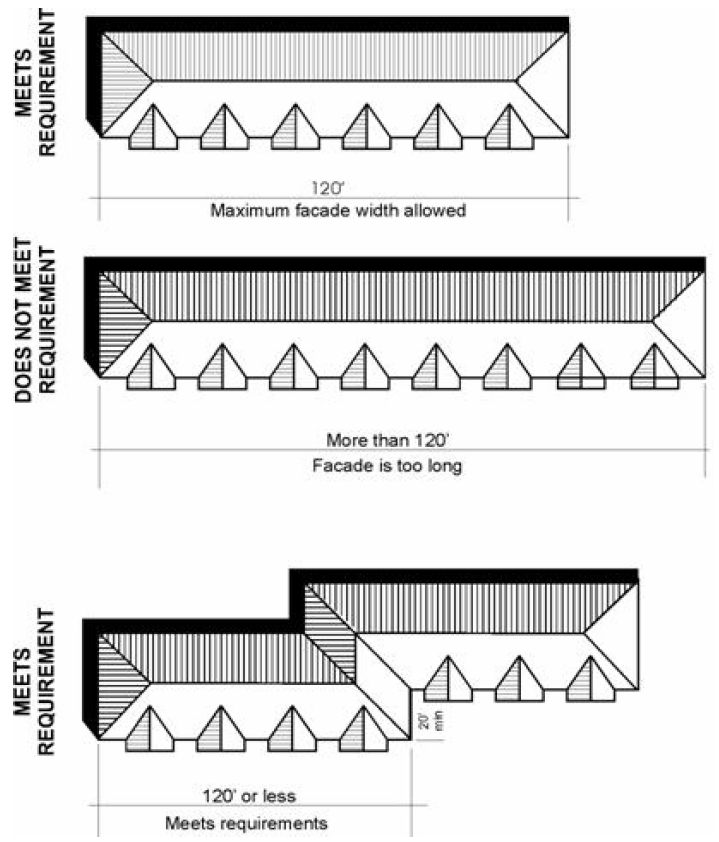
Figure 19.53.230-7
Maximum facade width standards
a. The maximum facade width (the facade includes the apparent width of the structure facing the street and includes required modulation) of multi-story buildings visible from a street, public open space, or pedestrian-oriented space is 120 feet.
b. Buildings exceeding 120 feet in width along the street front shall be divided by a 30-foot-wide modulation of the exterior wall, so that the maximum length of a particular facade is 120 feet. Such modulation must be at least 20 feet or deeper and extend through all floors (the first floor will be exempted if it includes a pedestrian-oriented facade).
c. Decks and roof overhangs may encroach up to three feet (per side) into the modulation.
MF9.1.3. Fronts of buildings should be articulated through the use of bays, insets, balconies, porches, or stoops related to entrances and windows.
MF9.1.4. When there are common entries, they shall be clearly identifiable and visible from the street, with well-defined walkways from pedestrian routes to building entries (see Figure 19.53.230-8).
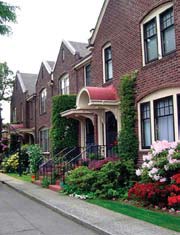
Figure 19.53.230-8
Visible building entry
MF9.1.5. Four or more of the following elements shall be used to highlight the main entrance to multifamily buildings:
a. Open space, plaza, or courtyard.
b. Special paving. The use of LID materials, if appropriate to the site conditions, is encouraged.
c. Ornamental gate and/or fence.
d. Seating.
e. Water features.
f. Planter boxes or pots.
g. Functional, accent lighting (see Figure 19.53.230-9). 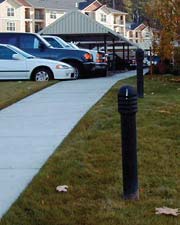
Figure 19.53.230-9
Pathway lighting
h. Art work near the entry.
i. Porches.
MF9.1.6. Front yards shall include an entrance sequence between the sidewalk and the building including elements such as trellises, site furnishings, low hedges, landscaped borders, and special paving (see Figure 19.53.230-10).
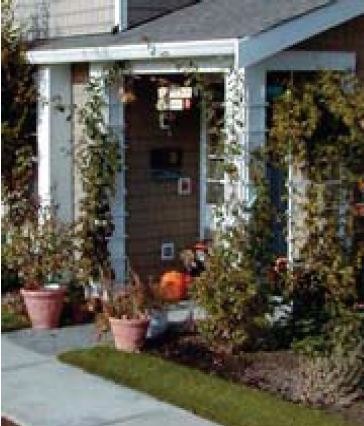
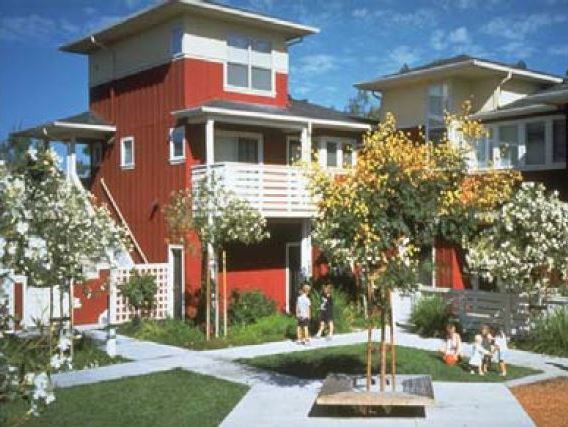
Figure 19.53.230-10
Front yard landscaping
MF9.1.7. Facades facing streets shall not be dominated by garage doors and driveways, or present blank walls lacking articulation, modulation, or window and door openings (see Figures 19.53.230-11 and 19.53.230-12). 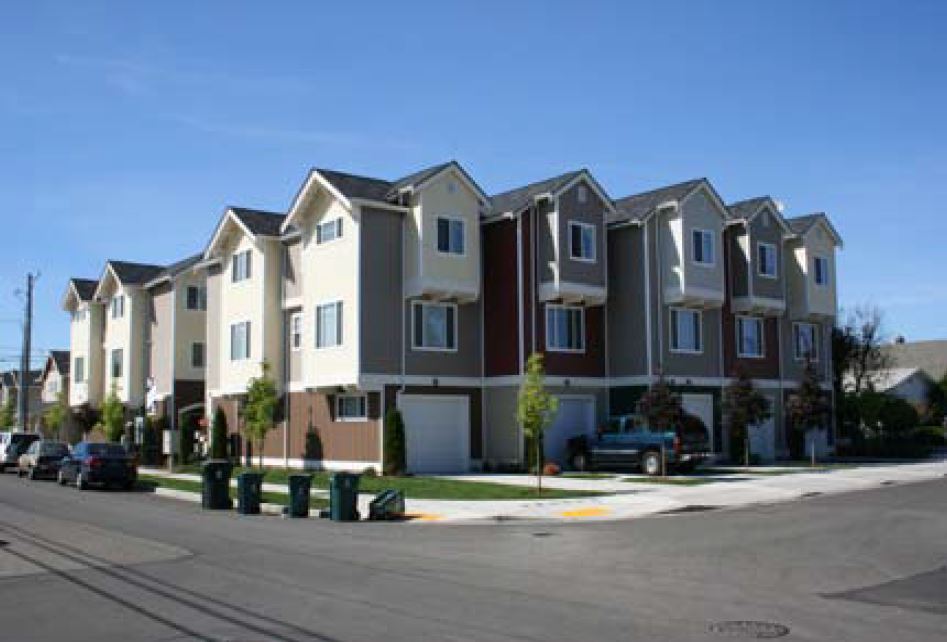
Figure 19.53.230-11
Undesirable: Parking is the dominant feature. Building frontage has a continuous driveway apron with no curbside parking.
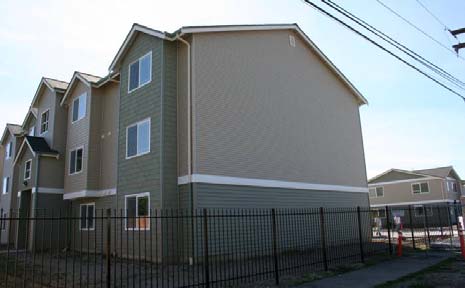
Figure 19.53.230-12
Undesirable: Building presents a blank wall lacking articulation, modulation, or window and door openings, to the street.
MF9.2. Design Guidelines.
MF9.2.1. Architectural treatments on the front elevation and elevations facing public rights-of-way and open space areas should provide visual interest through the following methods:
a. Wrap facade materials a minimum distance of four feet along the side yard elevations;
b. Provide additional detail along the base of multi-story, multifamily buildings;
c. Provide architectural features to articulated facades such as: trim with substantial depth and detail, window boxes, brackets, overhangs, trellises and/or lattice.
MF9.2.2. Ensure that openings in the facade contribute to the overall design of the building and promote a relationship to the human scale through the following methods (see Figure 19.53.230-13):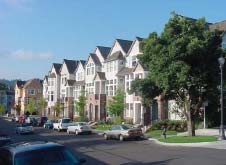
Figure 19.53.230-13
The facade of the buildings is rich in detailing, with brick along the first floor of the building and trim around all the windows. The walls are articulated often to break up the building horizontally.
a. Use window molding, shaped frames and sills and other techniques to enhance openings with additional architectural relief;
b. Frame all windows with a minimum of four-inch trim and inset into facade to provide depth and shadow lines.
D. MF10: Windows and Doors, Porches and Balconies.
Design Objective: To ensure that openings and private open space areas contribute to the overall design of the building; promote a relationship to the human scale and provide transitional spaces between private and public areas.
MF10.1. Approval Standards.
MF10.1.1. All multifamily building elevations shall contain windows, except when necessary to assure privacy for adjacent property owners (see UPMC 19.53.220, approval standard MF1.1.3).
MF10.1.2. All windows within a building and across a facade shall be related in design, operating type, proportions and trim.
MF10.1.3. Windows shall be used as architectural elements that add relief to the facade and wall surface.
MF10.1.4. Windows shall employ design details, if appropriate to the architecture, such as mullions, to break the scale of the facade into smaller components.
MF10.1.5. Reflective glazing is prohibited.
MF10.2. Design Guidelines.
MF10.2.1. Windows should be located to maximize the possibility of occupant surveillance of entryways, recreation areas, and laundry areas.
MF10.2.2. Windows should be vertically oriented, in order to relate to the human form, unless horizontal windows are appropriate to the style, or are necessary in the particular application.
MF10.2.3. For attached units, doors should vary from unit to unit, where possible, to further distinguish the individual identity of each residence.
MF10.2.4. Unifying architectural elements should be used to carry a window pattern across a facade, such as a common sill or header line.
MF10.2.5. Unless appropriate to an architectural style, windows should not be flush with walls. Glass should be inset from the exterior wall and/or frame surface to add relief to the wall surface.
MF10.2.6. Clear glass is recommended. To add privacy and aesthetic variety to glass, fritted glass, spandrel glass and other decorative treatments are recommended. If tinted glass is to be used, light tints and green, gray or blue hues are recommended.
MF10.2.7. Low emissivity glass and external shade devices should be used for heat control and an increase in energy efficiency.
MF10.2.8. Upper-story units should have balconies or decks sufficient to accommodate two chairs and a small table. To provide a greater usable open space, ground floor units should have a minimum 120 square feet of enclosed open space in the form of a patio or deck (see Figure 19.53.230-14).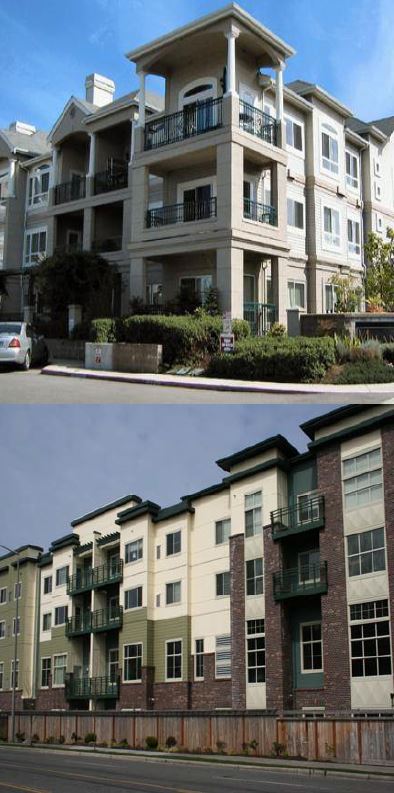
Figure 19.53.230-14
These balconies are large enough to accommodate two chairs and a table.
E. MF11: Materials and Colors.
Design Objective: To ensure that an appropriate range of building materials is used that enhances the quality of residential development.
MF11.1. Approval Standards.
MF11.1.1. Consistent pattern and application of exterior materials shall be used on new buildings and additions in order to enhance the appearance and character in the existing neighborhood.
MF11.1.2. The combination of materials on a building facade shall be appropriate to its style and design.
MF11.2. Design Guidelines.
MF11.2.1. Materials and colors should enhance the character and quality of residential development and be compatible with the surrounding neighborhood setting.
MF11.2.2. High quality materials and detailing should be used on all sides of the building, not just on the front facade.
MF11.2.3. A variety of materials should be used to emphasize a differentiation between the various components of the building. The combination of materials on a building facade shall be appropriate to its style and design and be visually appealing to the pedestrian (see Figure 19.53.230-15).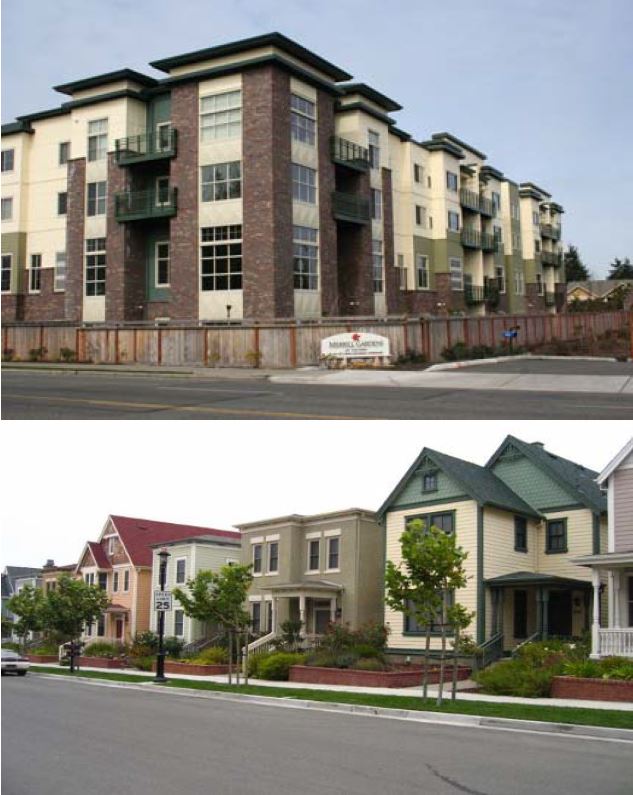
Figure 19.53.230-15
All exterior building colors and materials should be subtle and compatible with the surrounding neighborhood. These homes are visually appealing to a pedestrian because of the colors and materials used in these developments.
MF11.2.4. Exterior building colors should be compatible with the surrounding neighborhood setting and should be in keeping with the geographic and climatic conditions specific to University Place.
MF11.2.5. Accent colors should be used to enhance details such as trim.
MF11.2.6. Primary colors should be limited to accent or trim colors and should generally be compatible with the surrounding neighborhood.
F. MF12: Roofs.
Design Objective: To ensure that the design of roofs correlates to the building design.
MF12.1. Approval Standards.
MF12.1.1. Roof materials shall relate to the design and architectural style of the building.
MF12.1.2. Pitched roofs on multifamily buildings shall have a minimum slope ratio of 6:12.
MF12.1.3. On buildings where sloping roofs are the predominant roof type, each building shall have a variety of roof forms. For instance, a gable or hip configuration should be used with complementary sheds, dormers, and other minor elements. Other roof forms will be considered on a case-by-case basis.
MF12.1.4. Roof forms shall be designed to correspond and denote building elements and functions such as entrances and arcades.
MF12.2. Design Guidelines.
MF12.2.1. Roofing materials that are light-colored (such as white gravel), or brightly colored or reflective, should not be used.
(Ord. 559 § 6 (Exh. A § 3(MF7 – MF12))).
19.53.240 Lighting.
MF13: Lighting.
Design Objective: To ensure that the design of fixtures and the light provided contributes to the character of development, does not impact adjacent development or contribute to light pollution, and encourages energy efficiency.
MF13.1. Approval Standards.
1. Lighting Design.
MF13.1.1. Exterior lighting shall be designed as an integral part of the building and landscape design.
MF13.1.2. Site plans and architectural plans shall include the location of fixtures, their design and the nature and level of the illumination they will provide.
MF13.1.3. Illumination levels shall be provided to address security concerns, especially for parking lots, pedestrian paths, outdoor gathering spaces, at building entries and any other pedestrian accessible areas.
2. Lighting Height.
MF13.1.4. The height of luminaries shall be in scale with the building and site design and in no case shall the height exceed 16 feet in height from grade.
3. Area of Illumination.
MF13.1.5. The light source for externally illuminated signs must be positioned so that light does not shine directly on adjoining properties, cause glare, or shine in the eyes of motorists or pedestrians.
4. Prohibited Lights.
MF13.1.6. No outdoor lights shall be permitted that blink, revolve, flash or change intensity.
MF13.12 Design Guidelines.
1. Lighting Design.
MF13.2.1. Pedestrian-scaled decorative light fixtures, such as gooseneck lighting, are strongly encouraged (see Figure 19.53.240-1).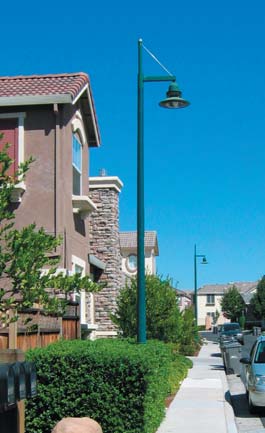
Figure 19.53.240-1
Encouraged: Pedestrian-scaled decorative light fixtures add to the intimacy and character of a neighborhood.
MF13.2.2. Lighting should generally be designed to include cut-offs to minimize the lighting of the sky.
MF13.2.3. In order to conserve energy and reduce long-term costs, energy-efficient, Energy Star-certified lamps should be used for all lighting, and hours of operation should be monitored and limited to avoid waste.
2. Lighting Height.
MF13.2.4. Lighting sources should be kept as low to the ground as possible while ensuring safe and functional levels of illumination.
MF13.2.5. Area lighting should be directed downward or employ control features to avoid light being directed offsite as well as to avoid lighting of the night sky.
3. Area of Illumination.
MF13.2.5. Lighting should be located to minimize the impact of lighting upon adjacent buildings and properties, especially residential uses. In general, the location of lighting should respond to the anticipated use and not exceed the amount of illumination required by users.
MF13.2.6. Illumination over an entire area or the use of overly bright lighting is strongly discouraged. The use of a number of smaller lights is preferable to larger, more intense lights.
MF13.2.7. Lighting for pedestrian movement should illuminate changes in grade, path intersections and other areas along paths which, if left unlit, would cause the user to feel insecure. Recommended minimum levels of illumination along pedestrian paths between destinations is 0.5 foot-candles. At pedestrian destination points such as entryways, plazas and courtyards, lighting levels should typically achieve illumination of one foot-candle.
MF13.2.8. The placement of light standards, whether for street lights or garden lights, should not interfere with pedestrian movement.
4. Parking Area Illumination.
MF13.2.9. Illumination should be concentrated along the pedestrian paths leading to parking areas and in the specific areas where cars are parked.
MF13.2.10. Illumination should achieve a lighting level of one foot-candle on the parking lot surface.
5. Lighting Efficiency.
MF13.2.11. In order to conserve energy and reduce long-term costs, energy-efficient, Energy Star-certified lamps should be used for all lighting, and hours of operation should be monitored and limited to avoid waste. Low voltage lighting, and lighting activated through the use of photocells, motion sensors and automatic timers, should be used where feasible.
(Ord. 559 § 6 (Exh. A § 3(MF13))).
Article V. Landscape Design Standards and Guidelines
19.53.250 Purpose.
Landscaping standards and guidelines are intended to provide visual enhancement of the City; to protect and promote the appearance, character and economic value of property; to reduce visibility of paved areas and other unsightly views from adjacent properties and public lands; to moderate climatic effects; to minimize noise and glare; to enhance public safety by defining spaces to influence traffic movement; to reduce stormwater runoff; and to provide visual transition between neighboring properties. Landscaping is an important aspect of the creation of space and scale and enables builders to create a transition between homes and the street while mitigating the impact of denser housing.
A. L1: General Landscape Design.
Design Objective: To ensure development plans include landscape elements that contribute positively to the character of small lot and multifamily neighborhoods.
L1.1. Approval Standards.
L1.1.1. Landscaping shall be an integral part of the overall site design, rather than camouflage unused or unusable spaces or poor architectural design.
L1.1.2. Larger, more mature plant materials shall be used as much as possible to ensure that some immediate effect on the project’s appearance will be attained within two years of planting.
L1.1.3. All landscaped public or common areas and front yard landscaping within a development shall be required to have automatic irrigation systems or xeriscape concepts to ensure plant survival.
L1.2. Design Guidelines.
L1.2.1. Landscape improvements should be utilized to better integrate a development with its setting by:
a. Enhancing pedestrian scale of buildings;
b. Screening views of unsightly elements, such as utility boxes and backflow devices;
c. Softening hard edges visually;
d. Providing a transition between different use areas;
e. Creating an attractive aesthetic environment;
f. Creating usable pedestrian areas;
g. Reducing energy consumption; and
h. Defining specific areas and enhancing architectural features (see Figure 19.53.250-1).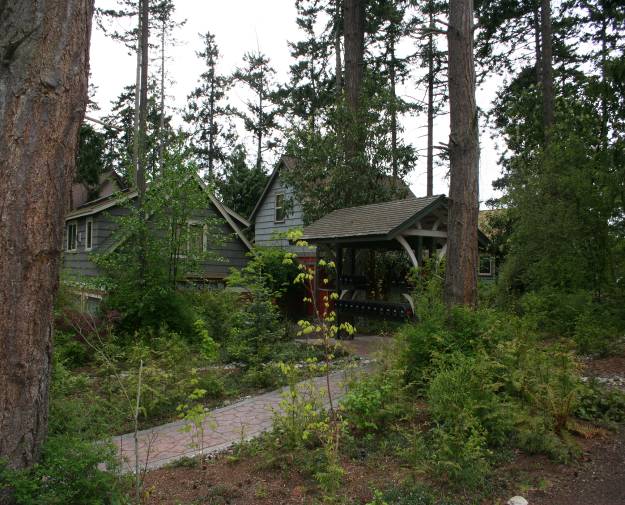
Figure 19.53.250-1
Landscaping integrates site design with existing trees to provide screening and shade.
L1.2.2. Where feasible, significant existing trees and other landscape elements should be preserved and incorporated into development and landscape plans. Landscape plans should exhibit a well-coordinated design concept. Plant materials should be utilized in an orderly manner which defines the site’s spatial organization and function, relates to the buildings and structures and incorporates the various site elements including existing vegetation.
L1.2.3. Landscape areas shall utilize xeriscape concepts which: minimize the amount of turf area, use plant material that has a low water demand and use a segmented irrigation system calibrated to the specific water demands of various turf, plant and tree groups.
L1.2.4. Swales are strongly recommended to reduce water quality impacts associated with site runoff (see Figure 19.53.250-2).
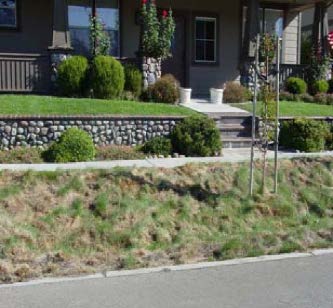
Figure 19.53.250-2
Low wall accompanied by landscaping and swale between street and sidewalk.
L1.2.5. Xeriscape Guidelines.
a. All landscaping should employ features and techniques that in the aggregate reduce the demand for and consumption of water, including appropriate low-water-using plants, nonliving groundcover, a low percentage of lawn coverage, a high degree of paving permeability and water conserving irrigation techniques and systems.
b. The use of turf should be minimized or substituted altogether with groundcovers. Turf should be excluded from median or sidewalk strips, steep slopes, and other areas which are difficult to irrigate and maintain. Low-water-using grass varieties are encouraged.
c. Water efficient irrigation systems, such as drip, low output sprinkler heads, zonal systems and automatic timers, should be provided. Planting should be according to water needs, and the irrigation system matched to these needs.
d. Plant varieties should be low water consuming, suited to the local soil and climate and grouped according to their water requirements. For instance, sprinklers for turf areas should be installed with a separate irrigation valve from irrigation valves used for other vegetation.
e. Mulches should be used generously and reapplied as part of a regular maintenance program to add nutrients and reduce evaporation, soil compaction and weeds. Mulches comprised of fully composted organic matter should be used in lieu of bark mulches, which do not provide much nutrient value to planting beds.
L1.2.6. The following are common planting design concepts that should be used whenever possible:
a. Specimen trees used in informal grouping and rows at major focal points;
b. A wide variety of plant species;
c. Extensive use of flowering vines both on walls and arbors;
d. Pots, vases, wall or raised planters;
e. The use of plantings to create shadow and patterns against walls;
f. Trees to create canopy and shade, especially in parking areas;
g. The use of flowering trees in informal groups to provide color;
h. Informal massing of colorful plantings;
i. The use of distinctive plants as focal points; and
j. Berms, plantings, and low walls to screen parking areas from view of public rights-of-way while allowing filtered views of larger buildings beyond.
L1.2.7. In general and where feasible, plant preservation should take precedence over transplanting, transplanting over planting new, and planting native over ornamental species.
L1.2.8. The use of plant species native to the coastal region of the Pacific Northwest is strongly encouraged to reduce water consumption and lower maintenance costs. Noninvasive naturalized species that have adapted to the climatic conditions of the region may be used to supplement native plants.
L1.2.9. Existing topsoil should be used where feasible. The clearing and site preparation of larger development areas should save and stockpile existing topsoil for plant adaptation.
L1.2.10. Planting areas between walls or fences and streets should be landscaped with a hierarchy of plant sizes (taller near the wall or fence to shorter near the street) in natural formations and groupings.
B. L2: Yard Landscape Design.
Design Objective: To ensure development plans include yard landscape elements that contribute positively to the character of residential neighborhoods.
L2.1. Approval Standards.
L2.1.1. Front yard landscaping shall reinforce other design elements of the home through the use of vines on trellises, hedges, or low fences or walls (see Figure 19.53.250-3).
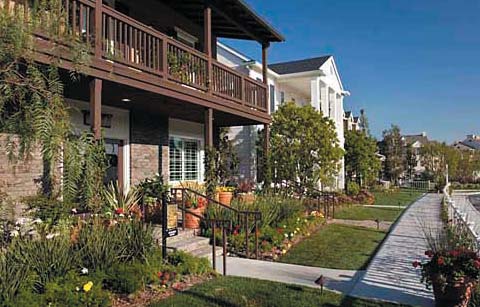
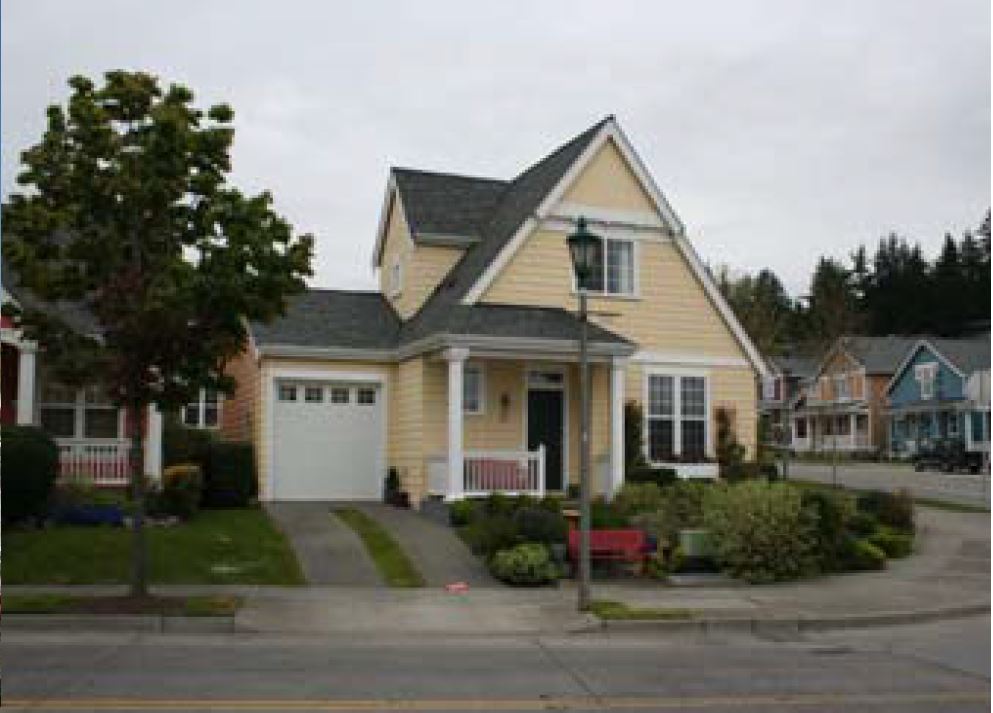
Figure 19.53.250-3
Front yard landscaping should contribute to neighborhood character
L2.1.2. Fences and hedges shall not be placed near neighborhood streets, access lanes, or alleyways in such a way to create a safety or entering sight distance concern and should complement building and site design (see Figure 19.53.250-4).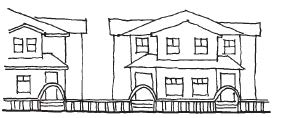
Figure 19.53.250-4
Fence design complementing building and site design
L2.1.3. Front Yard Decorative Fences. Front yard fences shall be decorative and help to define semi-private areas in the front of the building or between the building and a common open space area (see Figure 19.53.250-5).
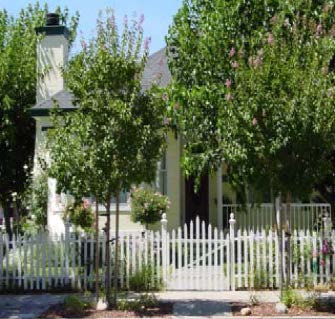
Figure 19.53.250-5
Front yard ornamental fence with landscape
a. The maximum height shall be three feet except that decorative posts and gates may have a maximum height of four feet.
b. Front yard decorative fences shall be located a minimum of one foot from sidewalks and walkways to allow for planting between edge of sidewalk and fence.
c. Front yard decorative fences shall provide a balance of solid surfaces and voids, such as picket or open rail fence styles.
d. Front yard decorative fences shall be constructed of wood, simulated wood, iron, masonry, or steel picket or comparable. Solid privacy fences, vinyl fences and chain link are prohibited.
L2.1.4. Hedges.
a. The maximum height of a hedge in a front yard, corner side yard, or area between the building and a common open space area shall be three feet.
b. The maximum height of hedges in interior and rear yards of multifamily developments shall be six feet, except when located abutting a common open space area the maximum shall be three feet.
c. The maximum height of hedges in rear yards of small lot developments shall be six feet, except when located abutting a common open space area the maximum shall be three feet. Hedges are not allowed in interior side yards in small lot developments.
L2.1.5. Privacy Fencing. Privacy fencing shall only be permitted in rear yards and shall be in character with the building’s architecture.
a. The maximum height of privacy fencing shall be six feet; provided, that portions above four feet shall be visually permeable through the use of open rails, ironwork, trellis or other treatment to encourage interaction between neighbors.
b. Privacy fencing adjacent to a public space shall be set back a minimum of one foot from the property line.
c. Planting shall be required along fences that face a street or public space (see Figure 19.53.250-6).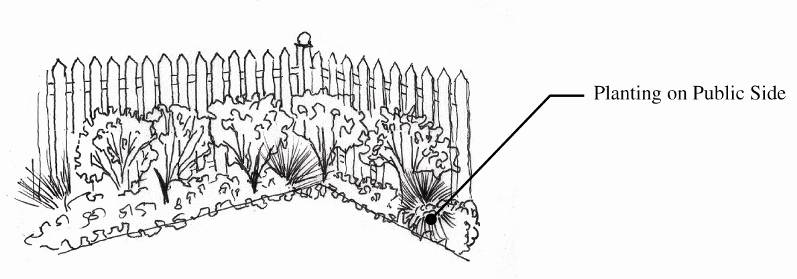
Figure 19.53.250-6
Public side of fence
d. If privacy fencing is located along an alleyway, a gate must be provided for access to the alleyway.
e. Privacy fencing shall be constructed of wood, simulated wood, iron, masonry, or steel picket or comparable. Vinyl or chain link fencing shall not be permitted.
L2.1.6. Walls, hedges, and fences used to define outdoor private spaces that are not located within a required yard shall be a maximum of six feet. Portions above four feet in height shall be visually permeable through the use of open rails, ironwork, trellis or other treatment to encourage interaction between neighbors.
L2.1.7. At least one tree having a minimum caliper size of two inches or height of eight feet shall be planted in the front yard of each small lot development home that has a front yard setback of 15 feet or greater unless this would conflict with an approved street tree planting plan. Where such conflict exists, the tree may be placed within a rear yard or other suitable location on the lot.
L2.1.8. Shrubs.
a. A continuous row of shrubs shall be planted adjacent to that portion of a foundation facing a public space. Spacing shall reflect the varying growth habits of the selected species and ensure effective screening of the foundation. The use of a mix of species and varieties within a foundation planting area is encouraged.
b. Shrubs shall have an average size of two-gallon for native plants and three-gallon for non-native.
L2.1.9. Entry walks shall have a minimum width of three feet.
L2.2. Design Guidelines.
L2.2.1. Hardscape areas should use permeable materials.
L2.2.2. Entry areas facing the public street shall be adequately landscaped to soften hard edges and screen views (see Figure 19.53.250-7). 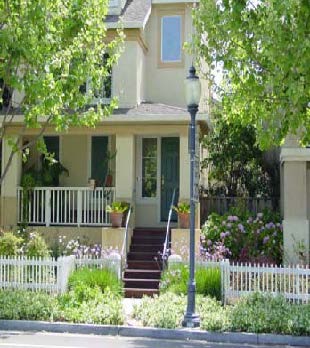
Figure 19.53.250-7
Entry areas with adequate landscaping
L2.2.3. All required building setbacks should be incorporated into the landscape design, unless such areas are utilized in driveways and the like. Driveways that provide a landscaped strip between paved driving strips are encouraged.
L2.2.4. Landscape design should accent the overall design theme through the use of structures such as arbors and trellises that are appropriate to the particular architectural style of adjacent structures.
C. L3: Parking Area Landscaping.
Design Objective: To provide parking areas that do not detract from the residential environment.
The standards and guidelines in this section apply specifically to multifamily development and, where applicable, shared parking areas in small lot developments.
L3.1. Approval Standards.
L3.1.1. All parking areas shall provide interior landscaping for shade purposes and aesthetic enhancement.
L3.1.2. Curbed planter areas shall be provided at the end of each parking aisle to protect parked vehicles from the turning movements of other vehicles.
L3.1.3. Parking lots shall be landscaped with broad branching shade trees at a minimum ratio of three trees per 10 parking spaces for single-loaded stalls, six trees per 20 parking spaces for double-loaded stalls and one tree for every three parking spaces for smaller parking bays.
L3.2. Design Guidelines.
L3.2.1. Views of parking areas from public streets should be buffered by landscaping, earth berms or some combination of the two in order to reduce the visual impact of large parking areas.
L3.2.2. For security reasons, openings should be incorporated into the landscaping in order to permit clear views into the site.
L3.2.3. No more than 10 parking spaces should be located in a row without an intervening landscaped planter island or peninsula. The intervening planter should be the full depth of the adjacent parking spaces.
L3.2.4. Wheel stops should be used adjacent to tree wells and planter areas to protect landscaping from car overhangs. In place of wheel stops, the planter curb may be used for car overhangs if impacts to landscaping are minimized through appropriate plant selection and location.
L3.2.5. Drainage into swale areas is encouraged and may be accommodated by design elements such as flush curbs, perforated curbs and tree offsets.
L3.2.6. Plant material in and adjacent to swales should delineate the transition between the swale area and the surrounding landscape.
D. L4: Landscaping and Planting Requirements.
1. Design Objective: To enhance the visual appearance of the neighborhood, to promote utilization of natural systems, and to reduce the impacts on storm drainage systems and water resources.
2. Standards and Guidelines.
L4.1. Planting Calculation and Installation.
i. If the calculation of the number of plantings results in a fraction of 0.5 or greater, the fraction shall round up to the next whole number. If the calculation of the number of plantings results in a fraction of less than 0.5, the fraction shall round down to the previous whole number. Existing trees may be used to meet the tree requirements in the planting calculations.
ii. Place all shrubs and perennial plants in beds mulched with fully composted organic material. The compost must cover the entire planting bed to a depth of at least two inches.
iii. Install a mulch ring at the base of each canopy and ornamental tree. At time of planting, the ring must have at least a three-foot radius, measured from the center of the tree trunk. This mulch ring must be of organic material and be a depth of at least two inches.
L4.2. Parks.
i. One two-inch caliper or eight-foot tall canopy or ornamental tree shall be planted for every 2,000 square feet of park area.
ii. Shade trees shall be provided adjacent to play structures and at other elements in the park, such as sport courts and benches.
iii. A pathway, with a minimum width of three feet, shall connect a park to neighborhood streets, access lanes or other pedestrian connections.
L4.3. Common Greens and Pocket Parks.
i. One two-inch caliper or eight-foot tall canopy or ornamental tree shall be planted for every 1,000 square feet of common green or pocket park area.
ii. The common greens and pocket parks shall be planted with plants that reflect the character and the intended use of the greens.
iii. Sidewalks or pathways are encouraged to be located near the edge of the common green or pocket park to allow a larger usable green area and easy access to the homes.
iv. A pathway, with a minimum width of three feet, shall connect a common green or pocket park to neighborhood streets, access lanes or other pedestrian routes.
v. The minimum lawn coverage of a common green or pocket park should be 70 percent to create a useable play area or gathering space.
L4.4. Pedestrian Easements.
i. Trees are required along all pedestrian easements to provide shade.
(A) Trees shall have a minimum caliper of two inches at time of planting unless the City determines that a particular species or cultivar, which is available only in a smaller size, is the preferred selection for a specific location.
(B) Trees shall be spaced 20 to 30 feet on center, depending on the form and spacing requirements for the selected trees.
(C) Trees shall be placed so as not to block sight distance or create a safety concern.
(D) Generally, tree species shall be selected from the City’s Approved Street Tree Palette (UPMC 13.20.1060), which is contained in the City’s Streetscape Design Standards and Guidelines adopted pursuant to this chapter. The City may approve trees not on the Approved Street Tree Palette (UPMC 13.20.1060) provided a registered landscape architect or certified arborist demonstrates to the satisfaction of the City that the proposed tree species will not cause damage to infrastructure or create nuisance conditions.
ii. Shrubs shall be planted within a minimum 15 percent of easement space.
(A) Shrubs shall be spaced to reflect the varying growth habits of the selected species.
(B) Shrubs shall have an average size of two-gallon for native plants and three-gallon for non-native.
iii. Groundcover or perennials must fully cover the remaining landscape area. Plantings shall be designed to achieve a minimum planting area coverage of 90 percent of required coverage within three years of installation.
(Ord. 559 § 6 (Exh. A § 4(L1 – L4))).
Article VI. Appendices
19.53.260 Checklist for small lot projects.
|
Project Name: _____________________________ |
|
Date of Review: ____________________________ |
|
CITY OF UNIVERSITY PLACE DESIGN CRITERIA AND STANDARDS |
Proposed Project |
||
|---|---|---|---|
|
CHECKLIST FOR SMALL LOT DEVELOPMENT RESIDENTIAL PROJECTS |
Y |
N |
Comments |
|
Design Element 1: Site Planning and Design |
|||
|
SL1: Building Siting and Orientation |
|||
|
Site design elements display a clear and unified organization of building, landscaping and circulation elements that support the functions of the site. |
|
|
|
|
The placement of buildings considers the existing context of the surrounding area. |
|
|
|
|
Attached units are separated from other attached units on the same block face by one or more detached units. |
|
|
|
|
(Refer to Design Guidelines SL1.2.1 – SL1.2.9 for design guidelines that help meet the “Site Planning and Design” criterion) |
|
|
|
|
SL2: Grading and Stormwater Management |
|||
|
Structures, roadways and other site improvements (drainage ways and storage areas) are designed to blend with the natural topography, with a minimum of site disturbance and grade changes. |
|
|
|
|
Low impact development (LID) techniques are used to the extent practicable, as determined by a development site’s soil characteristics, to maximize stormwater infiltration within the site and minimize the amount of stormwater that is transferred off site. |
|
|
|
|
Stormwater ponds are designed as a landscape amenity and planted with grass or native plants. |
|
|
|
|
Stormwater ponds are not fenced, and do not exceed a 4 horizontal to 1 vertical slope. |
|
|
|
|
Stormwater ponds are designed in accordance with the King County Integrated Pond Manual. |
|
|
|
|
A maximum of 50 percent of the front yard between the facade of the home and front property line is paved or covered with impervious surface. |
|
|
|
|
Filling and grading is in accordance with Chapter 13.25 UPMC and the King County Surface Water Design Manual (KCSWDM). |
|
|
|
|
(Refer to Design Guidelines SL2.2.1 – SL2.2.5 for design guidelines that help meet the “Grading and Stormwater Management” criterion) |
|
|
|
|
SL3: Lot Standards |
|||
|
The building placement is configured to support the neighborhood’s existing site patterns, including building location, setbacks and yard areas. |
|
|
|
|
Minimum lot width for homes with front-loaded and side-loaded garages is 40 feet. No minimum is specified for alley-loaded and other garage designs. |
|
|
|
|
The building setbacks ensure separation of homes and private spaces while allowing moderate density. Small-lot homes complement existing setback patterns in terms of distance to the street and spacing between homes while considering smaller lot sizes and the need for private open space. |
|
|
|
|
If necessary, reciprocal side and/or rear yard use easements are delineated on the site plan. |
|
|
|
|
If necessary, where a side yard easement is used, the wall facing the side yard is constructed as a “privacy wall.” In this case privacy walls do not have doors entering into the yard space of the adjacent home, nor have windows that are within 5 feet of ground level. |
|
|
|
|
(Refer to Design Guidelines SL3.2.1 – SL3.2.3 for design guidelines that help meet the “Lot Standards” criterion) |
|
|
|
|
SL4: Front Yards / Entrances |
|||
|
Primary building entries are clearly identifiable and visible from the street, with well-defined walkways from pedestrian routes to building entries. |
|
|
|
|
Signage identifying a building’s address is visible from the street and public pedestrian walkway. |
|
|
|
|
(Refer to Design Guidelines SL4.2.1 – SL4.2.2 for design guidelines that help meet the “Front Yards/Entrances” criterion) |
|
|
|
|
SL5: Parking and Garage Placement and Design |
|||
|
The driveway and the garage are secondary to the livable portions of the house, landscaping and pedestrian entry as seen from the street. |
|
|
|
|
Garages are located in an area to minimize the presence of the automobile. |
|
|
|
|
On-site garages are set back a minimum of 10 feet from the front building facade with a minimum 20-foot driveway length from the face of the garage to the back of the sidewalk or access lane. Garages accessed by an alleyway are not required to provide a 20-foot driveway. |
|
|
|
|
Shared detached garages are located no further than 160 feet from any of the housing units to which they are assigned. Shared detached garages do not exceed 44 feet in width and maintain at least an 8-foot separation from any dwellings. |
|
|
|
|
Private detached garages maintain a minimum 5-foot separation from any dwellings. |
|
|
|
|
A tandem driveway space is allowed on a lot and extends a minimum of 20 feet from back of sidewalk or 20 feet from back of access lane. |
|
|
|
|
The width of the driveway (excluding curb returns) does not exceed 10 feet for single lane and 16 feet for double lane driveways. |
|
|
|
|
Two resident parking stalls are provided for each detached small lot unit and 1.5 resident parking stalls are provided for each attached small lot unit. |
|
|
|
|
A minimum of one guest stall per small lot unit is provided and is located on the lot, on a neighborhood street or in a parking court. |
|
|
|
|
Parallel parking on neighborhood streets is a minimum 22 feet long. |
|
|
|
|
Guest parking is not located more than 160 feet from the home it is intended to serve. |
|
|
|
|
For homes with front-loaded garages, no more than 40 percent of a home’s facade facing the street is devoted to a garage. |
|
|
|
|
For attached units, no more than two single-car garage doors are visible on any street-facing facade and no more than one driveway is located on each street frontage of a lot. |
|
|
|
|
(Refer to Design Guidelines SL5.2.1 – SL5.2.7 for design guidelines that help meet the “Parking and Garage Placement and Design” criterion) |
|
|
|
|
SL6: Individual Outdoor Spaces |
|||
|
Outdoor spaces such as yards, decks, terraces, and patios are delineated from common space. |
|
|
|
|
Units have a minimum of 250 square feet of private yard with no dimension less than 8 feet in width. Developments of 3 or fewer dwelling units have a minimum of 750 square feet of private yard. |
|
|
|
|
Outdoor spaces are not located adjacent to dumpster enclosures, loading/service areas, or other incompatible uses. |
|
|
|
|
Outdoor spaces used to meet these design elements are not located within required landscape buffer areas. |
|
|
|
|
(Refer to Design Guidelines SL6.2.1 – SL6.2.3 for design guidelines that help meet the “Individual Outdoor Spaces” criterion) |
|
|
|
|
SL7: Common Open Spaces |
|||
|
Projects are sited to maximize opportunities for creating usable, well-integrated open space. |
|
|
|
|
A minimum of one 1/2 acre park or central open space area (pocket park) is reserved for developments exceeding 10 acres of net developable acreage. The remaining required common open space is provided through additional park area, common greens, or pedestrian entry easements. |
|
|
|
|
If a small lot development has less than 10 acres of buildable land, a park, common green, pocket park and/or pedestrian entry easement is used to meet the common open space requirements. |
|
|
|
|
Pocket parks are visible and open to the street or designed to serve clusters of approximately 6 to 12 homes. |
|
|
|
|
For small lot developments of 4 or more units, each unit provides at least 350 square feet of common space. For developments of 3 or less dwelling units, there is no common space requirement. |
|
|
|
|
Common open space is a minimum of 20 feet wide and serves a minimum of 4 homes. |
|
|
|
|
(Refer to Design Guidelines SL7.2.1 – SL7.2.6 for design guidelines that help meet the “Common Outdoor Spaces” criterion) |
|
|
|
|
SL8: Utility Areas and Accessory Structures |
|||
|
Above ground utility boxes are placed in alleyways or away from public gathering spaces to the extent practicable and are screened with landscaping, which may include fencing or berms. |
|
|
|
|
No more than one detached garage or other accessory structure is permitted per lot. This structure is architecturally consistent with the principal structure. |
|
|
|
|
Detached garages do not exceed 18 feet to top of roof in height or more than 600 square feet in area. |
|
|
|
|
Carriage houses do not exceed 21 feet in height or a building footprint of 600 square feet in area. |
|
|
|
|
Greenhouses, sheds, and other accessory structures (other than garages and carriage houses) do not exceed 12 feet to top of roof in height or 150 square feet in area. |
|
|
|
|
Accessory structures are no closer than 3 feet from the interior side or rear property line or 2 feet from an alleyway. |
|
|
|
|
Overhangs and roof drainage do not encroach over property lines. |
|
|
|
|
Accessory structures are not located in front yards. |
|
|
|
|
(Refer to Design Guidelines SL8.2.1 – SL8.2.6 for design guidelines that help meet the “Utility and Accessory Structures” criterion) |
|
|
|
|
Design Element 2: Building Design |
|||
|
SL9: Mass, Scale and Form |
|||
|
Primary building forms are the dominating form while secondary formal elements include porches, principal dormers, or other significant features. |
|
|
|
|
The scale, mass and height of a new house or second/upper story addition is compatible with the existing neighborhood pattern specifically in relation to height and massing of adjacent homes. |
|
|
|
|
Primary building elevations oriented toward the street or common green have at least one articulation or change in plane. A minimum of at least one side articulation occurs for side elevations facing streets or public spaces. |
|
|
|
|
Primary articulations are a minimum of 2 feet in depth and extend at least 20 percent of the length of the building facade. Side articulations are a minimum of one foot in depth and extend at least 20 percent of the length of the building facade. |
|
|
|
|
Each home has a covered porch or main entry oriented towards the public realm. |
|
|
|
|
Roof profiles define the form, scale and proportion of the home and building and reduce bulk. |
|
|
|
|
Maximum dwelling size is 1,500 square feet for attached unit and 2,000 square feet for detached unit, including attached garages and excluding detached garages and carriage house ADU floor area. |
|
|
|
|
Maximum FAR for individual lots does not exceed 0.45. Average FAR for all homes within a small lot development does not exceed 0.40. FAR is calculated using a site’s buildable area, including private street area and excluding critical areas and their required associated buffers. |
|
|
|
|
Maximum dwelling height is 30 feet (where minimum roof slope of 6:12 for all parts of the roof above 20 feet is provided). Otherwise, 20 feet. |
|
|
|
|
Maximum height is 18 feet for nonresidential structures. 21 feet for accessory structure containing a carriage house ADU. |
|
|
|
|
Maximum size for accessory structures is 600 square feet on ground floor. Additional area is allowed on second floor to accommodate a carriage house ADU. |
|
|
|
|
(Refer to Design Guidelines SL9.2.1 – SL9.2.5 for design guidelines that help meet the “Mass, Scale and Form” criterion) |
|
|
|
|
SL10: Architectural Style |
|||
|
The architectural style of the house or building enhances the character of the neighborhood. |
|
|
|
|
The architectural form of the house or building is designed to articulate the style of the house or building. |
|
|
|
|
(Refer to Design Guidelines SL10.2.1 – SL10.2.4 for design guidelines that help meet the “Architectural Style”' criterion) |
|
|
|
|
SL11: Facades and Entries |
|||
|
Facades are designed to include entries, porches and other architectural elements that relate to the human scale and provide a transition from public to private space. |
|
|
|
|
Stoops or porches are required on all homes. At least 75% of the homes within a development have porches. |
|
|
|
|
Stoops and porches are raised above the grade except where accessibility (ADA) is a priority. An accessible route may also be taken from a driveway. |
|
|
|
|
All porches and stoops take access from and face a street, park, common green, pocket park, pedestrian easement, or open space. |
|
|
|
|
Stoops are accompanied by a projecting overhead element such as a dormer, arch or gable that provides roof coverage and weather protection. Stoops are a minimum of 5 feet wide and 4 feet deep. The minimum height above grade is 12 inches. |
|
|
|
|
Porches have a minimum dimension of 8 feet and a minimum area of 64 square feet. On corner lots, porches are encouraged to wrap around the side facade at least 6 feet. |
|
|
|
|
Residential entries are located on the front facade and directly access the sidewalk or street. |
|
|
|
|
Any visible side of a home located on the corner of a neighborhood street, access lane, a park, green, or pocket park meets the architectural standards of this section. |
|
|
|
|
Windows are provided in facades facing streets, comprising at least 20% of the facade area. |
|
|
|
|
All windows within a building and across a facade are related in design, operating type, proportions and trim. |
|
|
|
|
Windows are used as architectural elements that add relief to the facade and wall surface. |
|
|
|
|
Front doors reflect the architectural style of the home. |
|
|
|
|
Windows shall employ design details, if appropriate to the architecture, such as mullions, to break the scale of the facade into smaller components. |
|
|
|
|
(Refer to Design Guidelines SL11.2.1 – SL11.2.3 for design guidelines that help meet the “Facades and Entries” criterion) |
|
|
|
|
SL12: Roofs |
|||
|
Primary roof pitches are a minimum of 6:12. |
|
|
|
|
Roof pitches for gable forms on the public sides of the building are a minimum of 8:12. |
|
|
|
|
Roof overhangs are a minimum of 12 inches, excluding gutter. |
|
|
|
|
Roof material is fire retardant. |
|
|
|
|
A variety of roof colors is used within the development. |
|
|
|
|
(Refer to Design Guidelines SL12.2.1 – SL12.2.2 for design guidelines that help meet the “Roofs” criterion) |
|
|
|
|
SL13: Materials and Colors |
|||
|
A consistent pattern and application of exterior materials is used on new homes and additions in order to enhance the appearance and character in the existing neighborhood. |
|
|
|
|
The combination of materials on a building facade is appropriate to its style and design. |
|
|
|
|
The appropriate transition in materials is used. |
|
|
|
|
(Refer to Design Guidelines SL13.2.1 – SL13.2.4 for design guidelines that help meet the “Materials and Colors” criterion) |
|
|
|
|
SL14: Other Design Elements |
|||
|
Chimneys above the roof are at least 20 inches x 24 inches as measured in the plan. |
|
|
|
|
Wood-framed chimney enclosures are permitted; however, metal termination caps are not left exposed. These tops are shroud in a metal chimney surround. |
|
|
|
|
Columns a. Character columns are round, fluted, or strongly related to the home’s architectural style. b. Exposed 4 x 4- and 6 x 6-inch posts are prohibited. |
|
|
|
|
Corners a. Beveled and mitered corners are preferred where siding is used. b. Metal corner clips or corner boards may also be used at corners where siding is used. Corner boards are a minimum of 2-1/2 inches in width. |
|
|
|
|
Gutters are painted or an integral color to closely match the body color or trim color. Gutters may also have a traditional metal appearance provided through the use of copper, aluminum, galvanized material or other metal. |
|
|
|
|
(Refer to Design Guidelines SL14.2.1 – SL14.2.5 for design guidelines that help meet the “Other Design Elements” criterion) |
|
|
|
|
SL15: Interior Sprinklers |
|||
|
Sprinklers are encouraged to be provided in all living spaces where not otherwise required by regulation. |
|
|
|
|
(Refer to Design Guideline SL15.1.1) |
|
|
|
|
Design Element 3: Lighting Standards |
|||
|
SL16: Lighting |
|||
|
Exterior lighting is designed as an integral part of the building and landscape design. All exterior lighting is prevented from projecting light upward either by placement beneath building eaves or by an integral shield of the fixture’s interiors as recommended by the manufacturer. |
|
|
|
|
Site plans and architectural plans include the location of fixtures, their design and the nature and level of the illumination they will provide. |
|
|
|
|
The lighting for neighborhood streets, access lanes, alleyways, common greens, and parks is low intensity and is from the same family of fixtures. |
|
|
|
|
Lighting facilities and fixtures are located outside public right-of-way unless owned, operated, and maintained by a power utility franchised by the City. |
|
|
|
|
Street lighting fixtures are a maximum height of 16 feet. |
|
|
|
|
Sidewalks and pathways not otherwise illuminated by street lighting shall be lit with ornamental lighting fixtures. All pedestrian lighting fixtures shall be a maximum height of 12 feet. |
|
|
|
|
If alley lights are mounted on the garage, they are no higher than 8 feet above ground and directed away from adjacent backyards and structures. |
|
|
|
|
Lighting is limited to illumination of surfaces intended for pedestrians, vehicles, or key architectural features. |
|
|
|
|
Street lights are placed on all internal roadways and perimeter roadways abutting the development per the design standards in UPMC 13.20.630. |
|
|
|
|
(Refer to Design Guidelines SL16.2.1 – 16.2.10 for design guidelines that help meet the “Lighting” criterion) |
|
|
|
(Ord. 559 § 6 (Exh. A § 5(B))).
19.53.270 Checklist for multifamily development residential projects.
|
Project Name: _____________________________ |
|
Date of Review: ____________________________ |
|
CITY OF UNIVERSITY PLACE DESIGN CRITERIA AND STANDARDS |
Proposed Project |
||
|---|---|---|---|
|
CHECKLIST FOR MULTIFAMILY LOT DEVELOPMENT RESIDENTIAL PROJECTS |
Y |
N |
Comments |
|
Design Element 1: Site Planning and Design |
|||
|
MF1: Building Siting and Orientation |
|||
|
Multifamily buildings are clustered or grouped to form neighborhoods. |
|
|
|
|
Multifamily buildings are organized around a common open space, public open space (e.g., a greenway), natural features located on the site (e.g., a stream corridor), or community amenities such as swimming pools or other recreational facilities. |
|
|
|
|
Individual buildings within a multifamily development are oriented to primary perimeter streets, including thoroughfares, or boundaries; or through-access drives. |
|
|
|
|
Pedestrian building entrances face the street and are clearly visible from the street. |
|
|
|
|
Buildings do not present blank walls lacking articulation, modulation, or window and door openings, to streets, access drives or parking areas. |
|
|
|
|
Buildings provide windows that face the street to provide “eyes on the street” concept for safe streets. |
|
|
|
|
Placement of buildings considers the existing context of the surrounding area. Multifamily developments respect privacy and solar access through appropriate siting of structures. |
|
|
|
|
(Refer to Design Guidelines MF1.2.1 – MF1.2.2 for design guidelines that help meet the “Building Siting and Orientation” criterion) |
|
|
|
|
MF2: Grading and Stormwater Management |
|||
|
Structures, roadways and other site improvements (drainage ways and storage areas) are designed to blend with the natural topography, with a minimum of site disturbance and grade changes. |
|
|
|
|
Low impact development (LID) techniques are used to the extent practicable, as determined by a development site’s soil characteristics, to maximize stormwater infiltration within the site and minimize the amount of stormwater that is transferred off site. |
|
|
|
|
Stormwater ponds are designed as a landscape amenity and planted with grass or native plants. |
|
|
|
|
Stormwater ponds are not fenced, and do not exceed a 4 horizontal to 1 vertical slope. |
|
|
|
|
Filling and grading is in accordance with Chapter 13.25 UPMC and the King County Surface Water Design Manual (KCSWDM) to control stormwater runoff impacts to adjacent properties. |
|
|
|
|
(Refer to Design Guidelines MF2.2.1 – MF2.2.5 for design guidelines that help meet the “Grading and Stormwater Management” criterion) |
|
|
|
|
MF3: Parking |
|||
|
Carports, parking areas and parking structures are internalized in building groupings or oriented away from street frontage. |
|
|
|
|
Parking areas and freestanding parking structures (detached garages or carports) do not occupy more than 30 percent of each public street frontage. Freestanding parking structures that are visible from public streets are sited to be perpendicular to the street to reduce visual impacts on the streetscape. |
|
|
|
|
Total number of required parking spaces is broken up into smaller “blocks” of parking, with no more than 10 parking spaces per parking block. |
|
|
|
|
Parking garages and driveways do not dominate the streetscape and substantially diminish or eliminate on-street parking. |
|
|
|
|
(Refer to Design Guidelines MF3.2.1 – MF3.2.3 for design guidelines that help meet the “Parking” criterion) |
|
|
|
|
MF4: Common Open Spaces |
|||
|
New development sets aside a percentage of the net site acreage as common open space for the use and enjoyment of the development’s residents. The minimum amount of open space (as a percentage of net land area) is 17%. |
|
|
|
|
Open space areas are clearly identified on the development plan. Common outdoor spaces shall provide at least 6 amenities from the design standards list to accommodate a variety of ages and activities. |
|
|
|
|
To the maximum extent practicable, common open space land is compact and contiguous unless the land is used as a continuation of an existing greenway, trail, or other linear park, or unless specific topographic features require a different configuration. |
|
|
|
|
Common open space is organized to create integrated systems of open space that connect with open space, parks, schools, etc. |
|
|
|
|
Common open space is accessible to all residents of the development. |
|
|
|
|
A variety of common open spaces is provided throughout the neighborhood in the form of parks, common greens, pocket parks, and pedestrian easements. |
|
|
|
|
Where common open space is bordered by private rear or side yards, opaque fences and walls are not erected in such yards bordering the open space. |
|
|
|
|
(Refer to Design Guidelines MF4.2.1 – MF4.2.2 for design guidelines that help meet the “Common Open Spaces” criterion) |
|
|
|
|
MF5: Accessory Structures |
|||
|
The design of the mailboxes and mailbox enclosures is consistent with the architectural style of the development and matches the colors and materials of other on-site buildings. |
|
|
|
|
Mailboxes are clustered and lockable consistent with U.S. Postal Service (USPS) standards. |
|
|
|
|
Trash enclosures are of sufficient size to house the number and size of trash bins and containers needed to accommodate the waste generated by the building user, including trash, cardboard, cans and bottles, food waste, green waste and other recyclables. |
|
|
|
|
Trash enclosures are integrated into the site plan to minimize enclosure visibility and accommodate truck access. |
|
|
|
|
Trash enclosures are constructed of durable materials and the color, texture, and architectural detailing is consistent with the overall site and building design. |
|
|
|
|
Backflow prevention devices are included in the plans for design review and are screened from public view by the use of landscaping, berms, low walls and other such screening devices. |
|
|
|
|
(Refer to Design Guidelines MF5.2.1 – MF5.2.7 for design guidelines that help meet the “Accessory Structures” criterion) |
|
|
|
|
MF6: Signage |
|||
|
Signage contributes to the development’s identity as a unique environment. Professionally designed, creative signage is strongly encouraged, especially for internal directions and building identification. |
|
|
|
|
Clear legible entry signage is provided to identify the development. Internal circulation signage and visitor parking areas are also clearly indicated. |
|
|
|
|
Building numbers and individual unit numbers are readily visible from the nearest street or access way, in a consistent location, well lit at night, and compatible with the overall design of the development. |
|
|
|
|
(Refer to Design Guidelines MF6.2.1 – MF6.2.3 for design guidelines that help meet the “Signage” criterion) |
|
|
|
|
Design Element 2: Building Design |
|||
|
MF7: Mass, Scale and Form |
|||
|
Multifamily building designs incorporate visually heavier and more massive elements at the building base, and lighter elements above the base. |
|
|
|
|
The massing of larger residential buildings is broken down to convey a sense of “home,” and give individuality to each unit that lies within it. |
|
|
|
|
Building massing is subdivided into portions or segments compatible with the adjacent residential scale. |
|
|
|
|
Facades of long buildings are architecturally subdivided into shorter segments every 25 to 50 feet. |
|
|
|
|
Each vertical module of units incorporate architectural features that help to individually distinguish them, such as wall breaks, projections, distinct color schemes and individual roof treatments. |
|
|
|
|
Roof profiles define the form, scale and proportion of the building and reduce bulk. |
|
|
|
|
(Refer to Design Guidelines MF7.2.1 – MF7.2.3 for design guidelines that help meet the “Mass, Scale and Form” criterion) |
|
|
|
|
MF8: Architectural Style |
|||
|
Architectural style of the building enhances the character of the neighborhood. |
|
|
|
|
The architectural form of the building is carefully designed to articulate the style of the building. |
|
|
|
|
(Refer to Design Guidelines MF8.2.1 – MF8.2.2 for design guidelines that help meet the “Architectural Styles” criterion) |
|
|
|
|
MF9: Facades and Entries |
|||
|
All building entries adjacent to a collector or residential (local) public street or to a public street or private drive with on-street parking are pedestrian-scaled. Pedestrian-scaled entries are those that provide an expression of human activity or use in relation to building size. Doors, windows, entranceways, and other features such as corners, setbacks, and offsets are used to create pedestrian scale. |
|
|
|
|
Buildings with long facades use design techniques to break up long continuous building walls, reduce the architectural scale of the building and add visual interest. |
|
|
|
|
Fronts of buildings are articulated through the use of bays, insets, balconies, porches, or stoops related to entrances and windows. |
|
|
|
|
When there are common entries, they are clearly identifiable and visible from the street, with well-defined walkways from pedestrian routes to building entries. |
|
|
|
|
Front yards include an entrance sequence between the sidewalk and the building including elements such as trellises, site furnishings, low hedges, landscaped borders, and special paving. |
|
|
|
|
Facades facing streets are not dominated by garage doors and driveways, or present blank walls lacking articulation, modulation, or window and door openings. |
|
|
|
|
(Refer to Design Guidelines MF9.2.1 – MF9.2.2 for design guidelines that help meet the “Facades and Entries” criterion) |
|
|
|
|
MF10: Windows and Doors, Porches and Balconies |
|||
|
All multifamily building elevations contain windows, except when necessary to assure privacy for adjacent property owners. |
|
|
|
|
All windows within a building and across a facade relate in design, operating type, proportions and trim. |
|
|
|
|
Windows are used as architectural elements that add relief to the facade and wall surface. |
|
|
|
|
Windows employ design details, if appropriate to the architecture, such as mullions, to break the scale of the facade into smaller components. |
|
|
|
|
(Refer to Design Guidelines MF10.2.1 – MF10.2.8 for design guidelines that help meet the “Windows and Doors, Porches and Balconies” criterion) |
|
|
|
|
MF11: Materials and Color |
|||
|
Consistent pattern and application of exterior materials is used on new buildings and additions in order to enhance the appearance and character in the existing neighborhood. |
|
|
|
|
The combination of materials on a building facade is appropriate to its style and design. |
|
|
|
|
(Refer to Design Guidelines MF11.2.1 – MF11.2.6 for design guidelines that help meet the “Material and Color” criterion) |
|
|
|
|
MF12: Roof Design |
|||
|
Roof materials relate to the design and architectural style of the building. |
|
|
|
|
Pitched roofs on multifamily buildings have a minimum slope ratio of 6:12. |
|
|
|
|
On buildings where sloping roofs are the predominant roof type, each building has a variety of roof forms. For instance, a gable or hip configuration is used with complimentary sheds, dormers, and other minor elements. Other roof forms will be considered on a case-by-case basis. |
|
|
|
|
Roof forms are designed to correspond and denote building elements and functions such as entrances and arcades. |
|
|
|
|
(Refer to Design Guideline MF12.2.1 for a design guideline that helps meet the “Roof Design” criterion) |
|
|
|
|
Design Element 3: Lighting |
|||
|
MF13: Lighting Design |
|||
|
Exterior lighting is designed as an integral part of the building and landscape design. |
|
|
|
|
Site plans and architectural plans include the location of fixtures, their design and the nature and level of the illumination they will provide. |
|
|
|
|
Illumination levels are provided to address security concerns, especially for parking lots, pedestrian paths, outdoor gathering spaces, at building entries and any other pedestrian accessible areas. |
|
|
|
|
The height of luminaries is in scale with the building and site design and in no case shall the height exceed 16 feet in height from grade. |
|
|
|
|
The light source for externally illuminated signs is positioned so that light does not shine directly on adjoining properties, cause glare, or shine in the eyes of motorists or pedestrians. |
|
|
|
|
(Refer to Design Guidelines MF13.2.1 – MF13.2.11 for design guidelines that help meet the “Lighting Design” criterion) |
|
|
|
(Ord. 559 § 6 (Exh. A § 5(C))).
19.53.280 Checklist for landscaping and planting requirements.
|
Project Name: _____________________________ |
|
Date of Review: ____________________________ |
|
CITY OF UNIVERSITY PLACE DESIGN CRITERIA AND STANDARDS |
Proposed Project |
|||
|---|---|---|---|---|
|
CHECKLIST FOR LANDSCAPING AND PLANTING REQUIREMENTS |
Y |
N |
Comments |
|
|
L1: General Landscape Design |
||||
|
Landscaping is an integral part of the overall site design, rather than functioning as a camouflage for unused or unusable spaces or poor architectural design. |
|
|
|
|
|
Larger, more mature plant materials are used as much as possible to ensure that some immediate effect on the project’s appearance will be attained within two years of planting. |
|
|
|
|
|
All landscaped public or common areas and front yard landscaping within a development have automatic irrigation systems or xeriscape concepts to ensure plant survival. |
|
|
|
|
|
(Refer to Design Guidelines L1.2.1 – L1.2.10 for design guidelines that help meet the “General Landscape Design” criterion) |
|
|
|
|
|
L2: Yard Landscape Design |
||||
|
Front yard landscaping reinforces other design elements of the home through the use of vines on trellises, hedges, or low fences or walls. |
|
|
|
|
|
Fences and hedges are not placed near neighborhood streets, access lanes, or alleyways in such a way to create a safety or entering sight distance concern and they complement building and site design. |
|
|
|
|
|
Front Yard Decorative Fences: Front yard fences are decorative and help to define semi-private areas in the front of the building or between the building and a common open space area. |
|
|
|
|
|
a. |
The maximum height is 3 feet except that decorative posts and gates may have a maximum height of 4 feet. |
|
|
|
|
b. |
Front yard decorative fences are located at least 1 foot from sidewalks and walkways to allow for planting between edge of sidewalk and fence. |
|
|
|
|
c. |
Front yard decorative fences provide a balance of solid surfaces and voids, such as picket or open rail fence styles. |
|
|
|
|
d. |
Front yard decorative fences are constructed of wood, simulated wood, iron, masonry, or steel picket or comparable. Solid privacy fences, vinyl fences and chain link are prohibited. |
|
|
|
|
Hedges: |
|
|
|
|
|
a. |
The maximum height of a hedge in a front yard, corner side yard, or area between the building and a common open space area is 3 feet. |
|
|
|
|
b. |
The maximum height of hedges in interior and rear yards of multifamily developments is 6 feet, except when located abutting a common open space area the maximum may be 3 feet. |
|
|
|
|
c. |
The maximum height of hedges in rear yards of small lot developments is 6 feet, except when located abutting a common open space area the maximum may be 3 feet. Hedges are not allowed in interior side yards in small lot developments. |
|
|
|
|
Privacy Fencing: Privacy fencing is permitted in rear yards and is in character with the building’s architecture. |
|
|
|
|
|
a. |
The maximum height of privacy fencing is 6 feet, provided that portions above 4 feet are visually permeable through the use of open rails, ironwork, trellis or other treatment to encourage interaction between neighbors. |
|
|
|
|
b. |
Privacy fencing adjacent to a public space is set back a minimum of 1 foot from the property line. |
|
|
|
|
c. |
Planting is provided along fences that face a street or public spaces. |
|
|
|
|
d. |
If privacy fencing is located along an alleyway, a gate is provided for access to the alleyway. |
|
|
|
|
e. |
Privacy fencing is constructed of wood, simulated wood, iron, masonry, or steel picket or comparable. Vinyl or chain link fencing is not permitted. |
|
|
|
|
Walls, hedges, and fences used to define outdoor private spaces that are not located within a required yard are a maximum of 6 feet. Portions above 4 feet in height are visually permeable through the use of open rails, ironwork, trellis or other treatment to encourage interaction among neighbors. |
|
|
|
|
|
At least one tree having a minimum caliper size of 2 inches or height of 8 feet is planted in the front yard of each small lot development home that has a front yard setback of 15 feet or greater unless this would conflict with an approved street tree planting plan. |
|
|
|
|
|
Shrubs: |
|
|
|
|
|
a. |
A continuous row of shrubs is planted adjacent to that portion of a foundation facing a public space. Spacing reflects the varying growth habits of the selected species and ensures effective screening of the foundation. The use of a mix of species and varieties within a foundation planting area is encouraged. |
|
|
|
|
b. |
Shrubs have an average size of 2-gallon for native plants and 3-gallon for non-native. |
|
|
|
|
Entry walks have a minimum width of 3 feet. |
|
|
|
|
|
(Refer to Design Guidelines L2.2.1 – L2.2.4 for design guidelines that help meet the “Yard Landscape Design” criterion) |
|
|
|
|
|
L3: Parking Area Landscaping |
||||
|
All parking areas provide interior landscaping for shade purposes and aesthetic enhancement. |
|
|
|
|
|
Curbed planter areas are provided at the end of each parking aisle to protect parked vehicles from the turning movements of other vehicles. |
|
|
|
|
|
Parking lots are landscaped with broad branching shade trees at a minimum ratio of 3 trees per 10 parking spaces for single-loaded stalls, 6 trees per 20 parking spaces for double-loaded stalls and one tree for every 3 parking spaces for smaller parking bays. |
|
|
|
|
|
(Refer to Design Guidelines L3.2.1 – L3.2.6 for design guidelines that help meet the “Parking Area Landscaping” criterion) |
|
|
|
|
|
L4: Landscaping and Planting Requirements |
||||
|
Planting Calculation and Installation: If the calculation of the number of plantings results in a fraction of 0.5 or greater, the fraction is rounded up to the next whole number. If the calculation of the number of plantings results in a fraction of less than 0.5, the fraction is rounded down to the previous whole number. Existing trees may be used to meet the tree requirements in the planting calculations. |
|
|
|
|
|
Parks: |
|
|
|
|
|
a. |
One 2-inch caliper or 8-foot tall canopy or ornamental tree is planted for every 2,000 square feet of park area. |
|
|
|
|
b. |
Shade trees are provided adjacent to play structures and at other elements in the park, such as sport courts and benches. |
|
|
|
|
c. |
A pathway, with a minimum width of 3 feet, connects parks to neighborhood streets, access lanes or other pedestrian connections. |
|
|
|
|
Common Greens and Pocket Park: |
|
|
|
|
|
a. |
One 2-inch caliper or 8-foot tall canopy or ornamental tree is planted for every 1,000 square feet of common green or pocket park area. |
|
|
|
|
b. |
The common greens and pocket parks are planted with plants that reflect the character and the intended use of the greens. |
|
|
|
|
c. |
A pathway, with a minimum width of 3 feet, connects common greens or pocket parks to neighborhood streets, access lanes or other pedestrian routes. |
|
|
|
|
Pedestrian Easements: Trees are required along all pedestrian easements to provide shade. |
|
|
|
|
|
a. |
Trees have a minimum caliper of 2 inches at time of planting unless the City determines that a particular species or cultivar, which is available only in a smaller size, is the preferred selection for a specific location. |
|
|
|
|
b. |
Trees are spaced 20 to 30 feet on center, depending on the form and spacing requirements for the selected trees. |
|
|
|
|
c. |
Trees are placed so as not to block sight distance or create a safety concern. |
|
|
|
|
d. |
Generally, tree species are selected from the City’s Approved Street Tree Palette (UPMC 13.20.1060), which is contained in the City’s Streetscape Design Standards and Guidelines adopted pursuant to this chapter. The City may approve trees not on the Approved Street Tree Palette (UPMC 13.20.1060) provided a registered landscape architect or certified arborist demonstrates to the satisfaction of the City that the proposed tree species will not cause damage to infrastructure or create nuisance conditions. |
|
|
|
|
Shrubs are planted within a minimum 15 percent of easement space. |
|
|
|
|
|
a. |
Shrubs are spaced to reflect the varying growth habits of the selected species. |
|
|
|
|
b. |
Shrubs have an average size of 2-gallon for native plants and 3-gallon for non-native. |
|
|
|
|
Groundcover or perennials must fully cover the remaining landscape area. Plantings are designed to achieve a minimum planting area coverage of 90 percent of required coverage within 3 years of installation. |
|
|
|
|
|
(Refer to Design Guidelines within L4.1 – L4.4 for design guidelines that help meet the “Landscaping and Planting Requirements” criterion) |
|
|
|
|
(Ord. 559 § 6 (Exh. A § 5(D))).



